Spring wildflowers in the Peloponnese, Greece
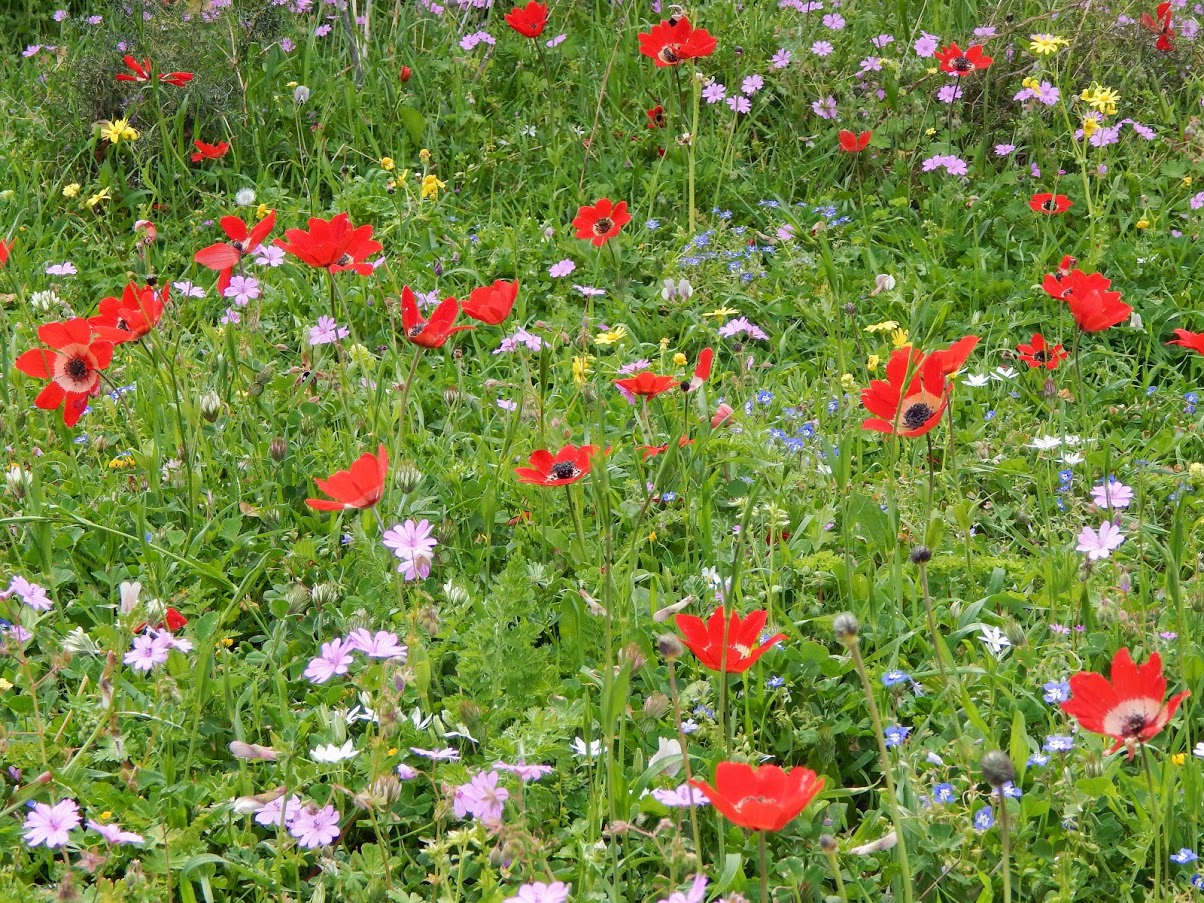
Friday 22 March
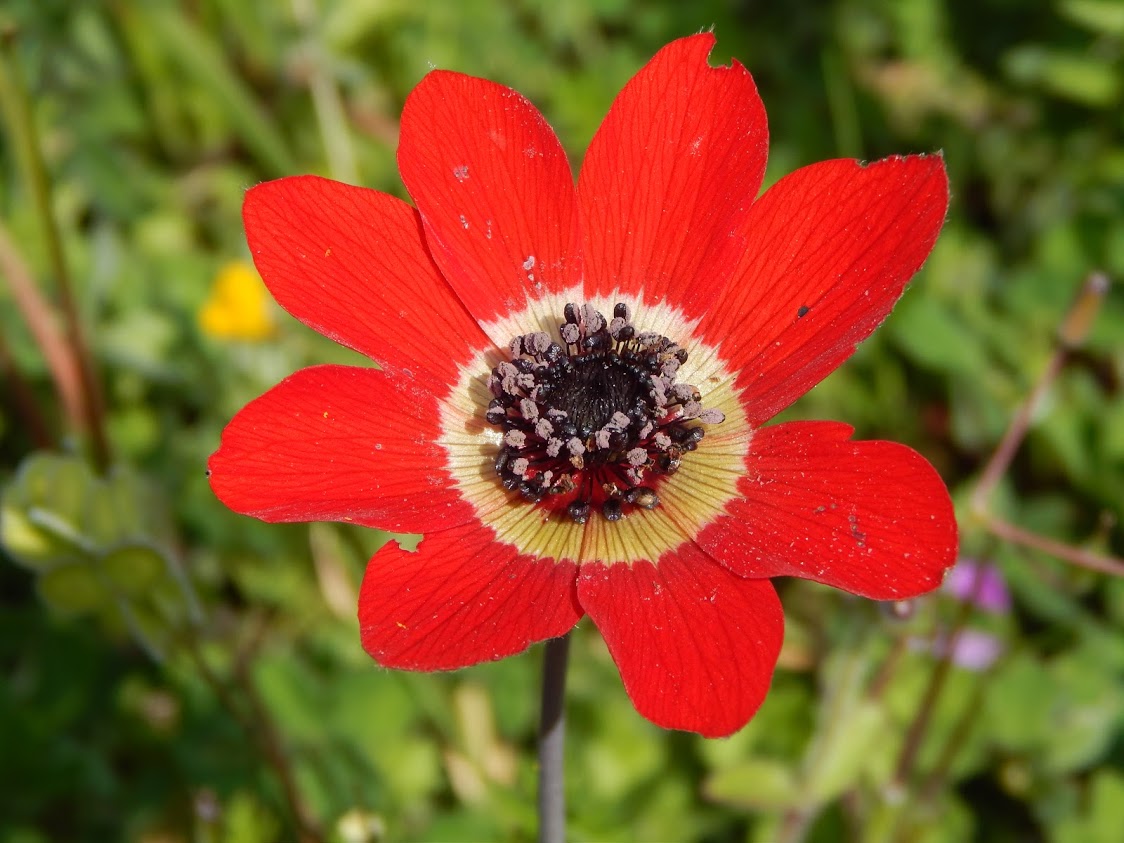
Anemone hortensis subsp. pavonina
After breakfast we headed off to the archaeological site of Mystras, with only one brief diversion as it was realised we’d forgotten one participant! After backtracking to the hotel, we were off to Mystras.
Along the road we saw masses of the striking Anenome hortensis subsp. pavonina, which was also abundant at our destination, and indeed throughout most of the trip. The vivid red flowers are highly reminiscent of poppy.
The beautiful ruins of Mystras are a Unesco World Heritage Site, and for good reason. We were all stunned by the incredible Byzantine architecture, amazing views, and of course the flora. Most of the group followed John Fielding up to the top of the ruins, which were in a much more advanced state of disrepair than the lower section.
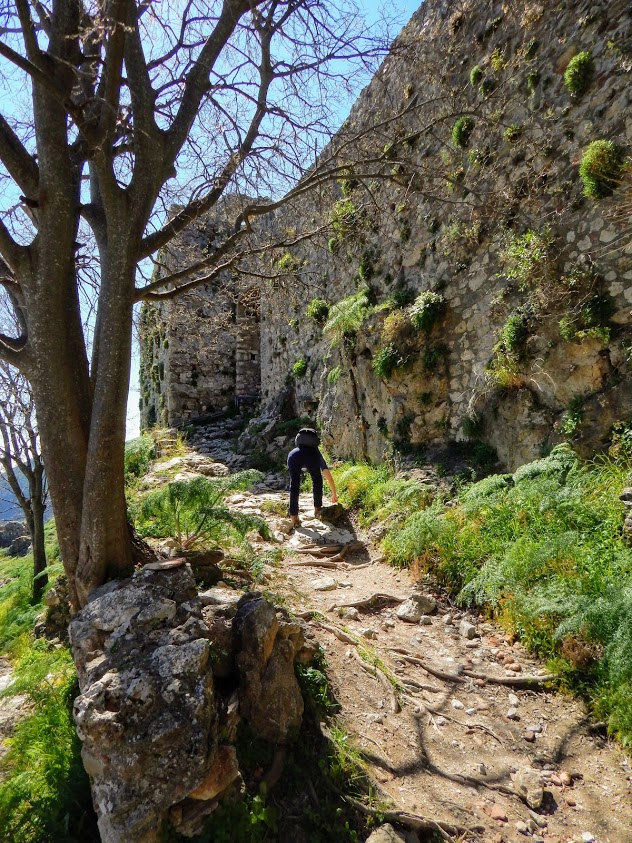
Plant clad ruins, Mystras
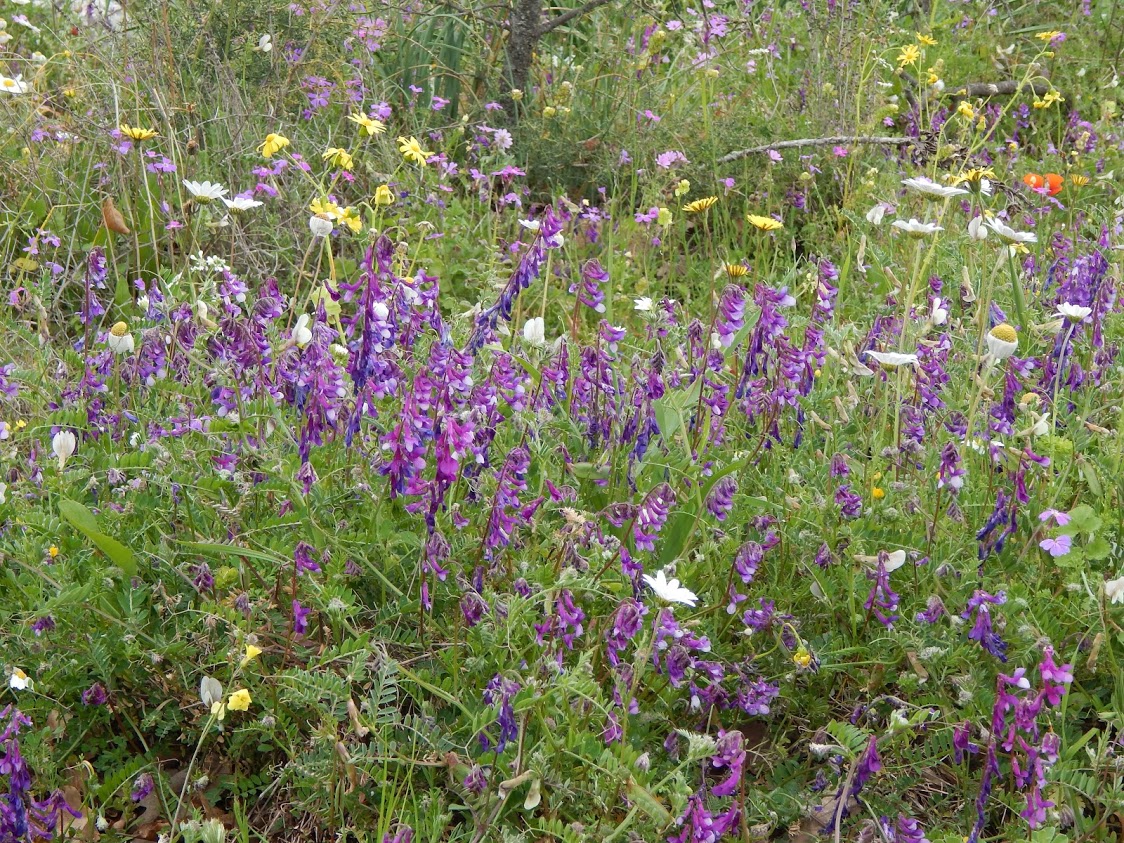
Vicia villosa
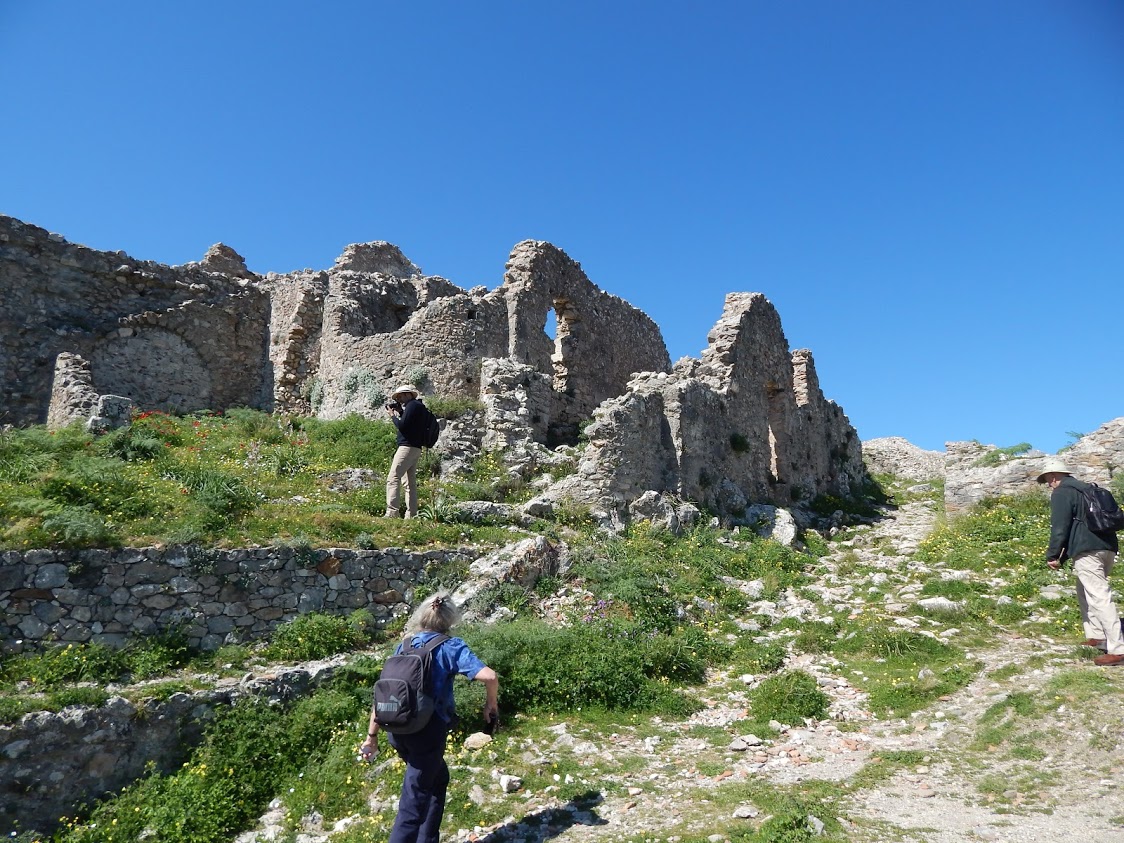
Higher levels, Mystras
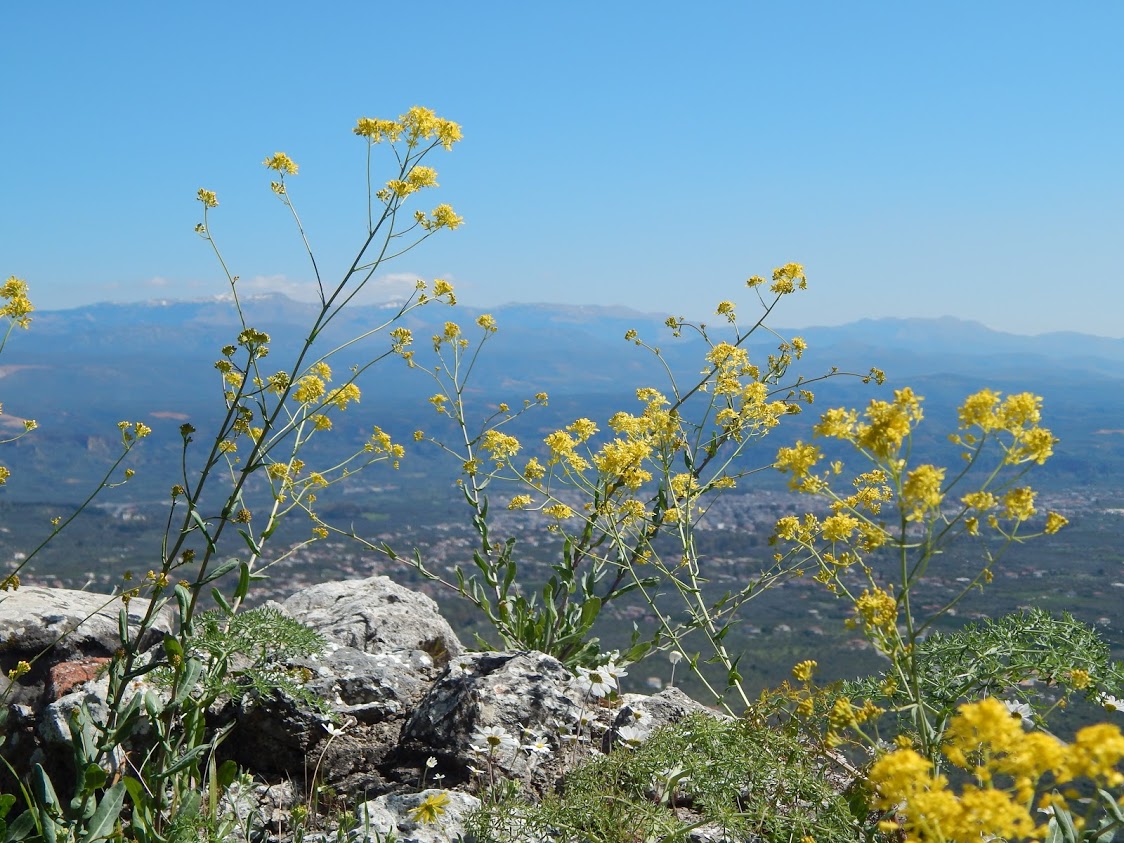
Isatis tinctoria (Dyer’s woad), overlooking Sparti
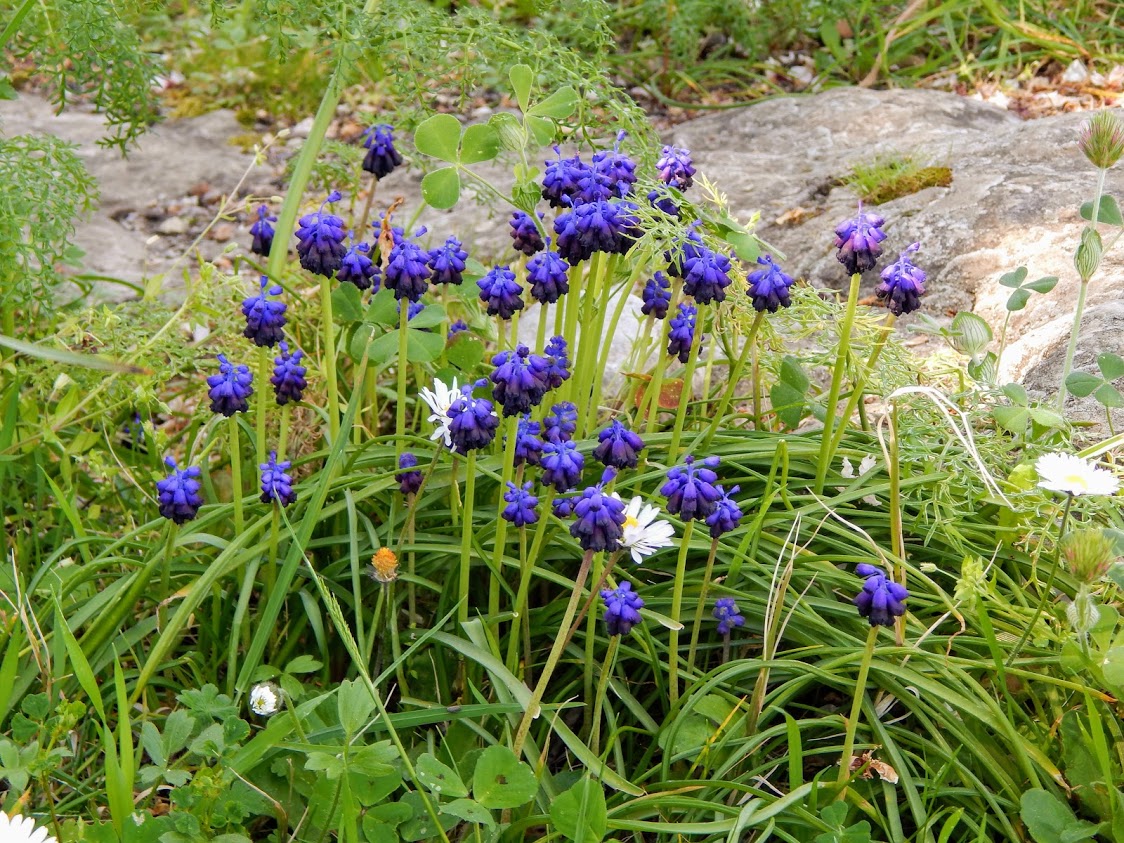
Muscari commutatum
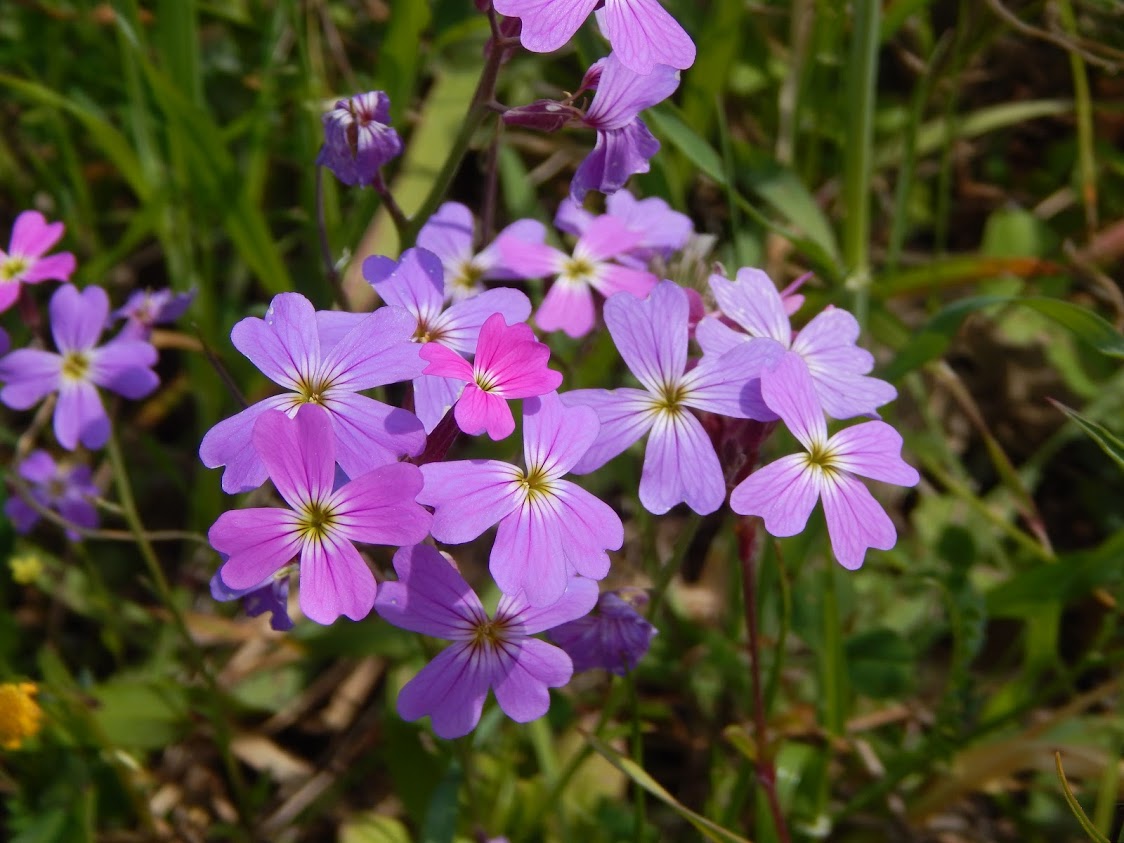
Lunaria annua subsp. pachyrhiza
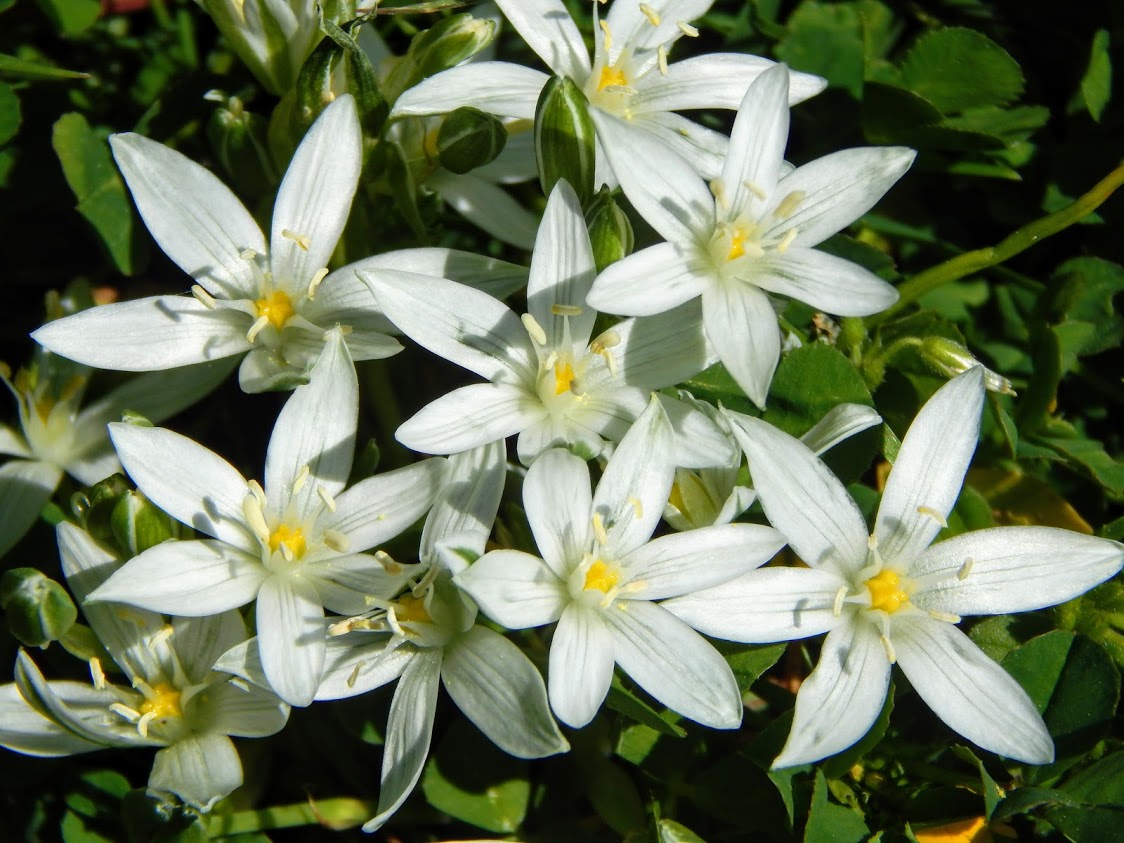
Ornithogalum sp. (likely divergens)
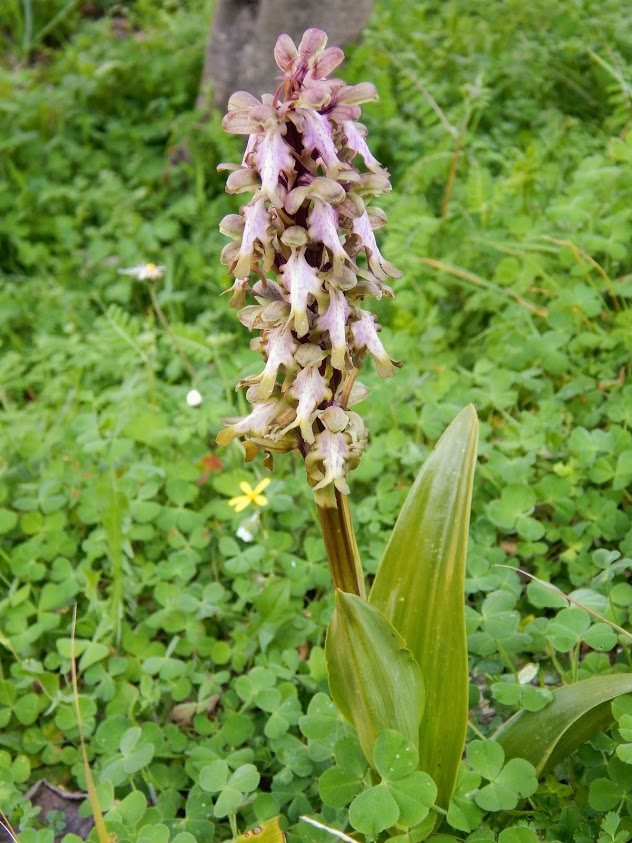
Himantoglossum robertianum
The trail up, and indeed the entire site, was carpeted with a number of annuals and biennials such as wild honesty Lunaria annua subsp. pachyrhiza (which several participants remarked was prettier than their cultivated variety), dyers woad Isatis tinctoria, and a vetch Vicia villosa. The bulbous plants Muscari commutatum and Ornithogalum sp. (probably O. divergens) were also abundant. The flowers of M. commutatum were notable for lacking a white edge, as most species have. We spotted a number of giant orchids Himantoglossum robertianum in full bloom – the first orchids of the trip! We saw many more throughout the week and I took care to photograph as many as possible – I find the variation in lip color, from a dull brown to bright purple, intriguing.
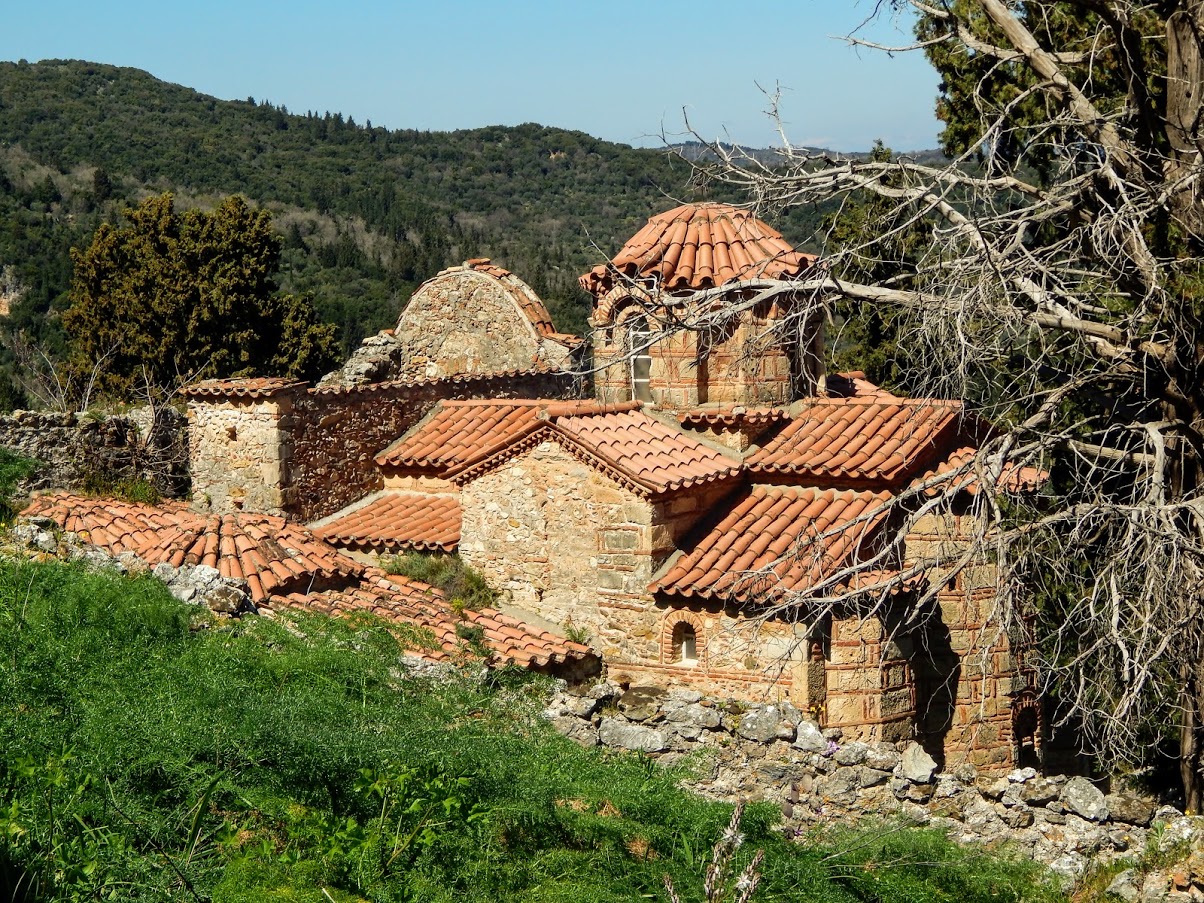
Byzantine architecture, Mystras
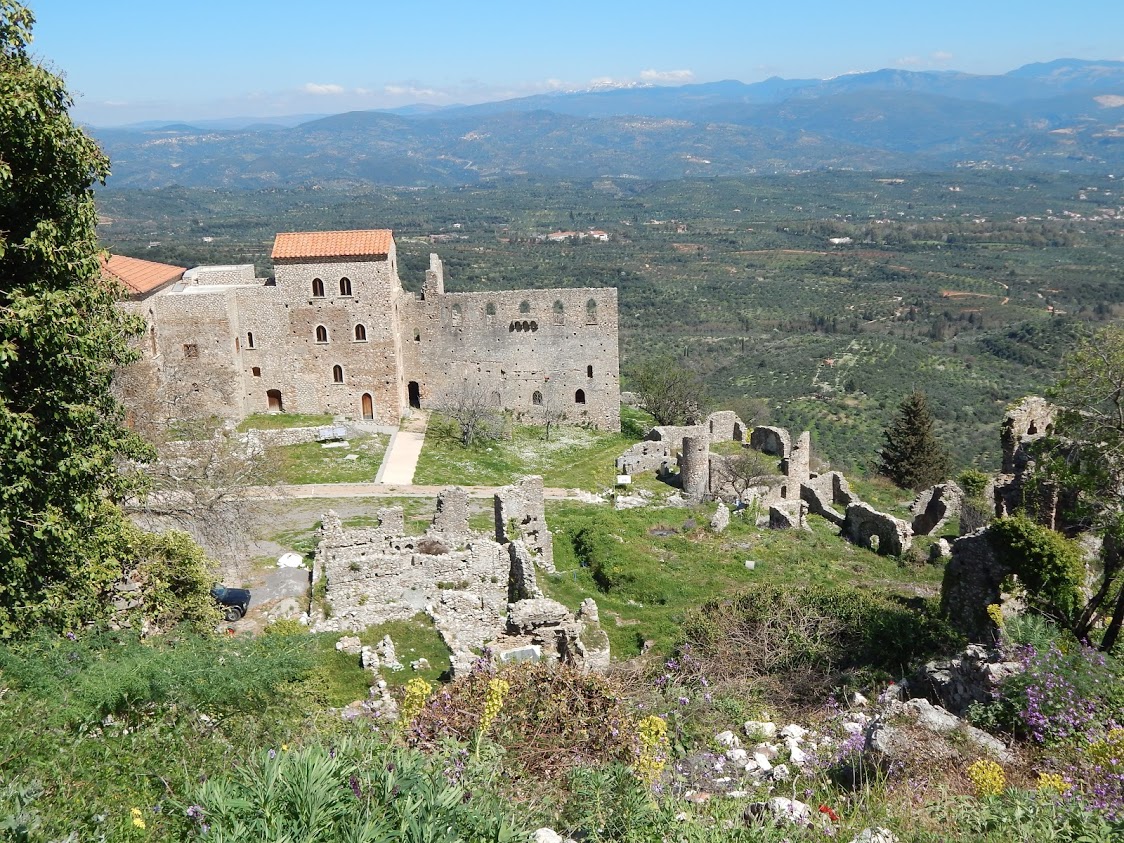
Several lovely fern species were seen growing in cracks in the stone walls of the ruins: rusty back fern Asplenium ceterach, Polypodium australe (just coming to the end of its period of winter growth), and Cheilanthes acrostica. This, normally moisture loving group of plants, might seem out of place in the Mediterranean, but the key to these species’ success is the habitation of damp microclimates, especially shady crevices of north facing cliffs. It wasn’t only ferns which adorned the stone walls.
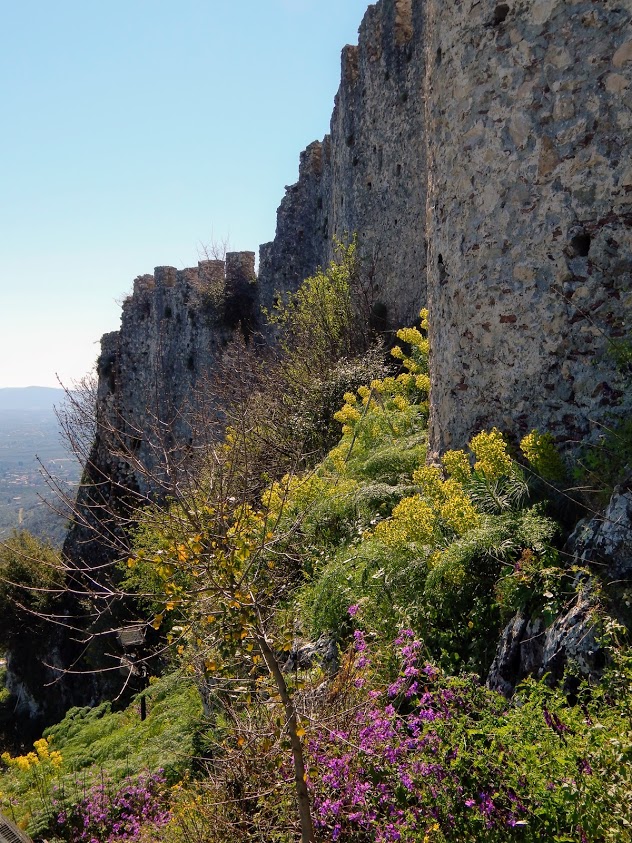
Mystras
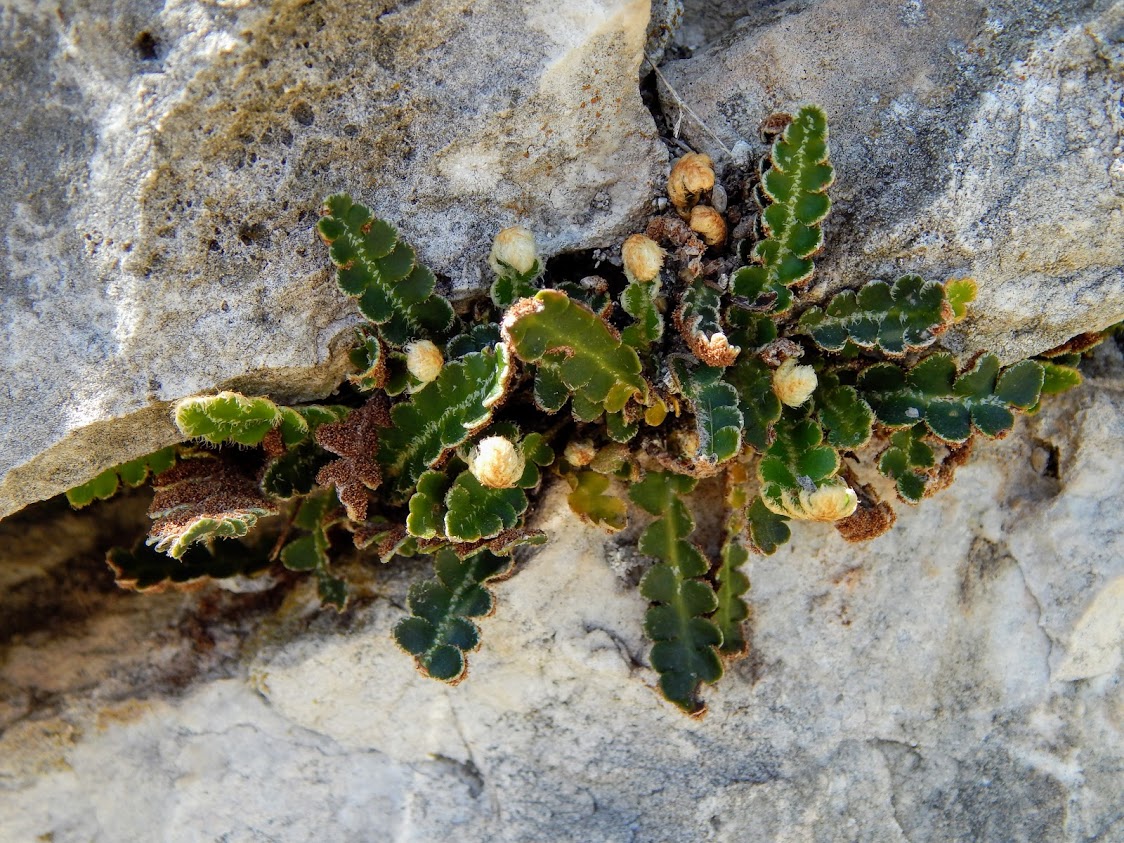
Rusty back fern, Asplenium ceterach
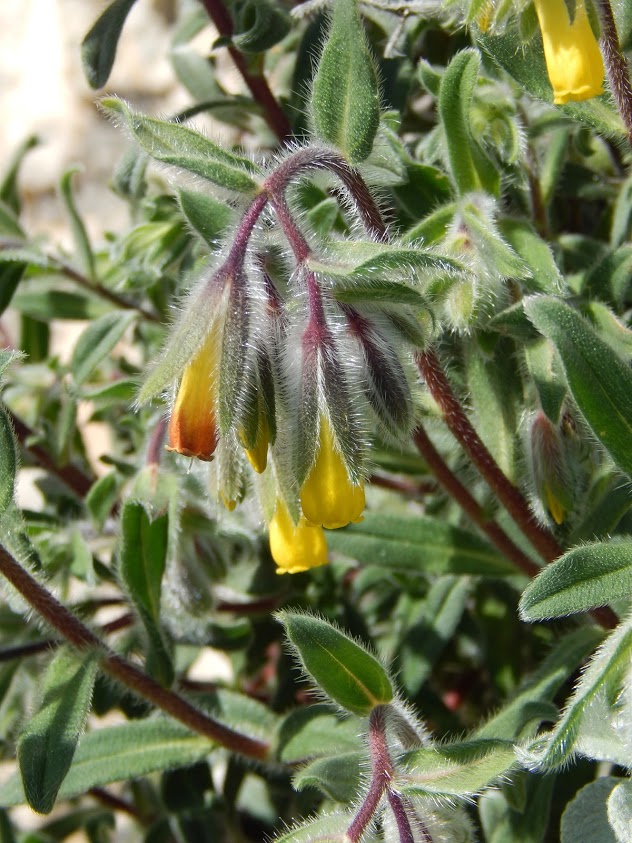
Onosma frutescens
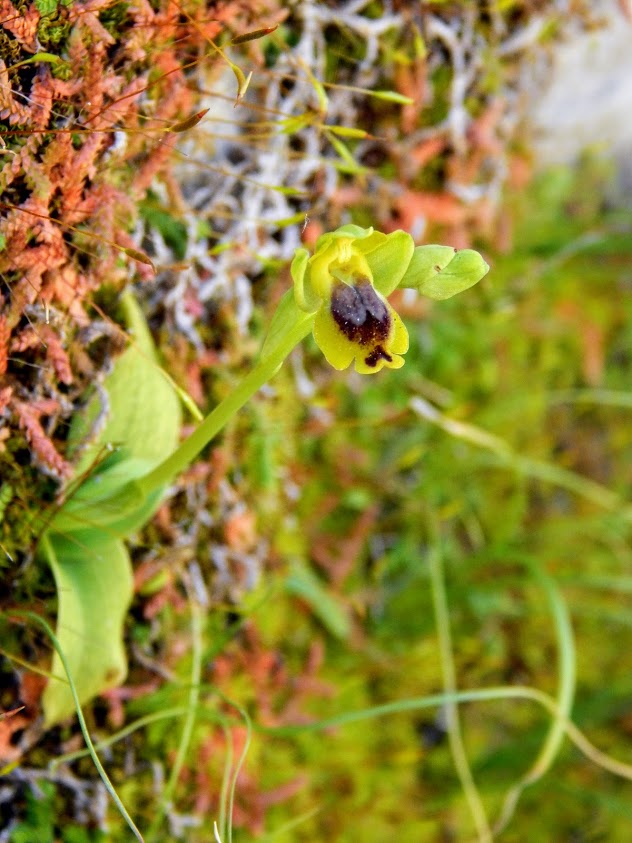
Ophrys sicula
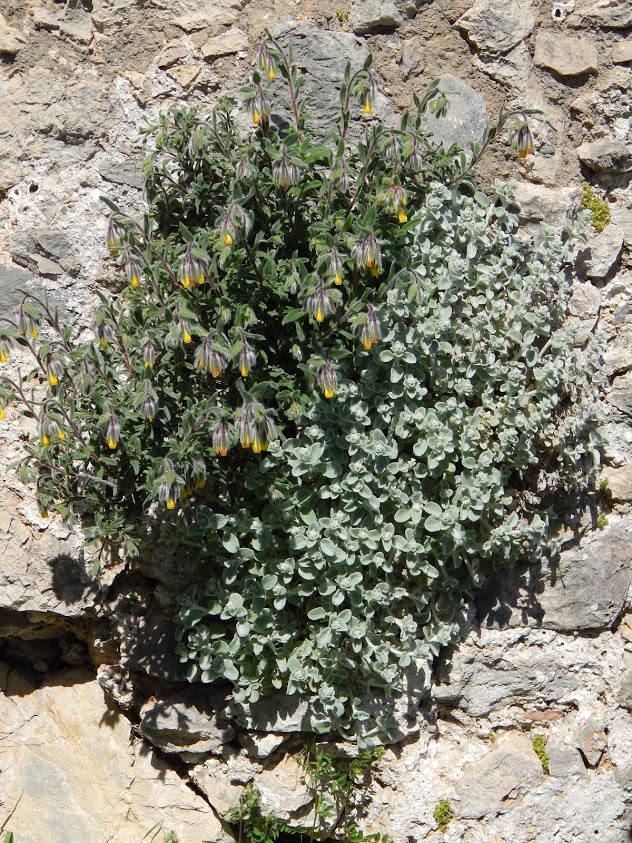
Onosma frutescens and Stachys candida (r)
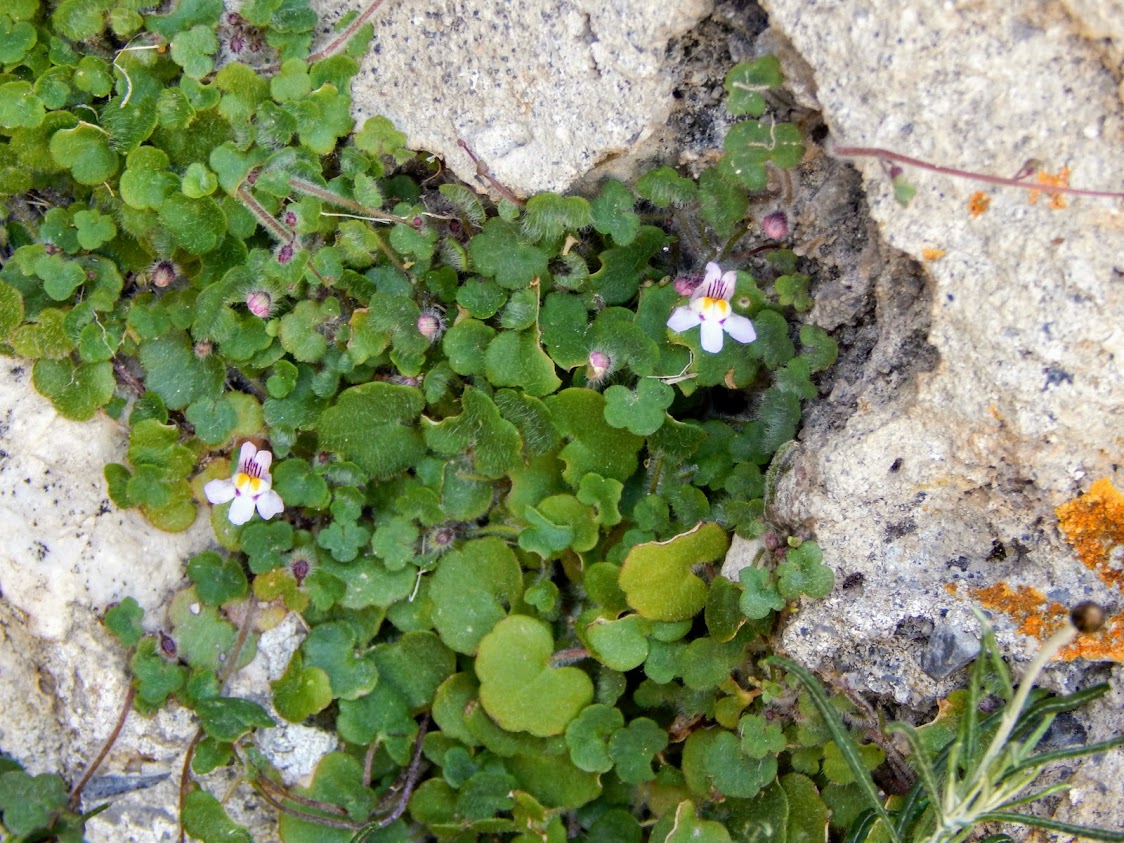
Cymbalaria microcalyx
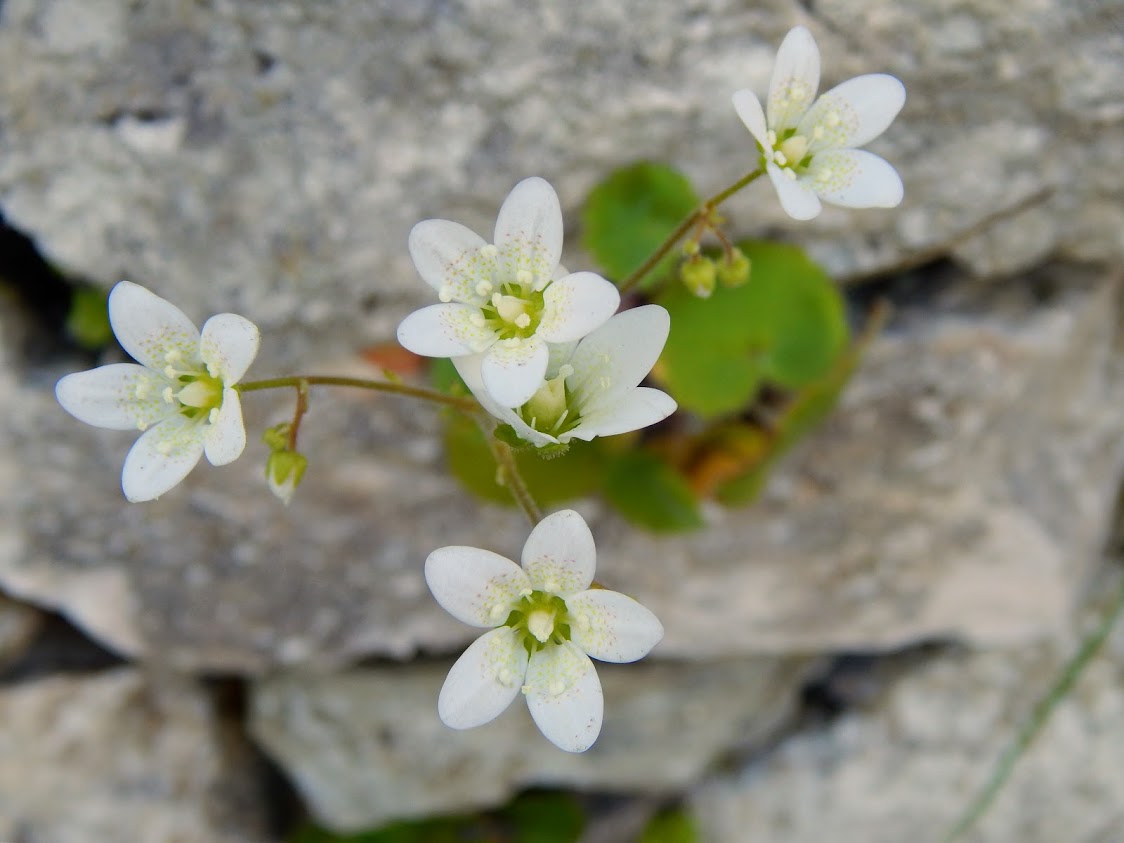
Saxifraga rotundifolia subsp. chrysopleniifolia
I, along with several others, decided we hadn’t had enough when it came time to board the bus, and stayed a bit longer to admire Mystras. Others made their way to a local olive oil museum or back to the hotel for well deserved rest. I eventually took the public bus back to Mystras, after spotting several interesting lizards and more chasmophytic plants.
Saturday 23 March
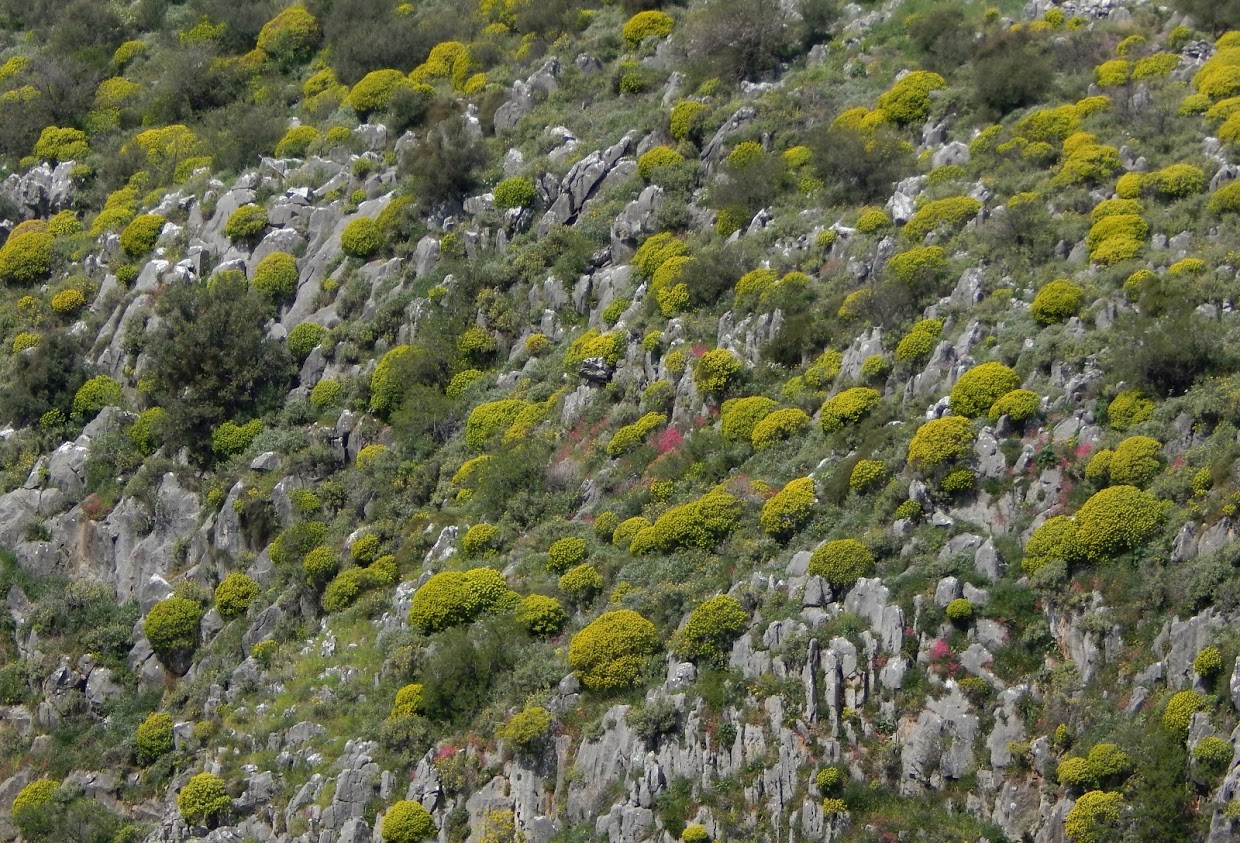
Phrygana habitat
Today started with a drive through the Peloponnese countryside, with the landscape merging from agriculture to wilderness as we neared the coast. I’m sure John was asked a dozen times to identify the prominent lime green shrubs that dotted the hillsides – Euphorbia dendroides. This Euphorbia is a hallmark of the important Mediterranean phrygana ecosystem, which consists of low growing shrubs that can withstand summer drought, usually occurring near the coast and on alkaline (limestone) soils. Other characteristic phrygana plants which were admired throughout the trip were Phlomis fruticosa, Euphorbia acanthothamnos, and several Cistus species– we were fortunate enough to be visiting during the flowering season of all of these species.
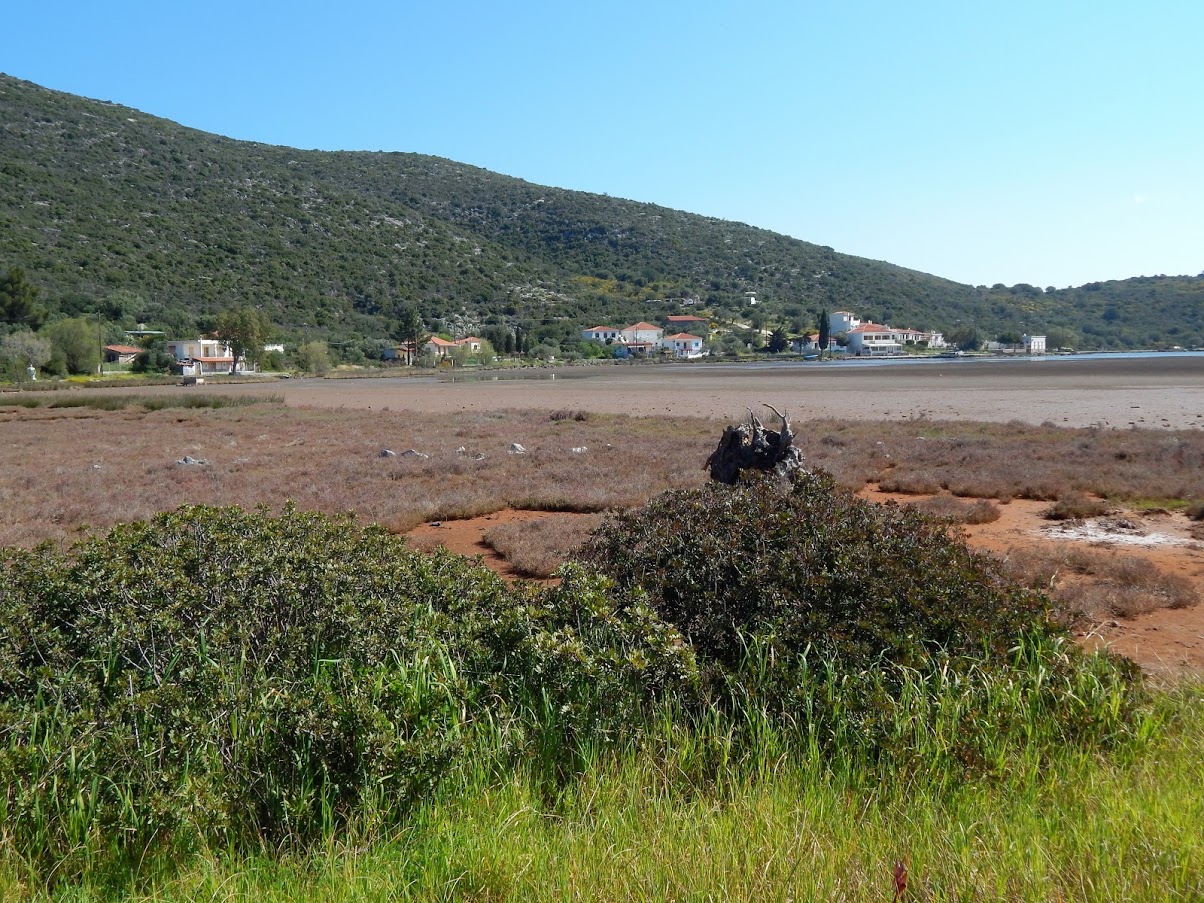
Mud flats, village Limin Gerakas
Our first site gave a taste of coastal vegetation on the edge of the mud flats in a tidal estuary, just outside the village of Limin Gerakas.
Serapias orientalis stood proud among the grass, the most obvious wildflower but not the only one. Tiny Romulea ramiflora could also be found, and the dwarf iris Moraea sisyrinchium which had sadly not yet opened for the day (although we were to see fully emerged flowers at the next stop). Right on the edge of tidal influence the halophytic Sarcocornia fruticosa dominated – very few species can tolerate such high levels of salt.
We soon moved on to a quick coffee break in a local taverna, fueling for the next stop.
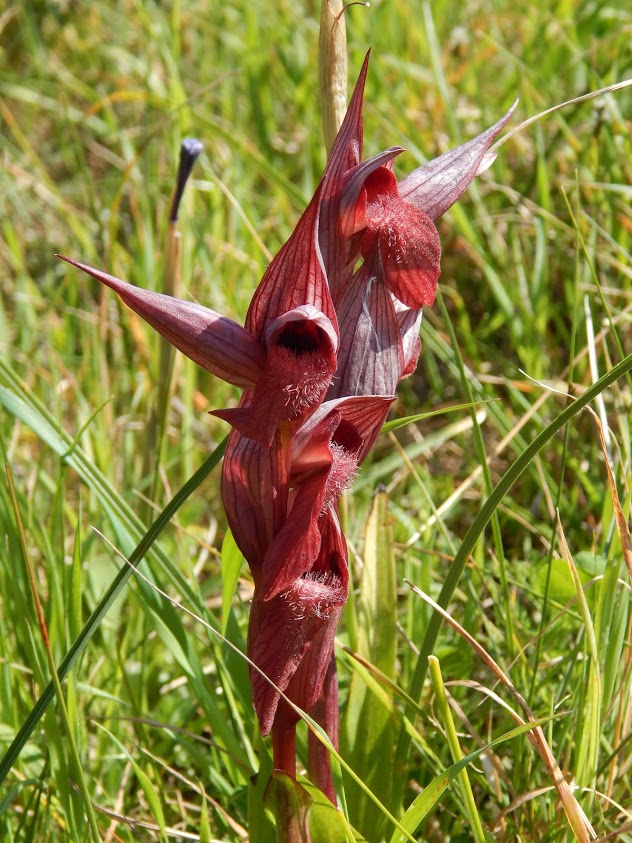
Serapias orientalis
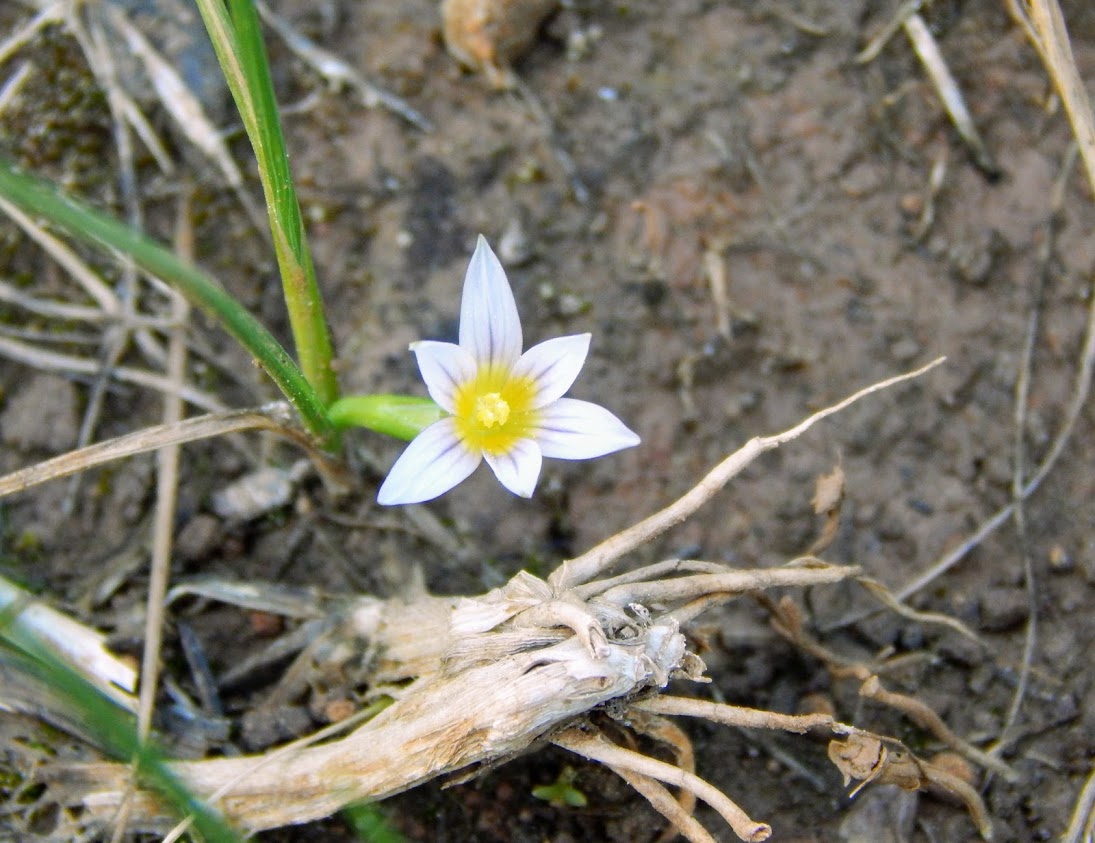
Romulea ramiflora
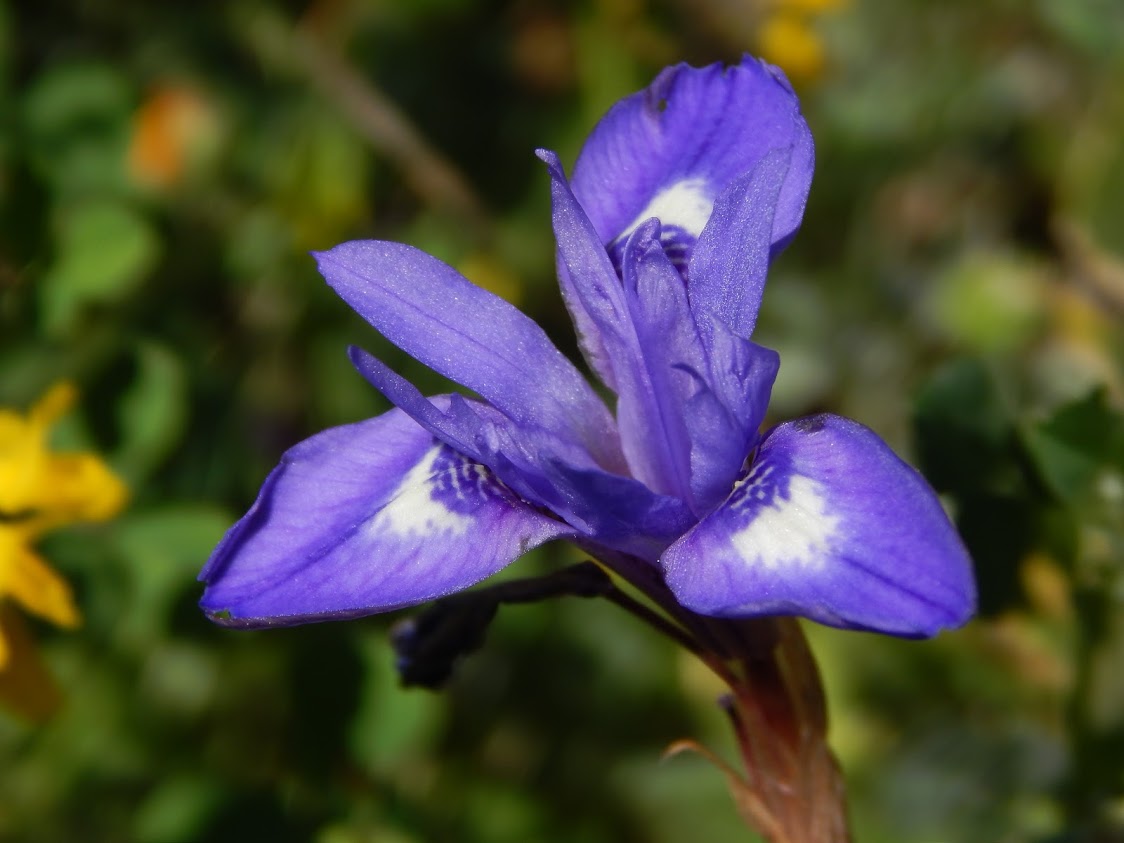
Dwarf iris Moraea sisyrinchium
Continuing through the village, we proceeded to a botanically rich trail along a ridge towards the ruins of Zarax. On this delightfully wild path we found the second and third Ophrys species of the trip, Ophrys spruneri and Ophrys argolica. These two species look very similar but O. argolica has a slightly rounder, lighter coloured lip with much smaller spots resembling eyes. A single flower of Cyclamen rhodium subsp. vividum was also discovered. Despite its name being a bit of a mouthful, the dark pink to red flower was certainly special.
Cyclamen hederifolium subsp. crassifolium was also noted, and while not in flower was still admired for its beautiful leaves. Once at the top of the hill we were rewarded with spectacular views of the eastern Laconia coast.
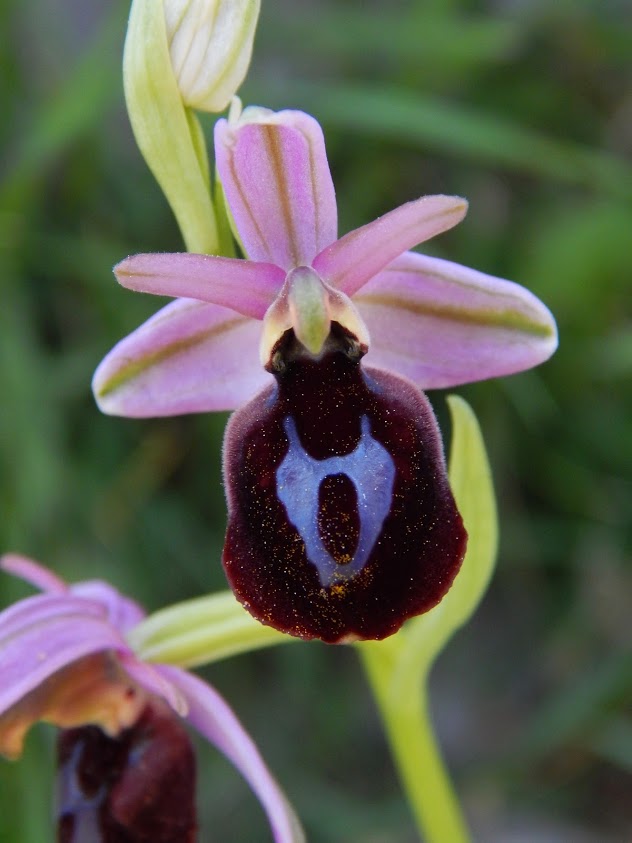
Ophrys sicula
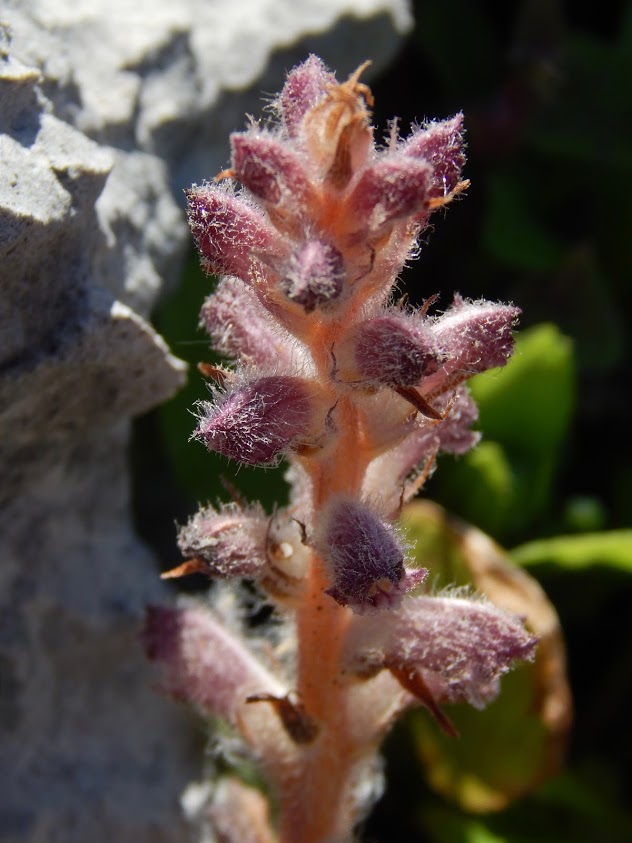
Orobanche pubescens
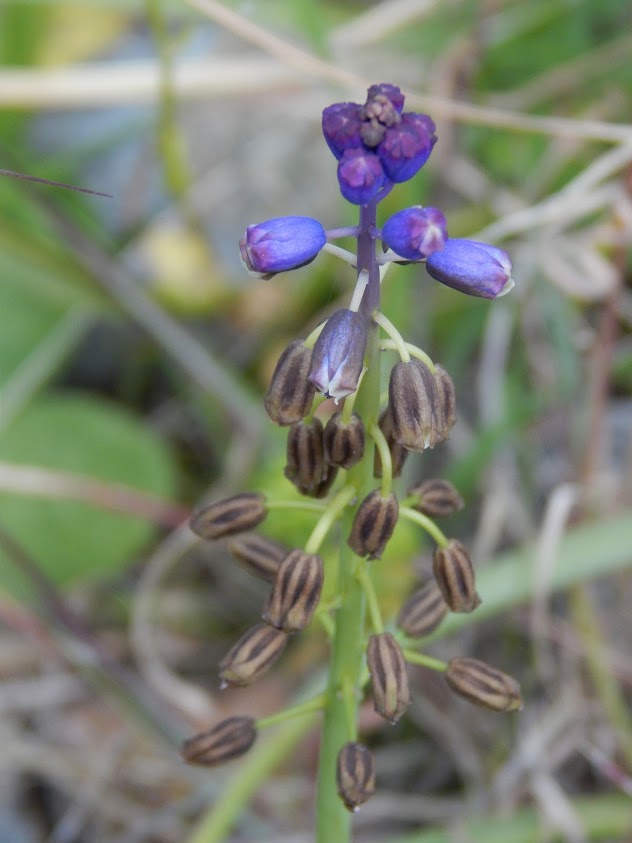
Bellavalia dubia
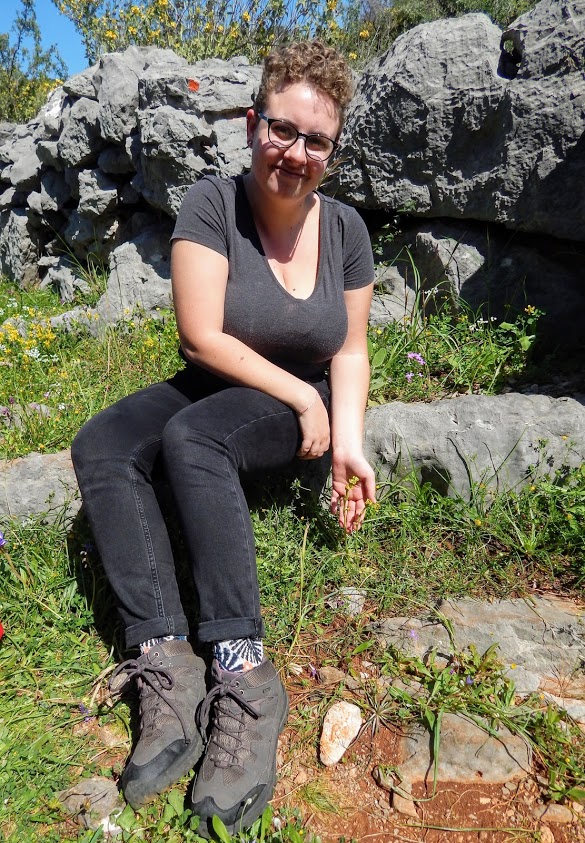
Vida Svahnstrom with Ophrys sicula
Despite the harsh conditions due to strong winds, several interesting plants were spotted, holding on among the stones. Several Orobanche pubescens were found in various stages of bloom. The specific epithet pubescens was rather fitting – the reddish flower stalks were covered with hair. This plant is entirely dependent on the host plants on which it parasitises, usually members of Asteraceae or Apiaceae.
On the way back down the path John pointed out the abundant Bellevalia dubia, which resembled a Muscari but with more spaced-out flowers along the inflorescence.
After this we had a calm lunch in the village before getting back on the coach.
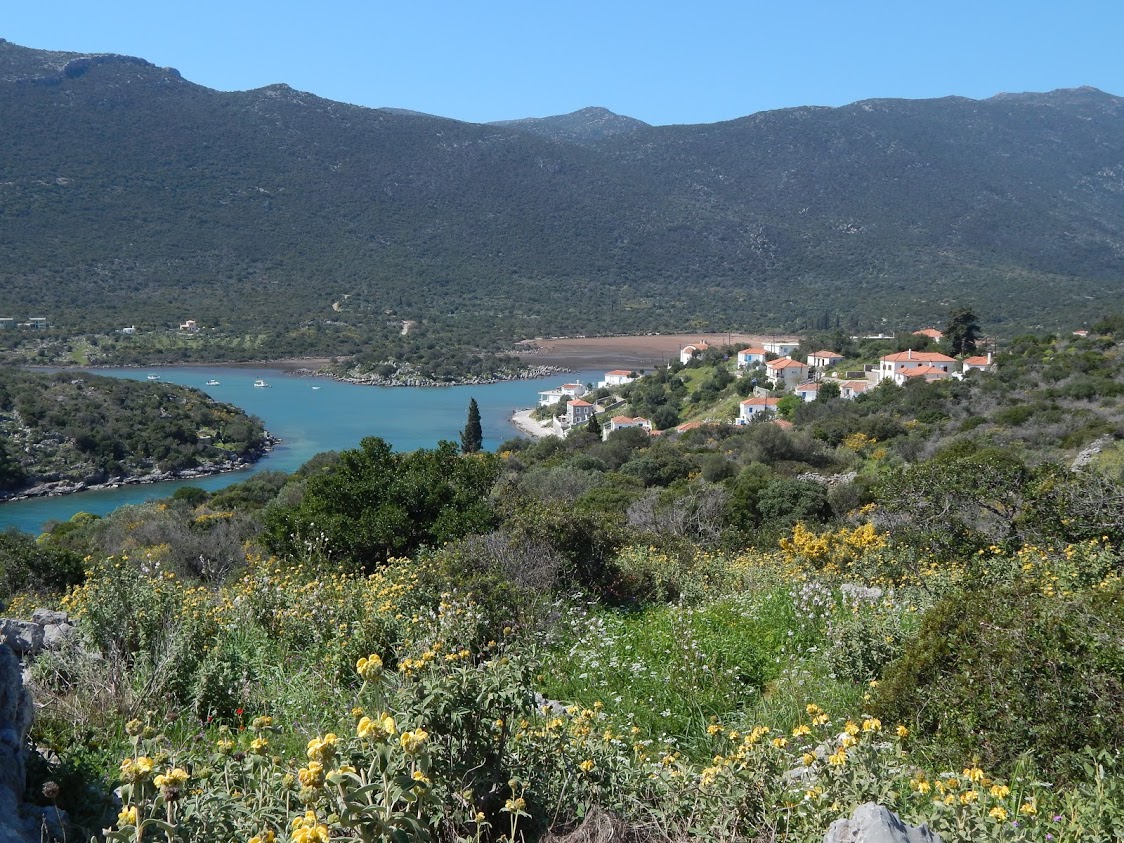
Path to Zarax view
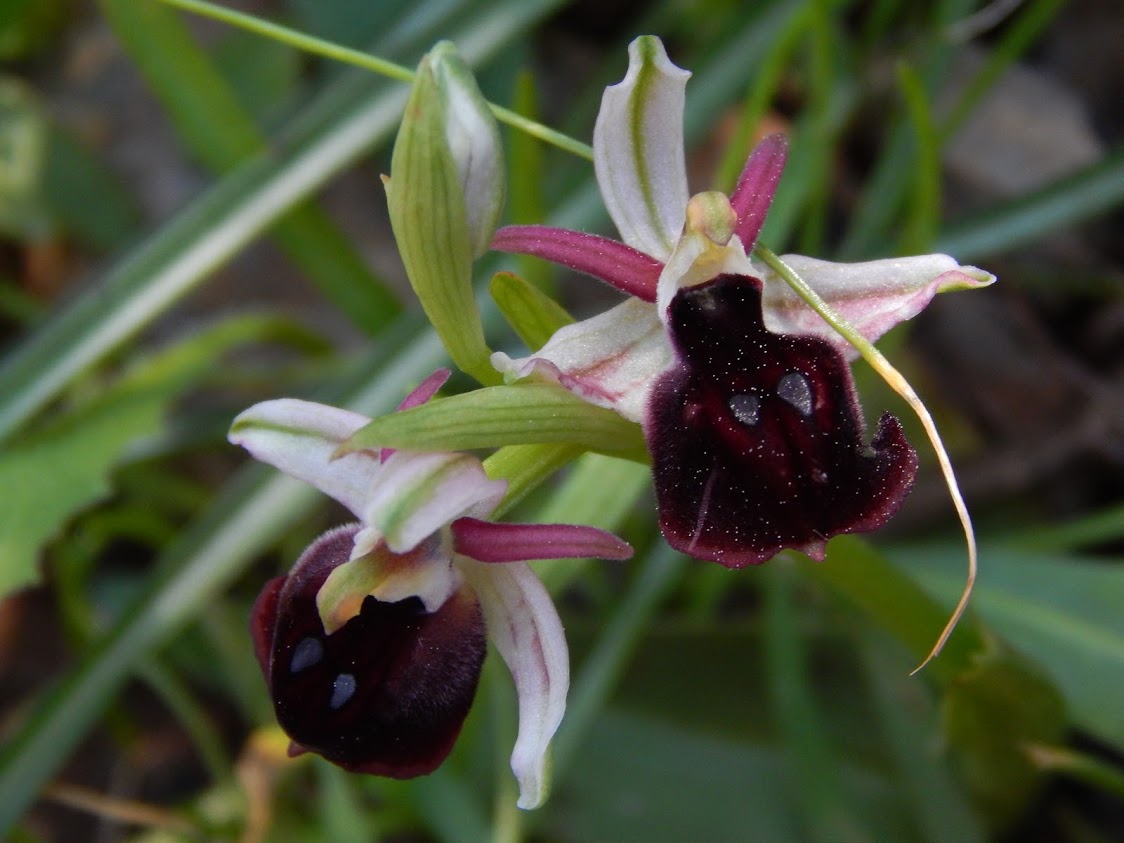
Ophrys argolica
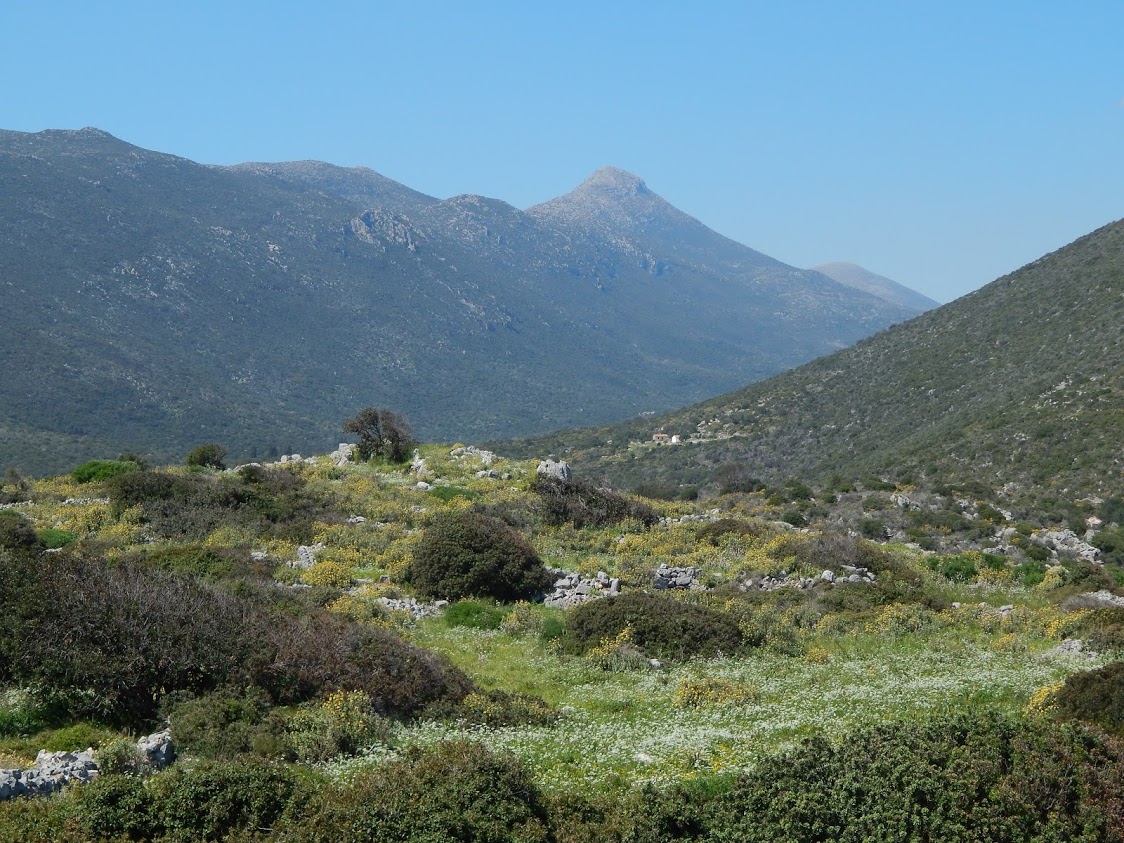
Spectacular Peloponnese landscape
On the way out of the village, heading towards the afternoon destination of Monemvasia, we made a quick roadside stop as John had spotted more Cyclamen rhodium subsp. vividum in bloom among the dense maquis shrubland. This habitat is characterized by slightly taller, denser growing shrubs than phrygana and as such has a slightly different floral assemblage. Quercus coccifera and Globularia alypum are two common maquis shrubs which we saw at this site, the latter of which had beautiful dense capitulum type flower heads. David found a very unique orchid at this stop – the mirror orchid Ophrys speculum. The lip of O. speculum stands out among the scrub – an iridescent blue centre is fringed by dense red-brown hair. Like most other Ophrys, this orchid is pollinated by sexual deception, but only attracts males of a single species of wasp. I took out my hand lens here and observed that all of the flowers seemed to have been pollinated which I found rather surprising due to its selectivity.
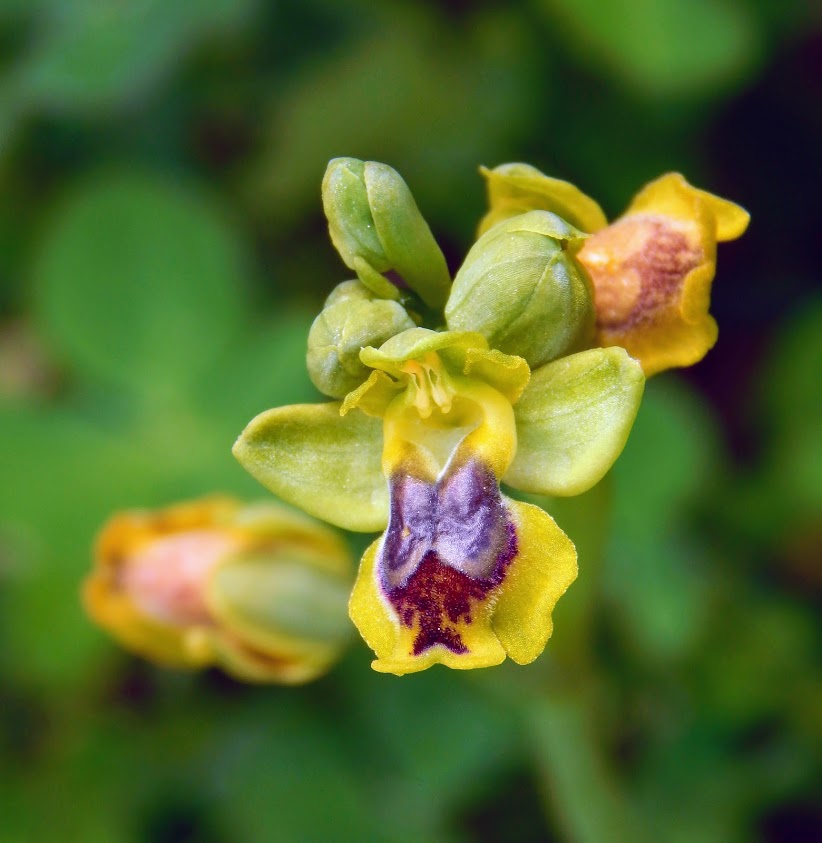
Ophrys sicula
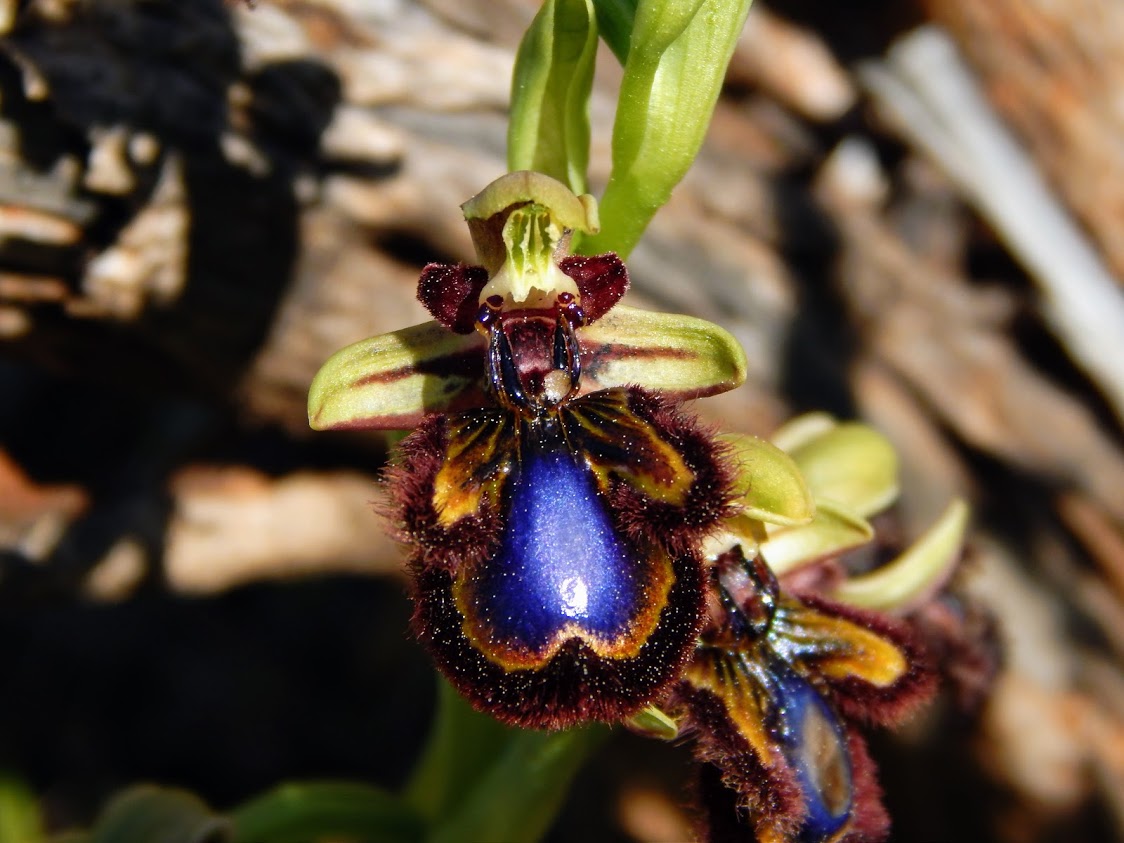
Ophrys speculum
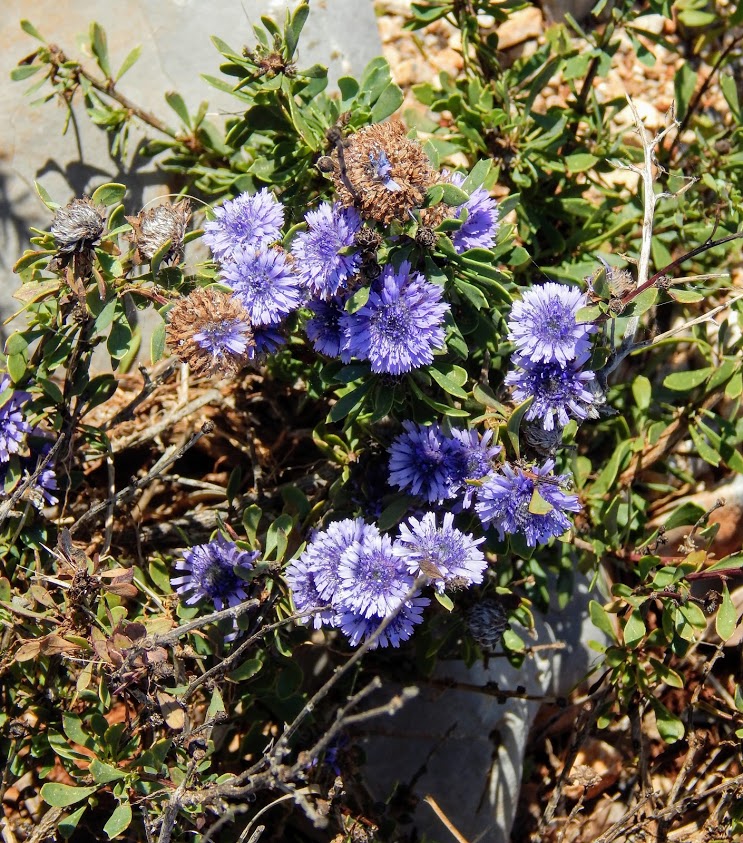
Globularia alypum
I, along with several others, decided to climb to the top of the plateau. As we made our way up, the buildings and churches perched on the cliff gradually transitioned from expertly restored to abandoned to finally, what could only be called ruins. At the top we were rewarded with spectacular views of the town of Monemvasia and beyond. Giant fennel Ferula communis was definitely the most striking plant at this site – the vast inflorescences extended from the cliffs, filling the blue sky with umbels of yellow flowers. There were also massive stands of the annual Cerinthe retorta. The dark purple bracts with tubular, yellow flowers emerging from within, arranged in a hooked shape, made for a rather unusual and eye-catching look.
After a long day we had a relaxed dinner at the hotel, and I headed up to my room a bit early to look at my photos from the day.
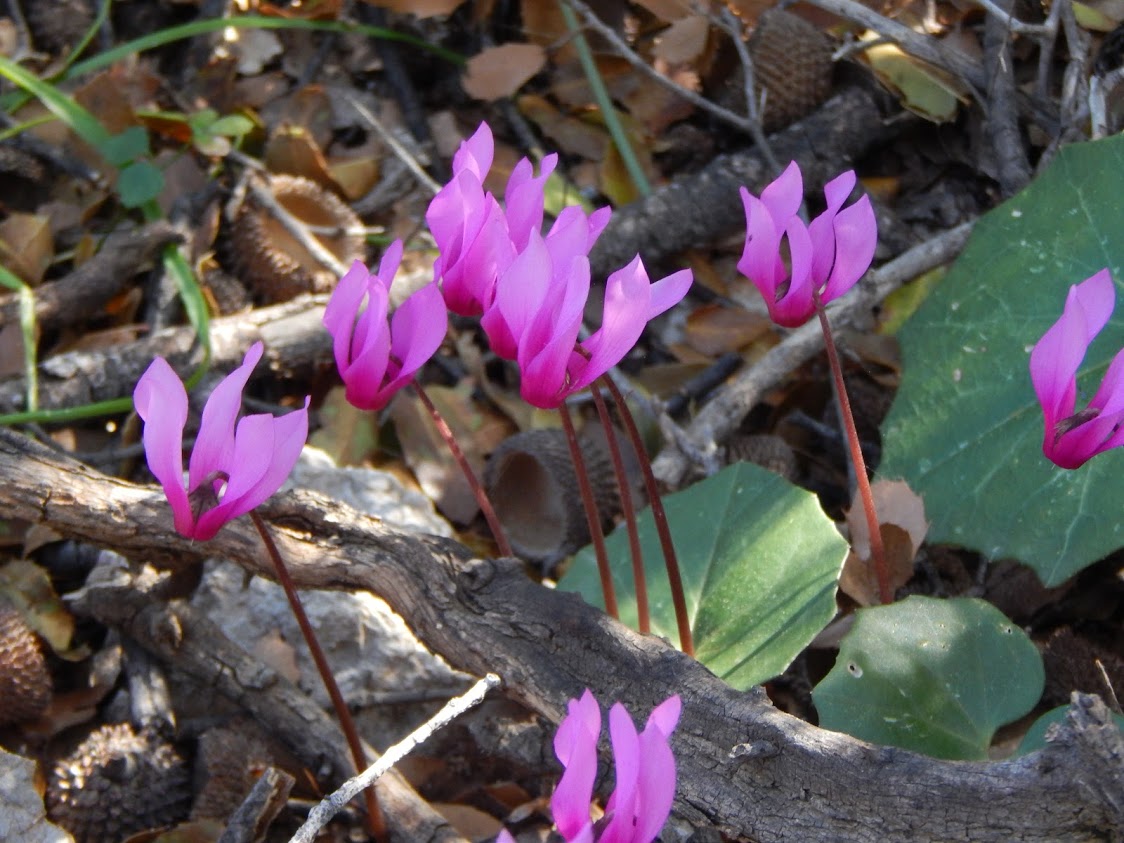
Cyclamen rhodium subsp. vividum
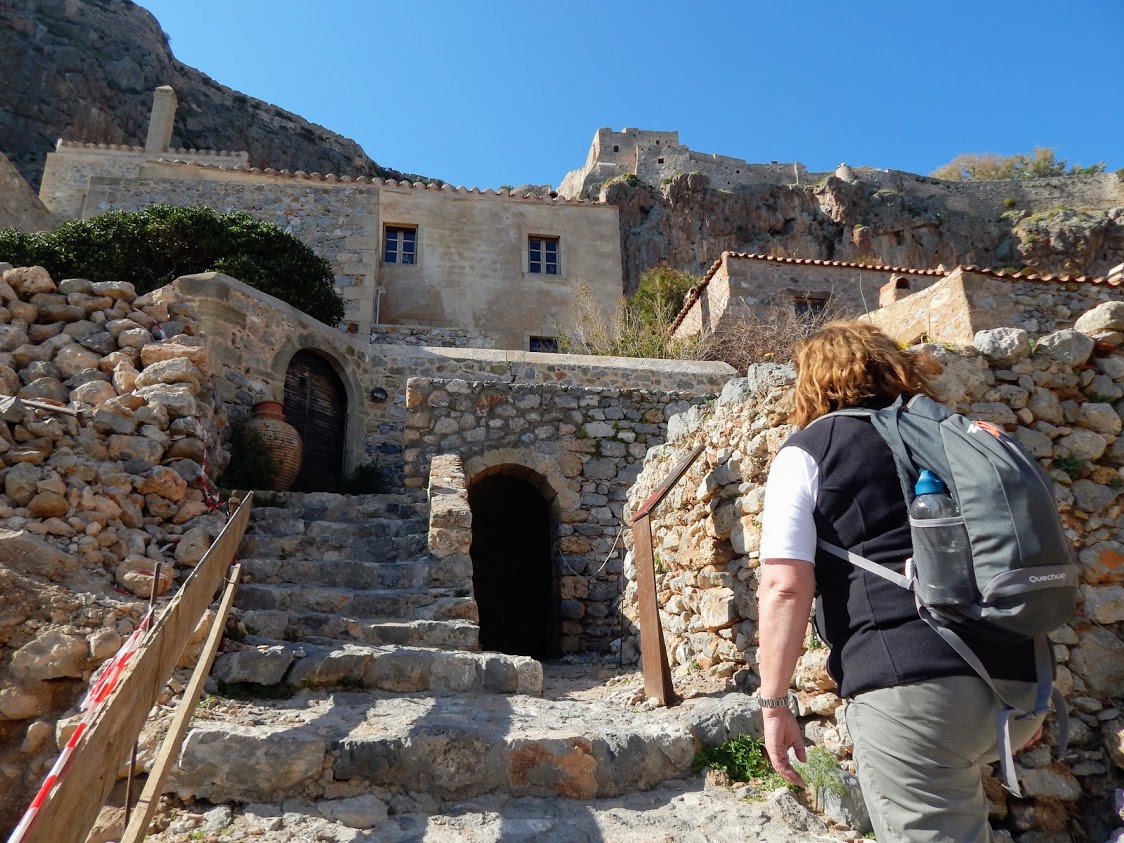
Up to wildflower site at Monemvasia
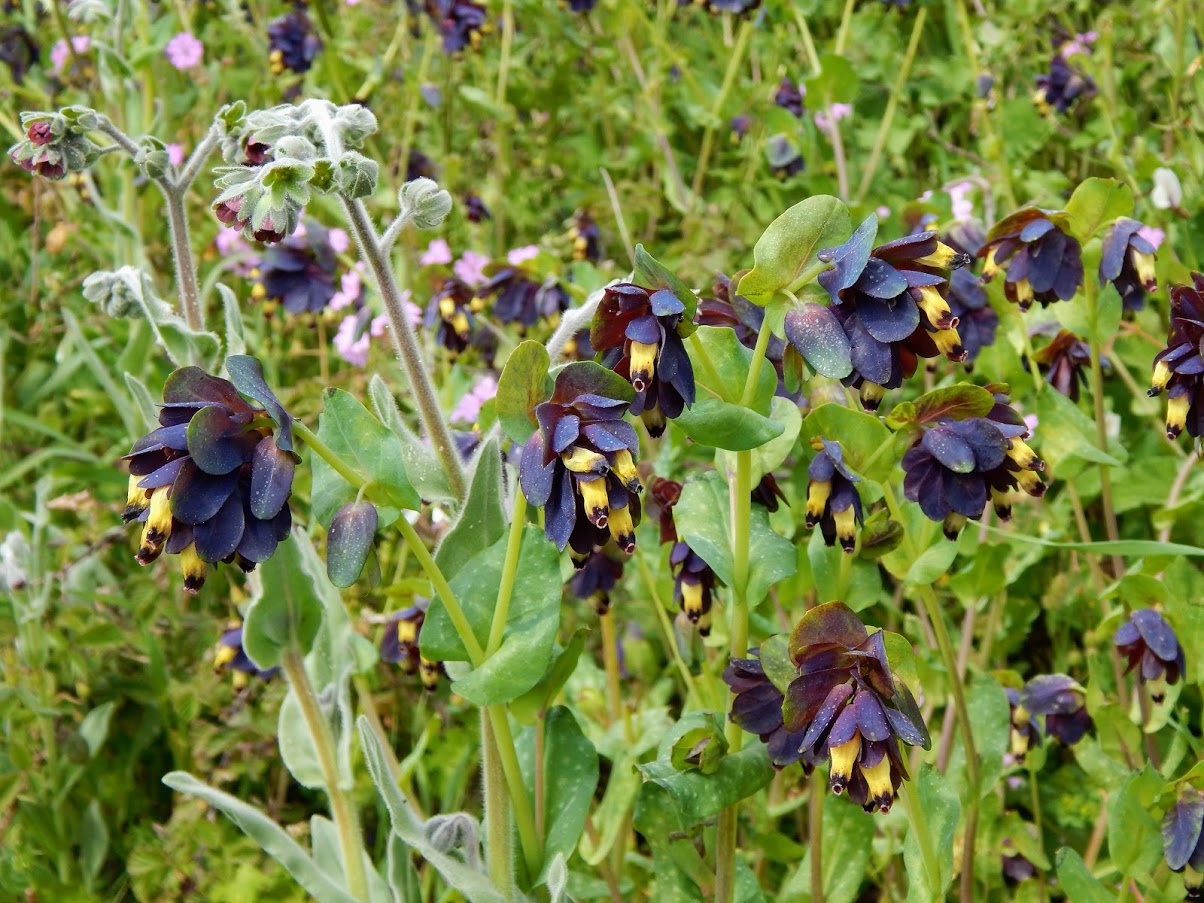
Cerinthe retorta
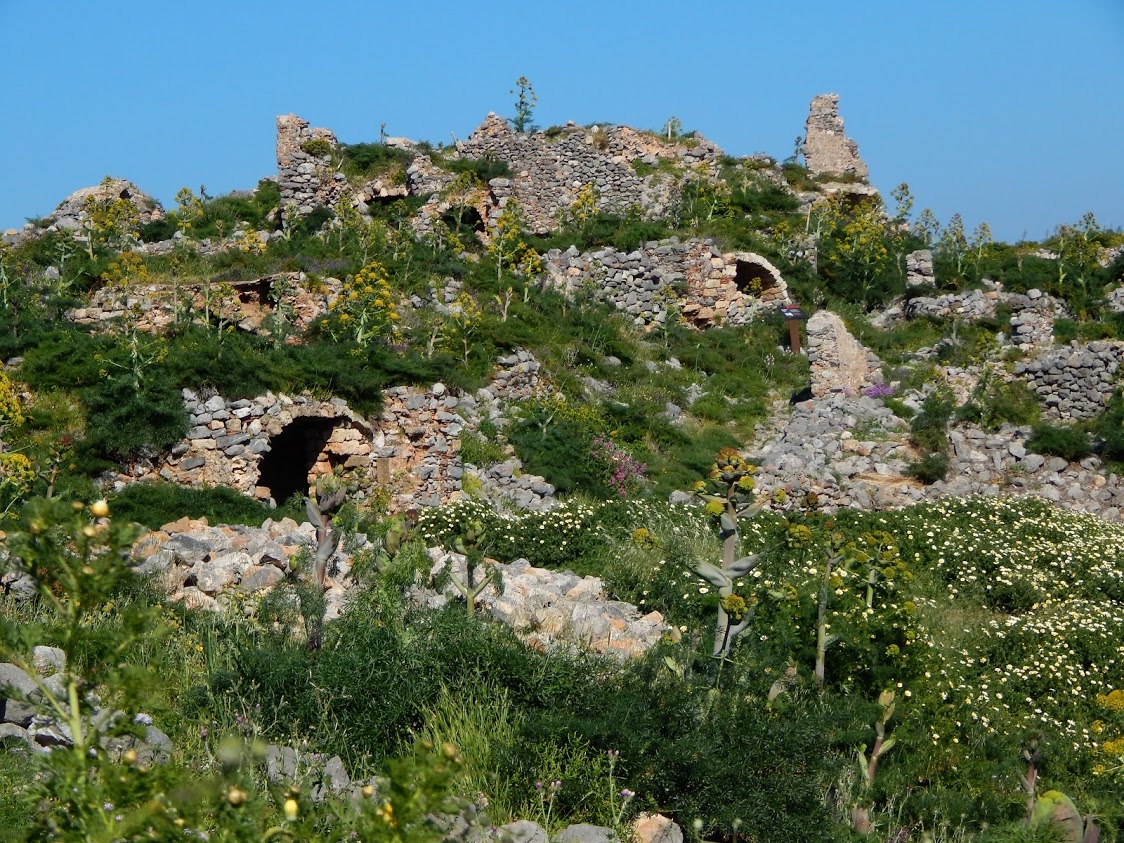
Ruins above Monemvasia
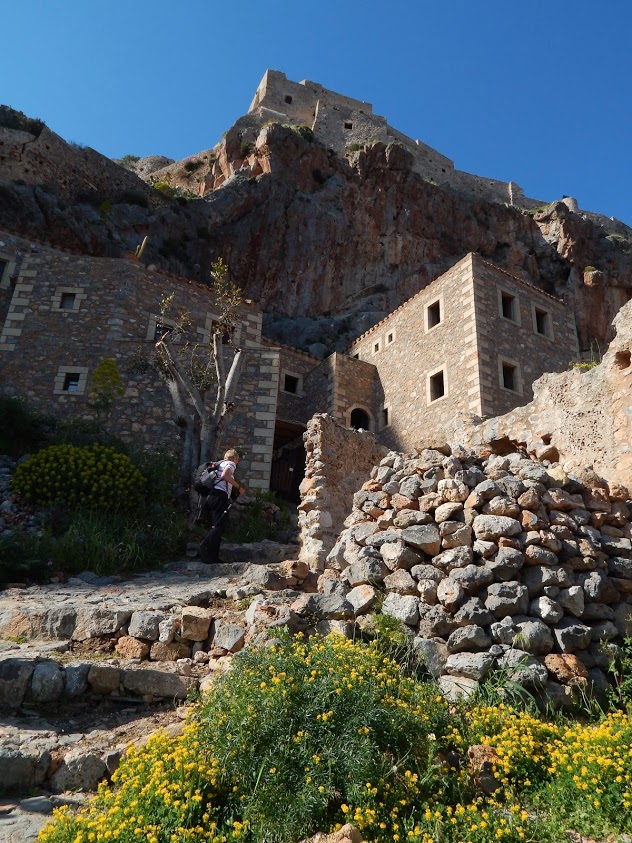
Monemvasia
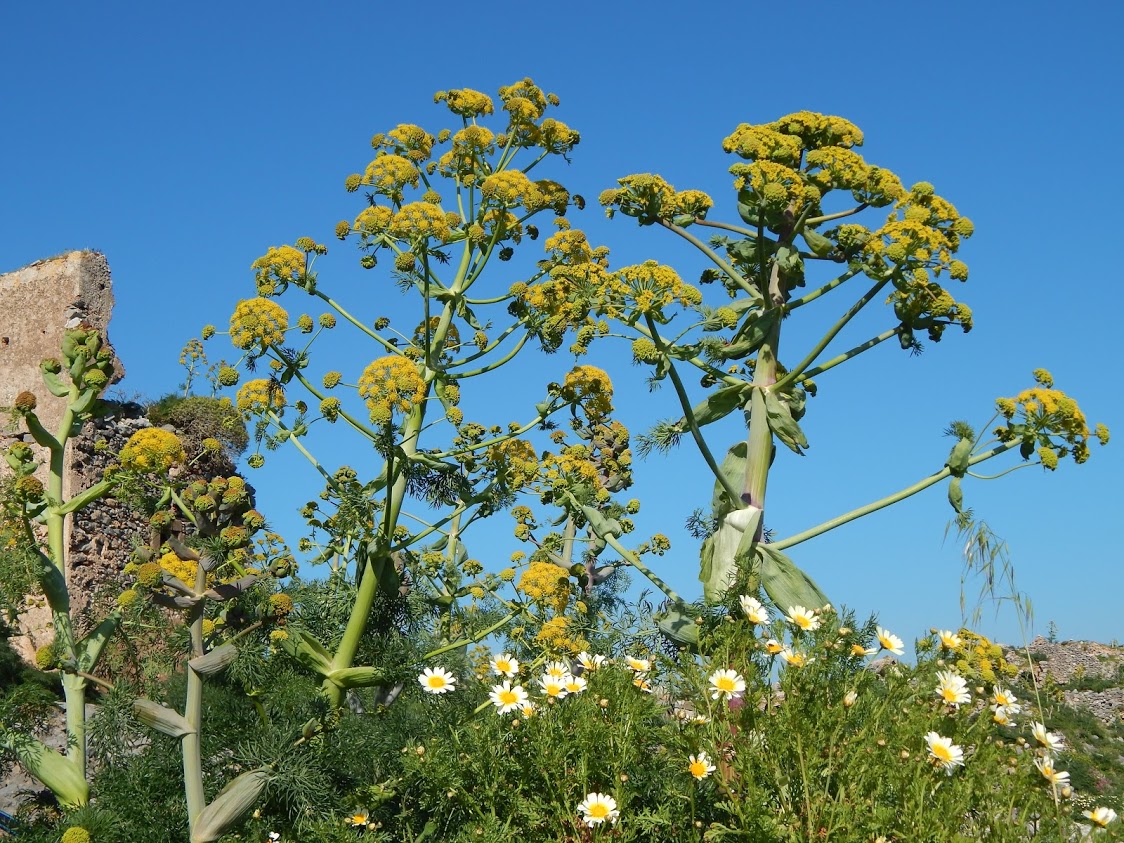
Ferula communis
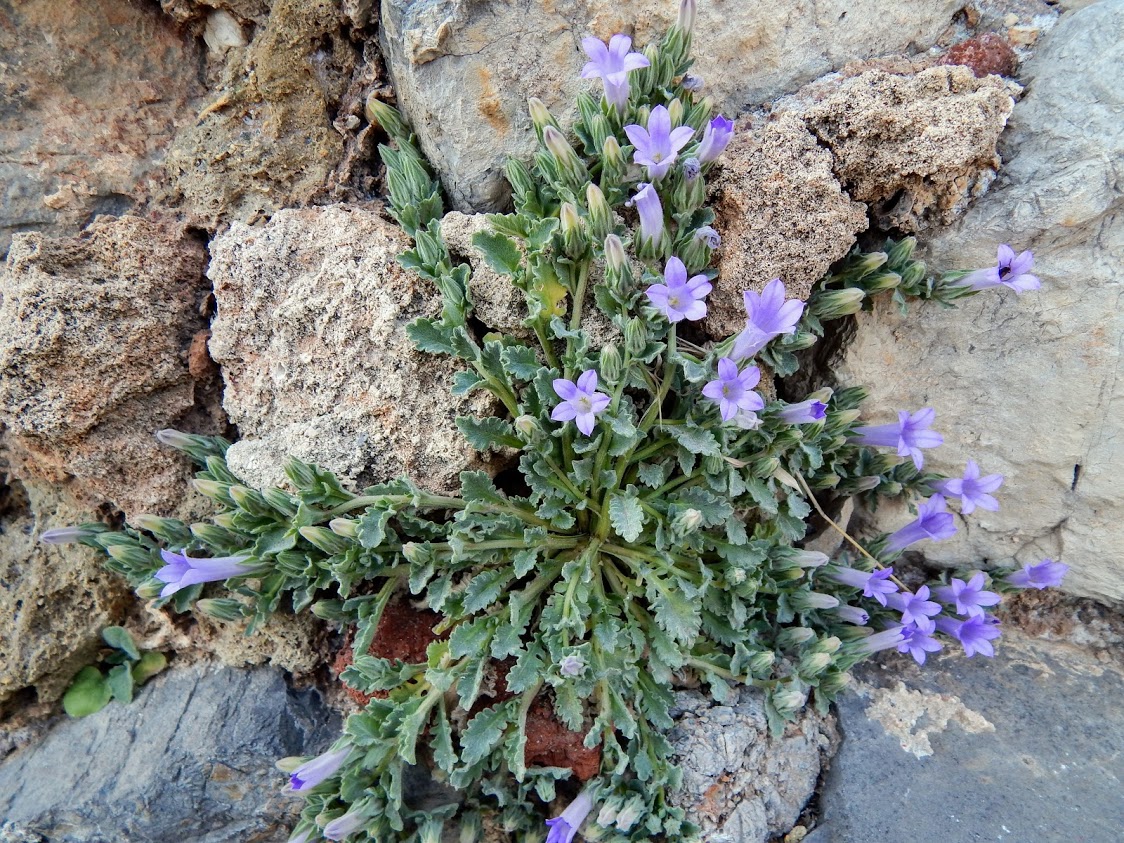
Campanula sp. Monemvasia
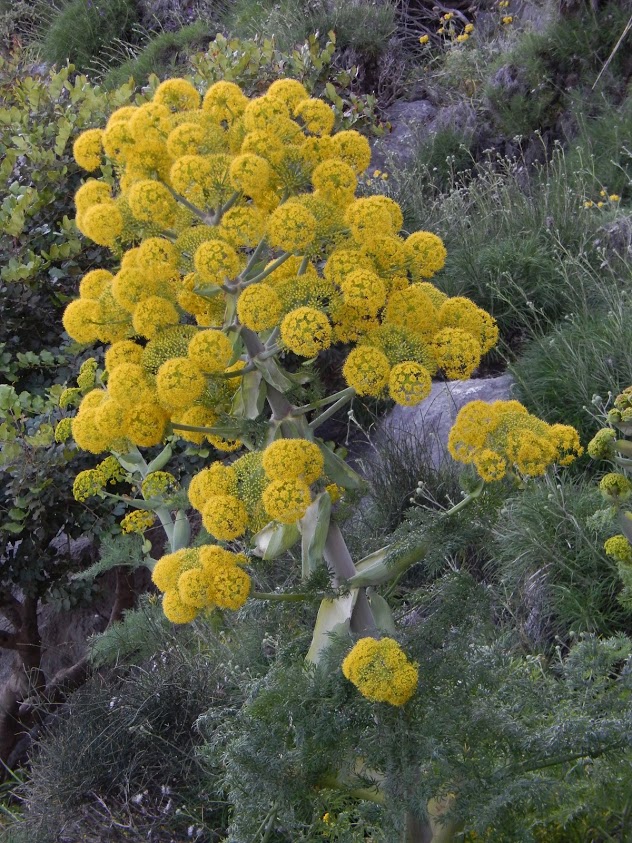
Ferula communis
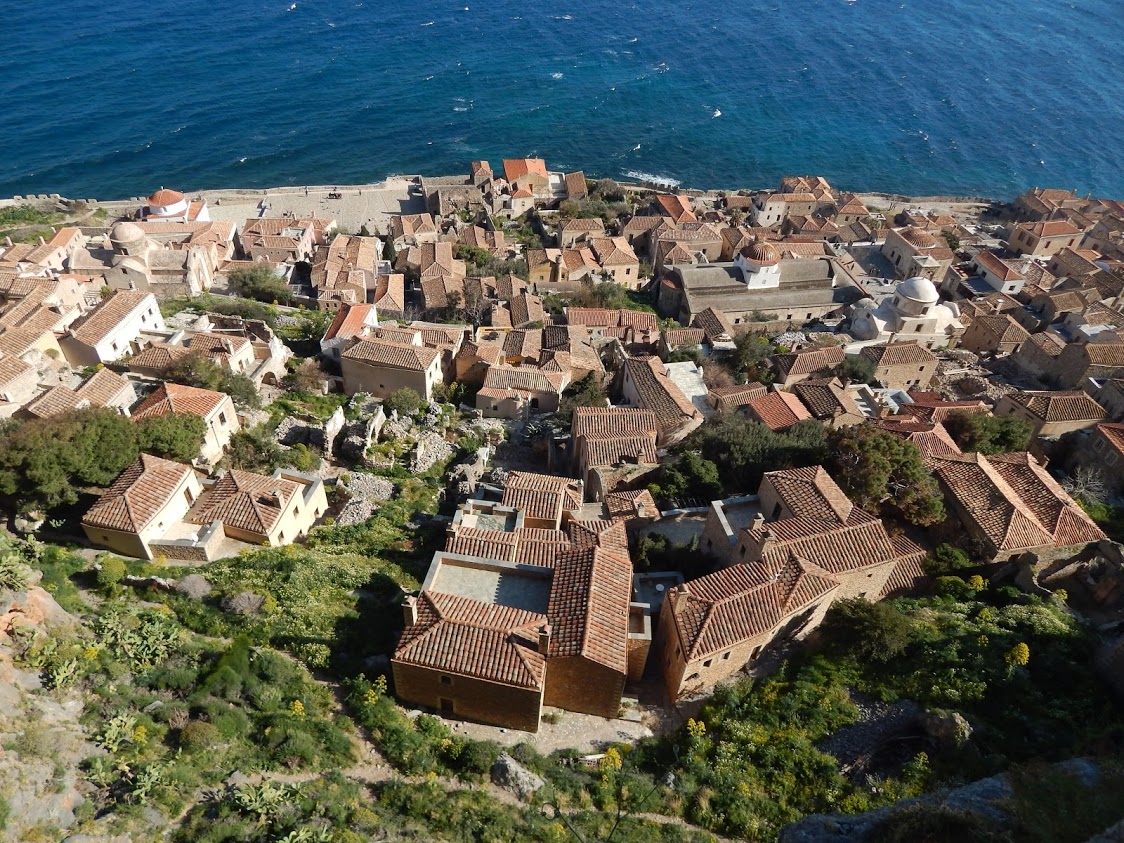
Monemvasia from above
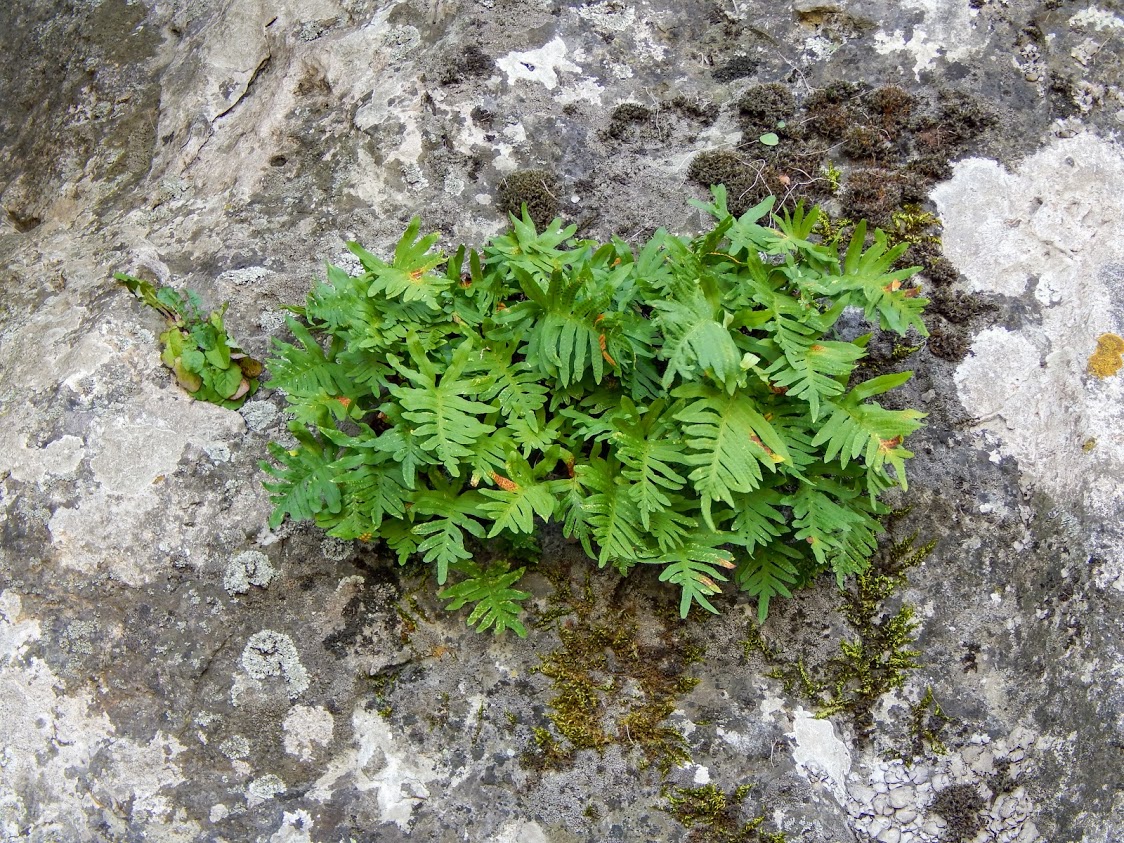
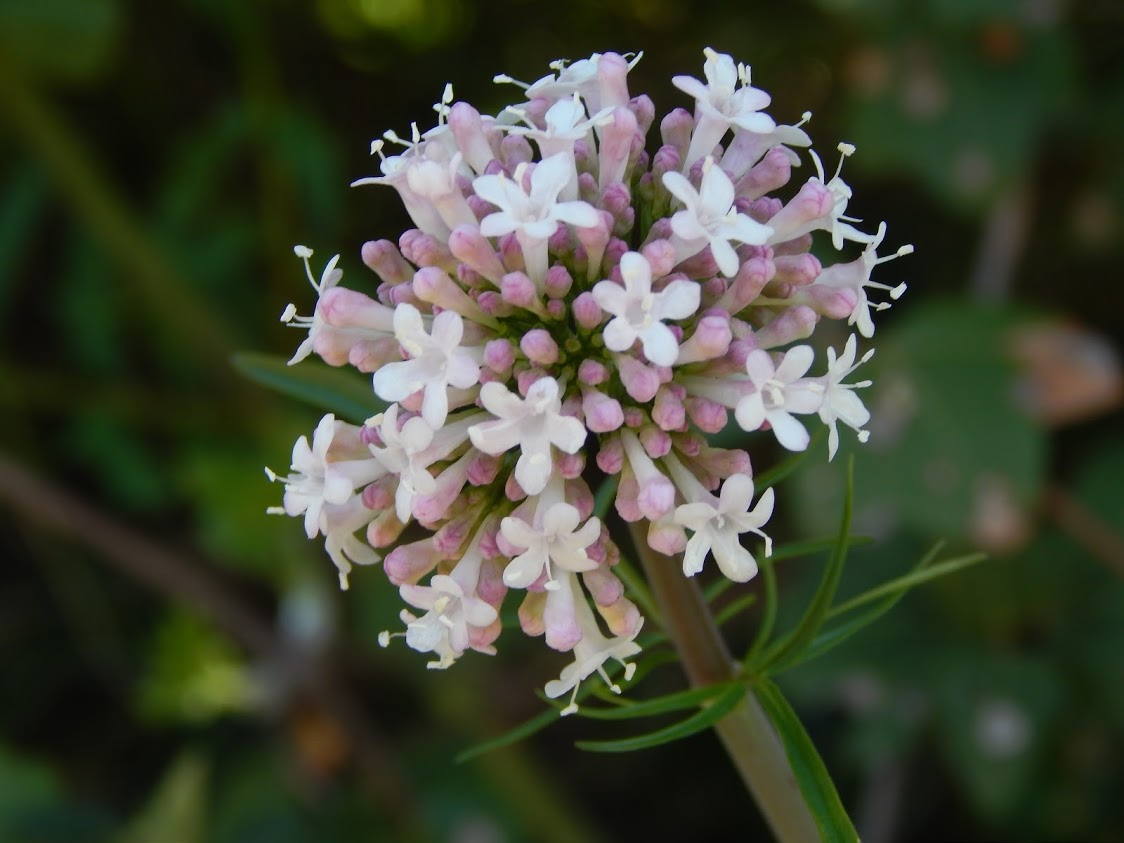
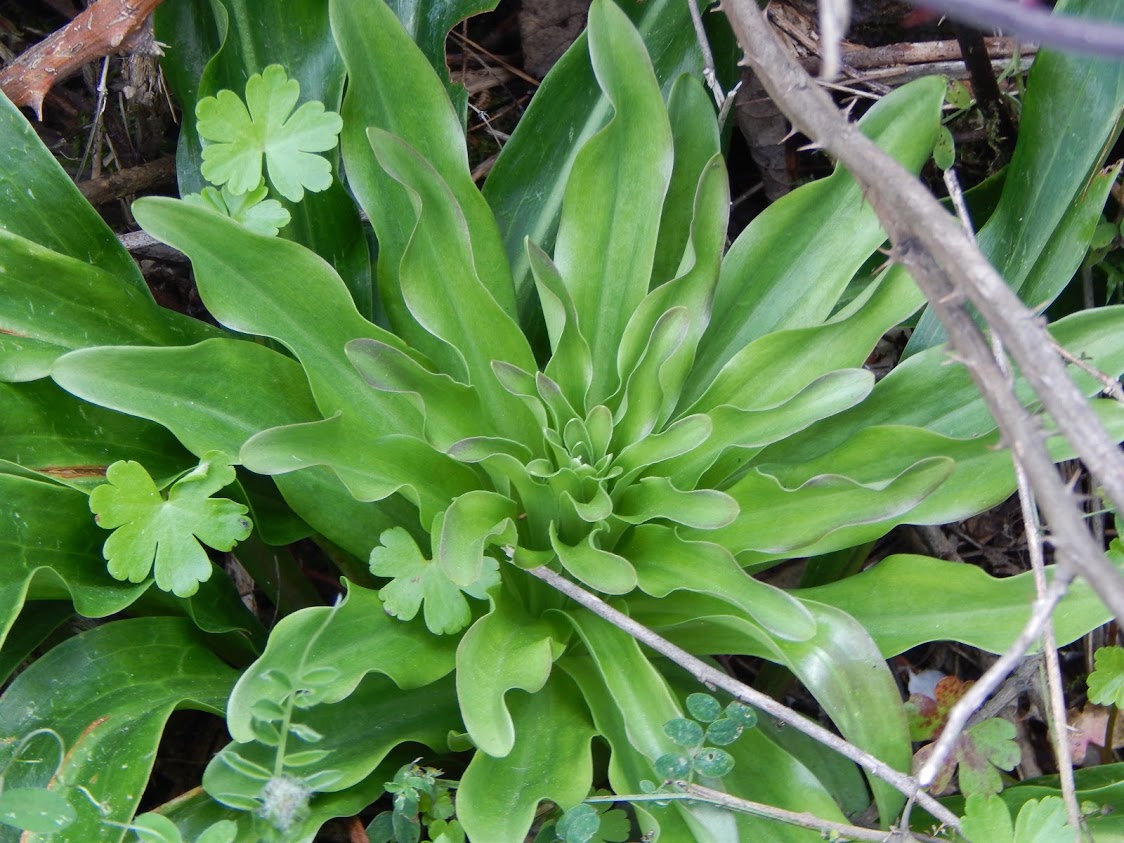
On the other side of the road, we discovered,quite by accident, a large population of mixed Ophrys species in a typical sunny phrygana habitat. The spot was positively teeming with O. sicula and O. mammosa, but also hosted O. tenthredinifera and the more uncommon O. reinholdii. This last Ophrys reminded many members of a wasp, with its distinct upturned tip at the bottom of the labellum, sharp white markings, and narrow, almost streamlined shape. Other plants which were abundant on the sunny part of the side included the tall, architectural Verbascum macrurum, masses of Silene integripetala, and Asphodeline lutea.
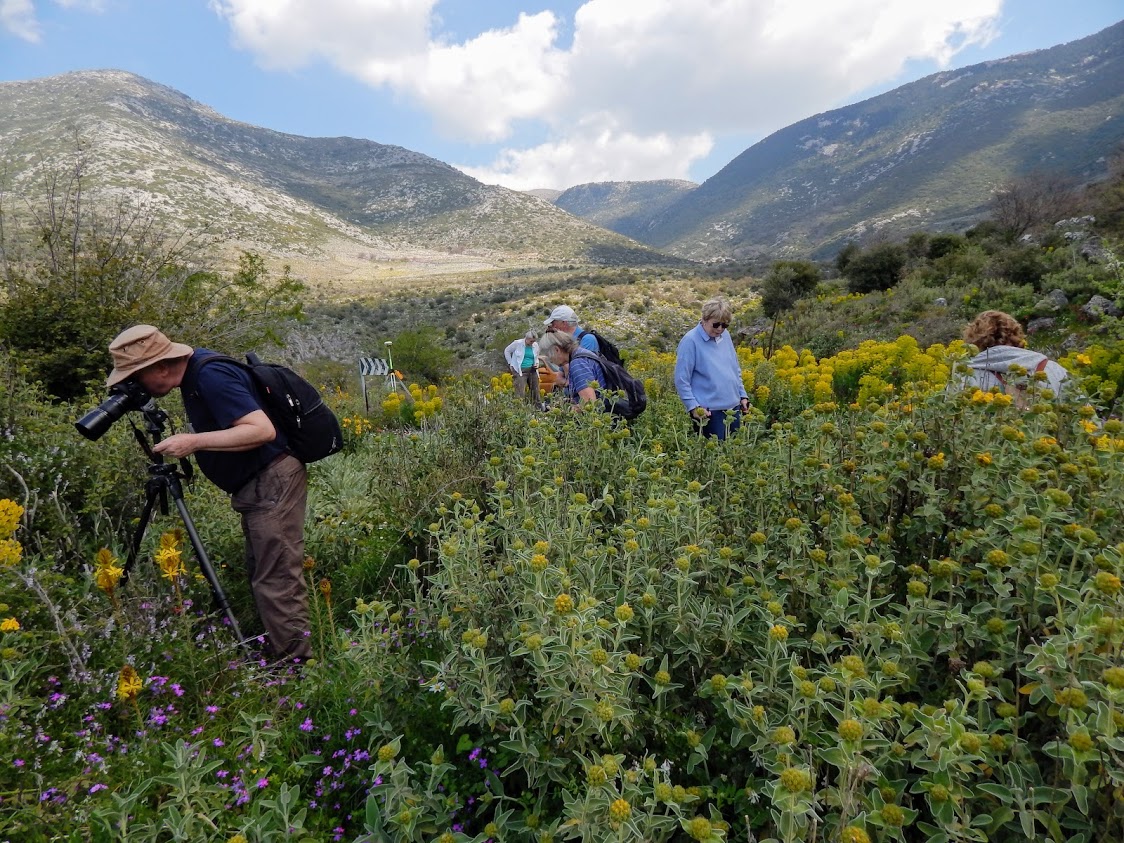
Members exploring roadside site
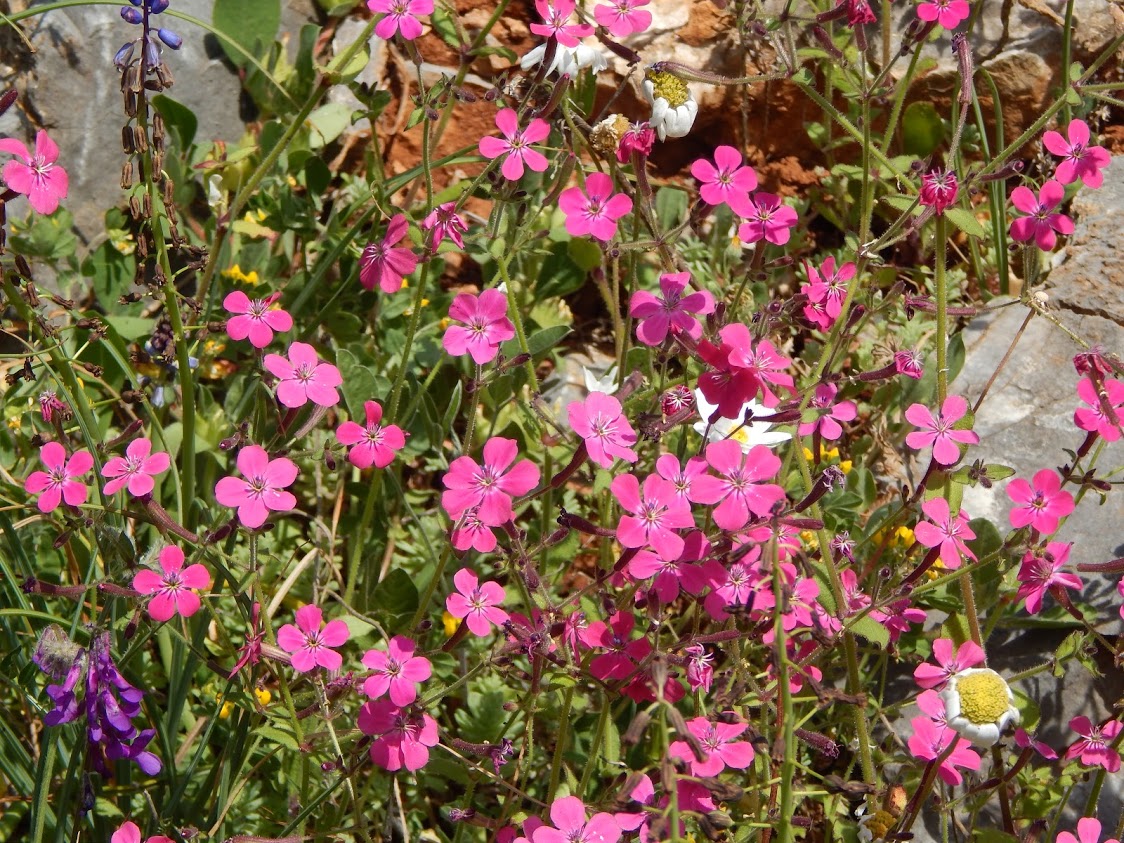
Silene integripetala
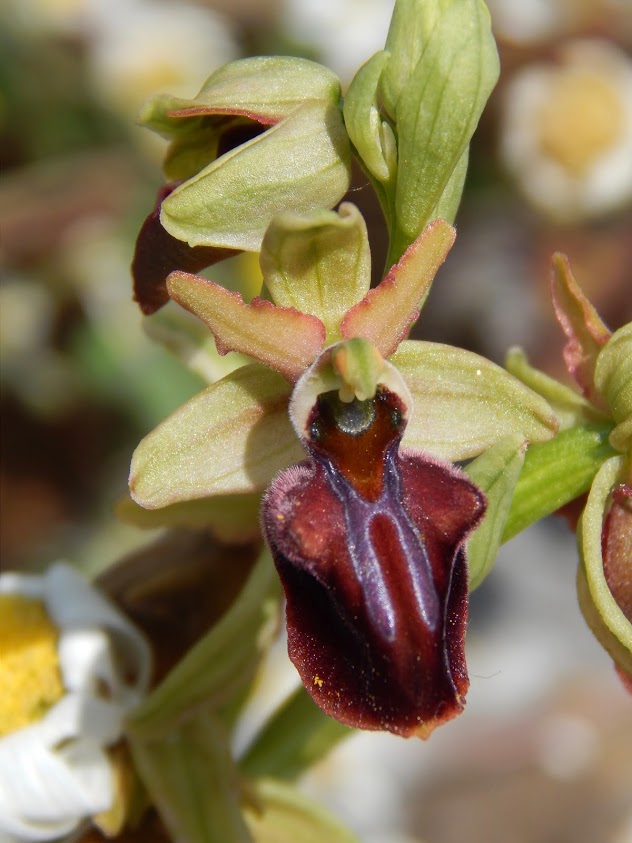
Ophrys mammosa
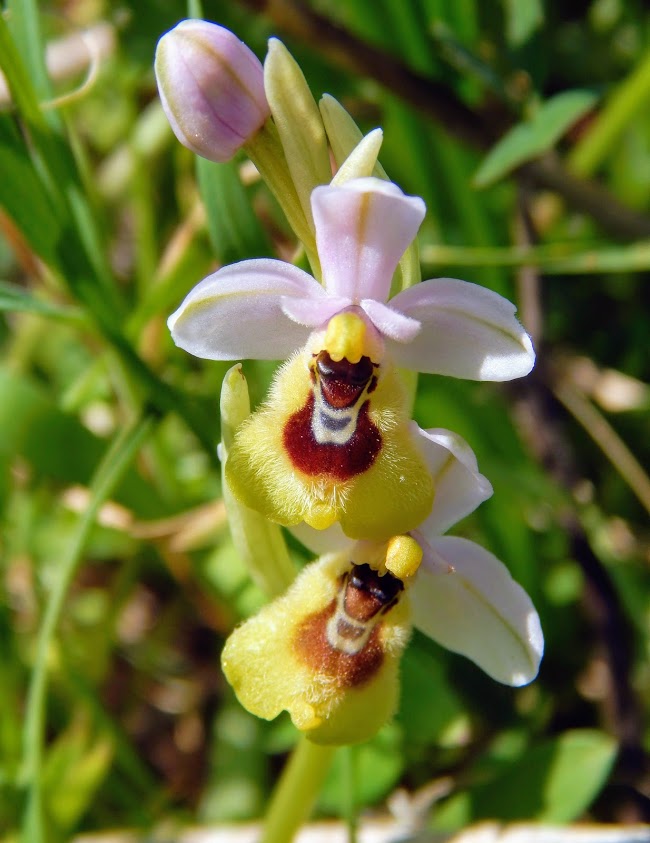
Ophrys tenthredinifera
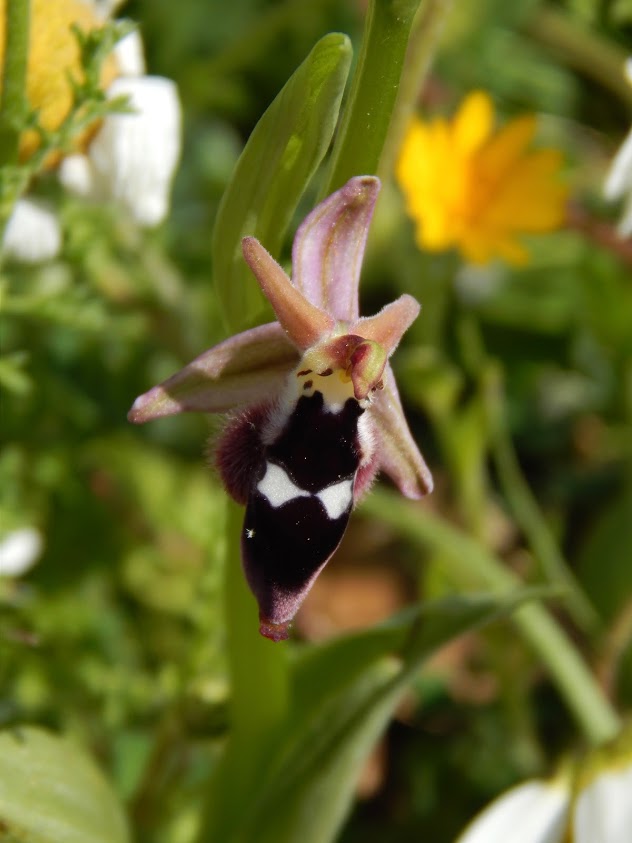
Ophrys reinholdii
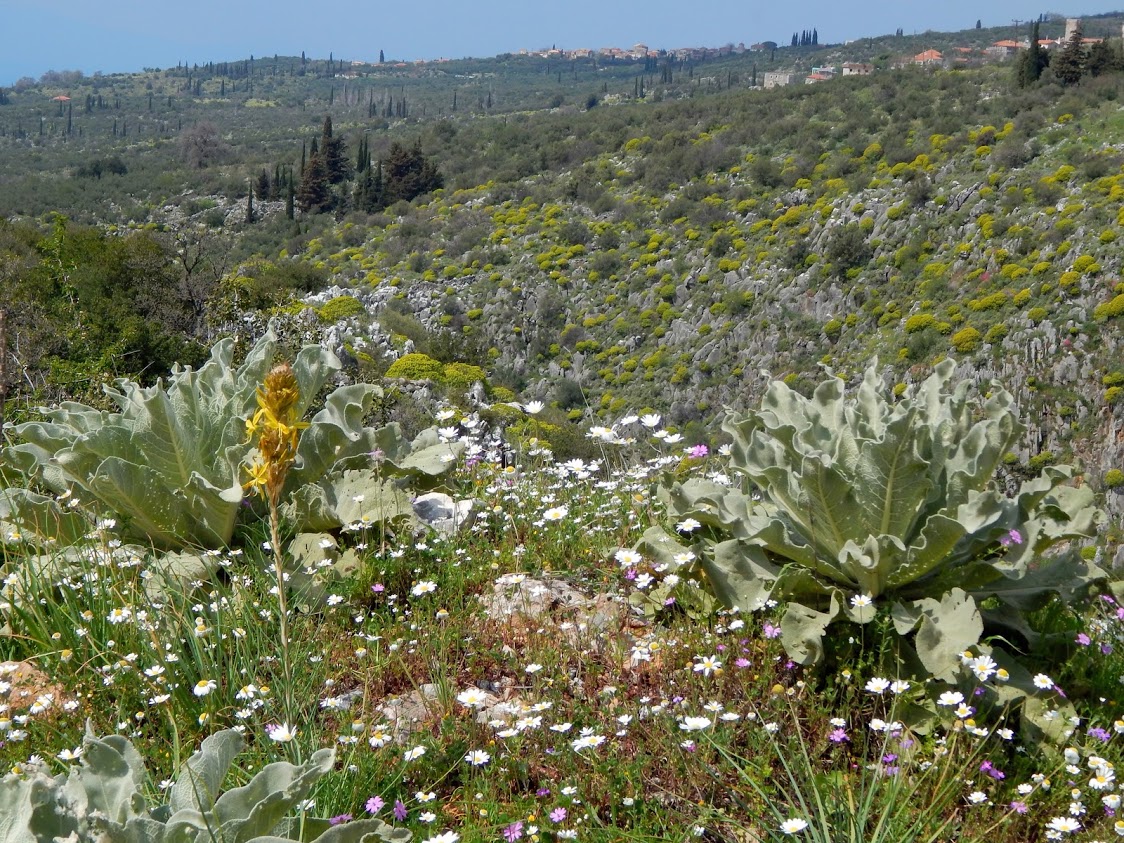
View across landscape
Our next stop of the day was in the charming town of Milea. We enjoyed our packed lunch in the town square, admiring the beautiful church in the centre. We then made our way to a donkey track which had once been the main route through the village, but had now fallen into disrepair and was laden with flowers. There were a plethora of Cyclamen hederifolium subsp. crassifolium and Galanthus reginiae-olgae foliage along the track and in the adjacent dry riverbed, which for most of its length provided a semi-shaded habitat. On the way down we explored a small church which was covered from top to bottom with religious paintings inside. The art historian among us explained the likely origin and meaning of the images. Even with my very limited knowledge of Greek history, I was entranced by the detail, colour, and preservation of the paintings.
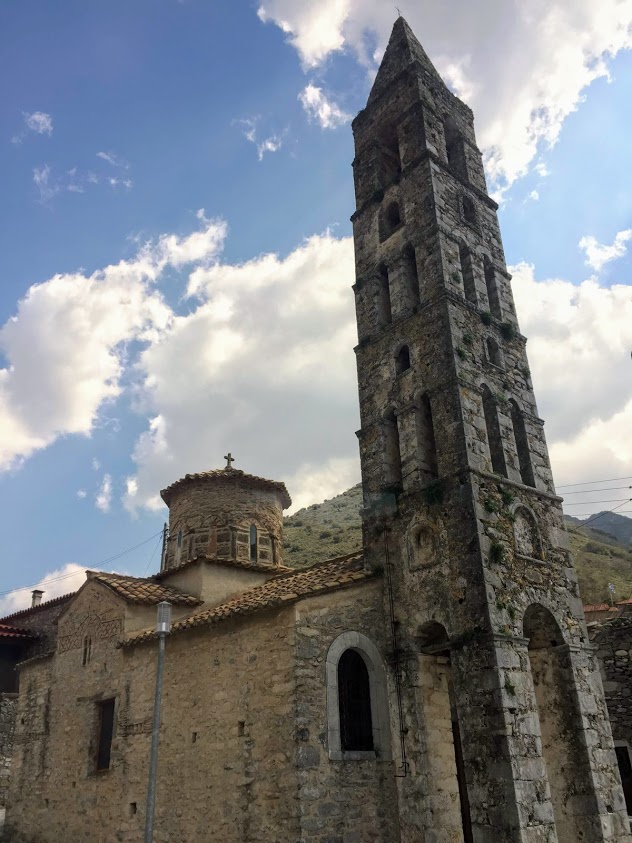
Church in Milea
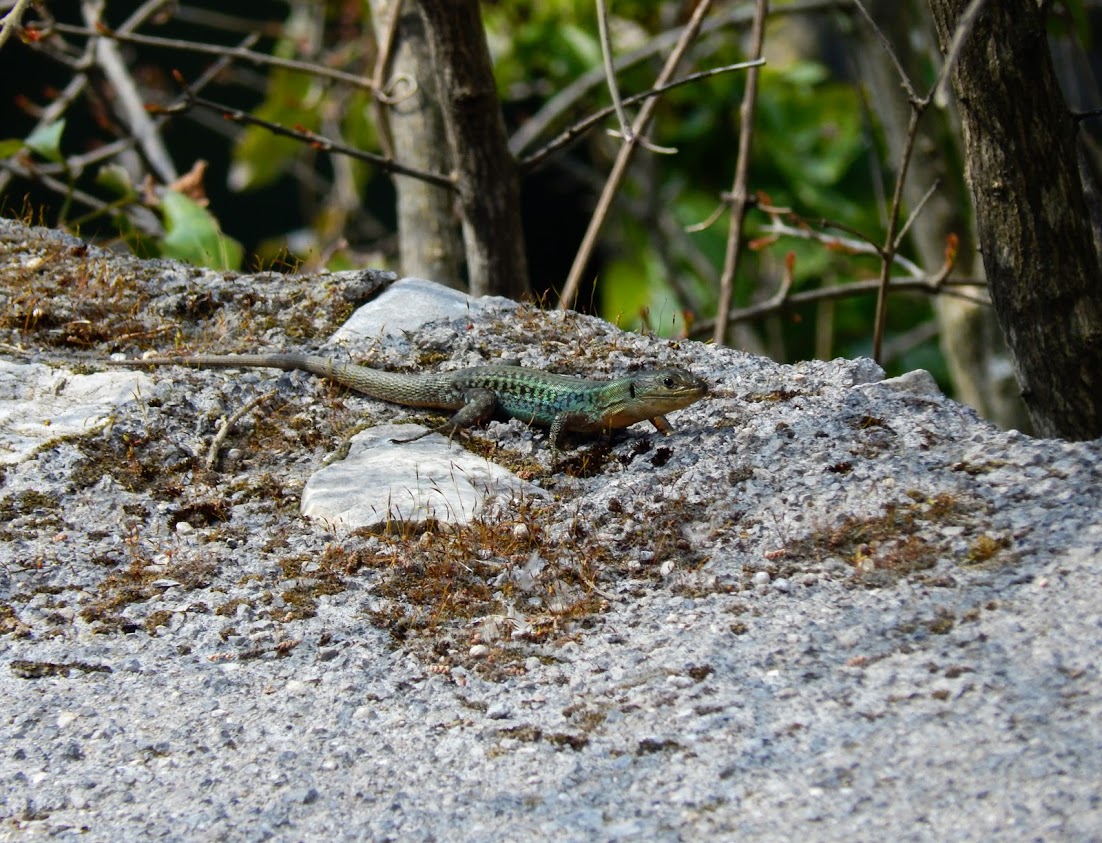
One lizard
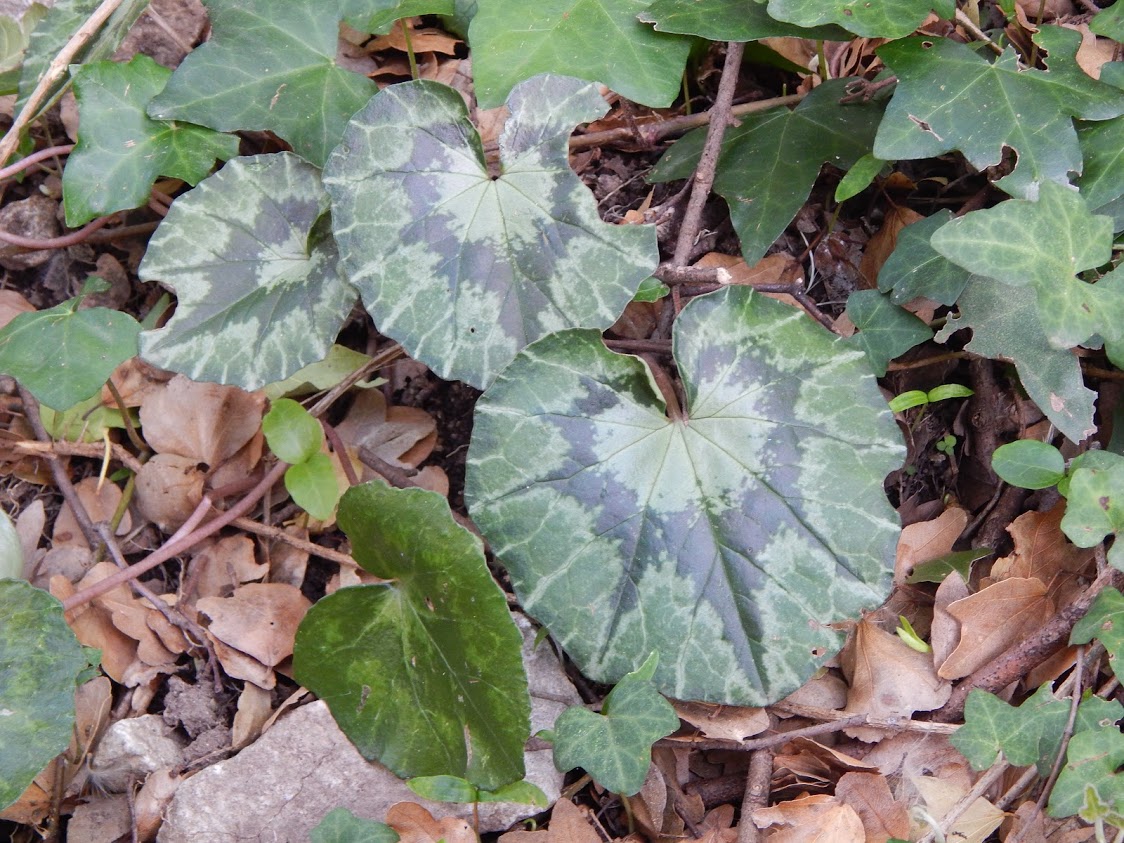
Cyclamen hederifolium subsp. crassifolium
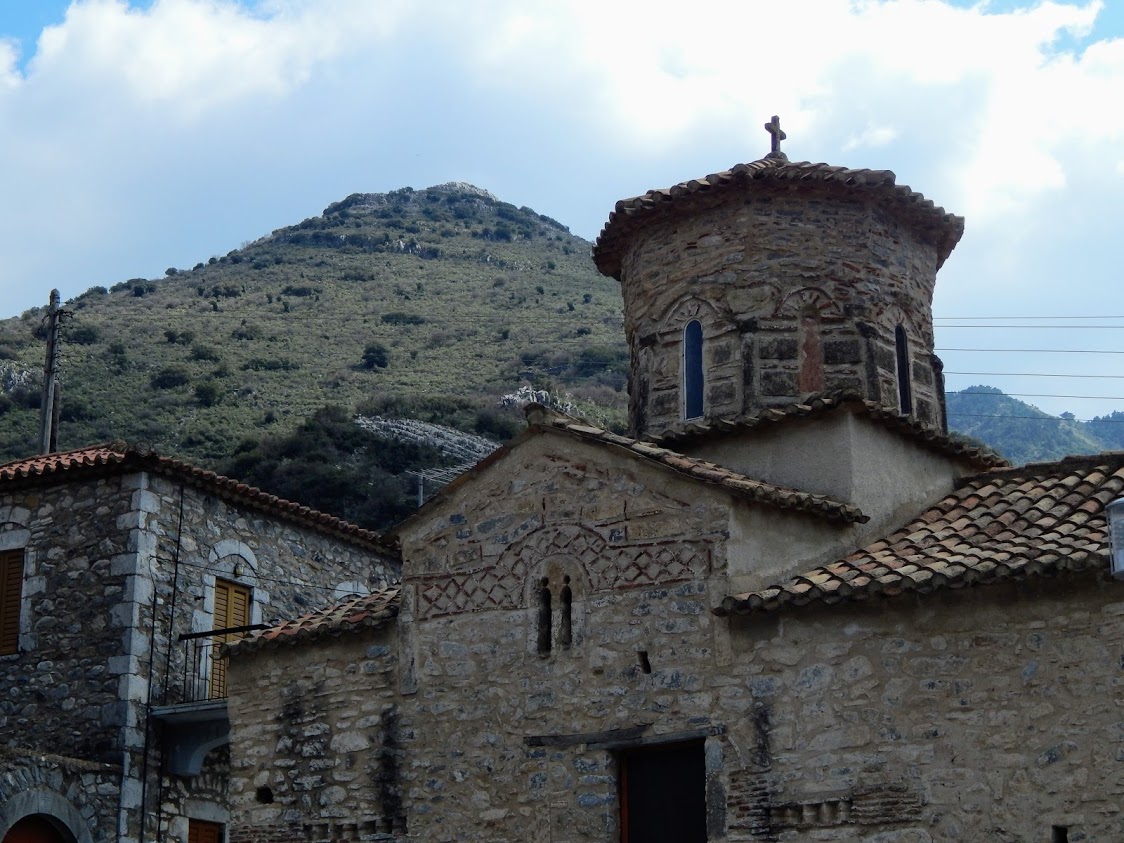
Milea
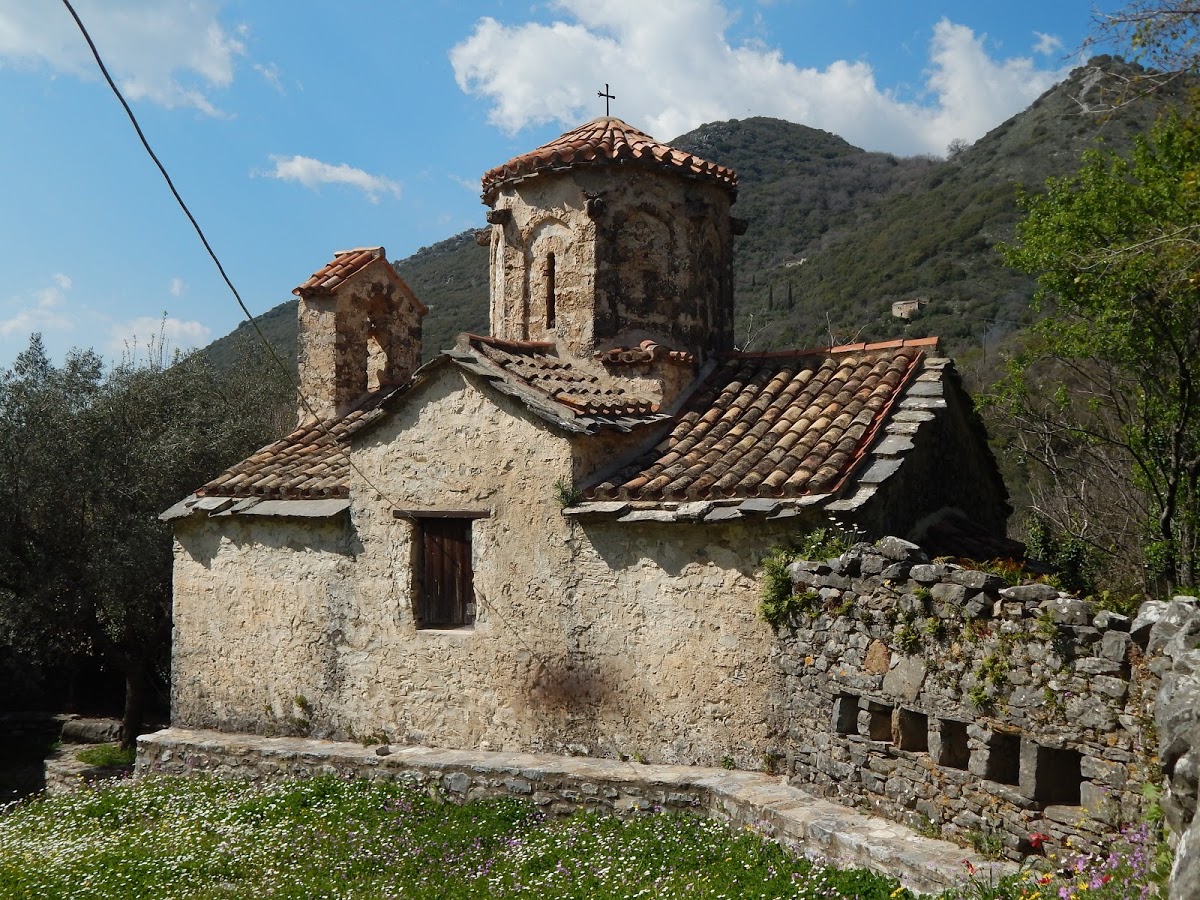
Small church along the donkey track
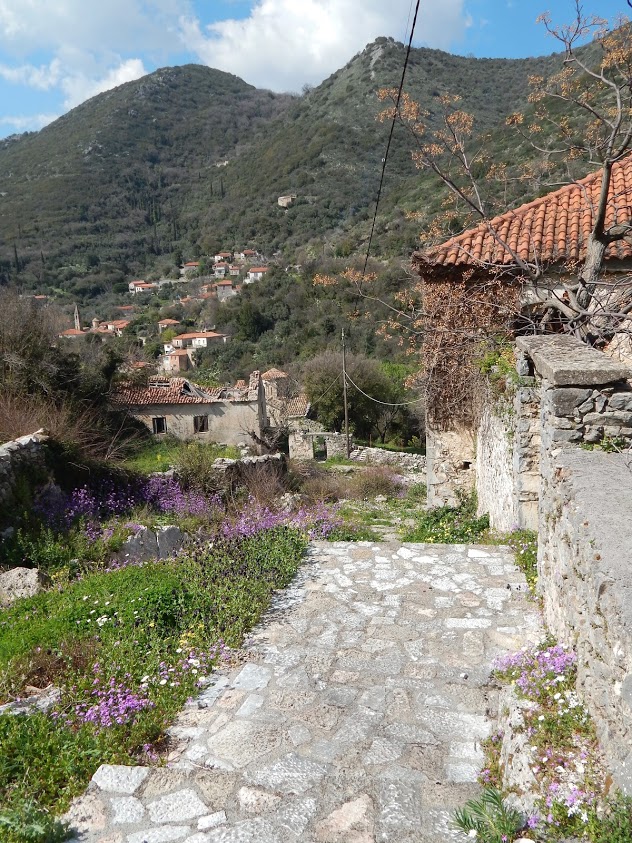
Start of donkey track in Milea
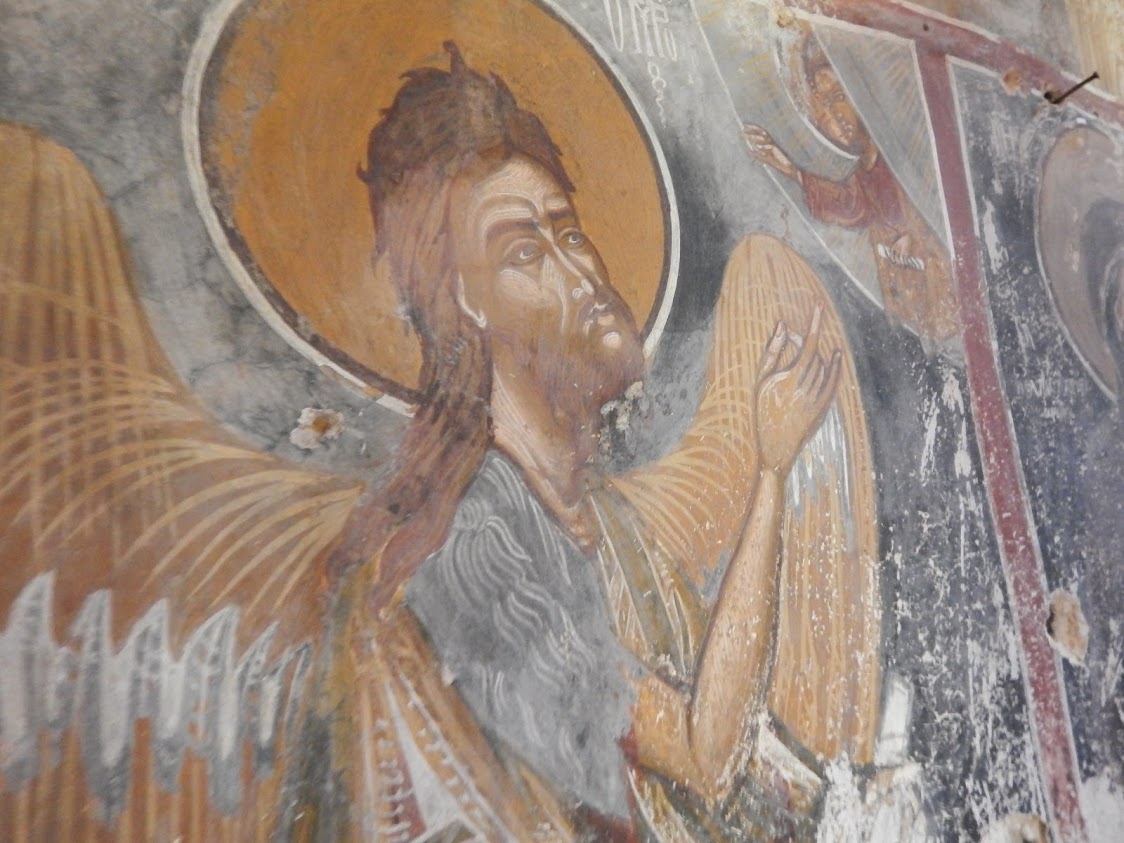
Painting within the church
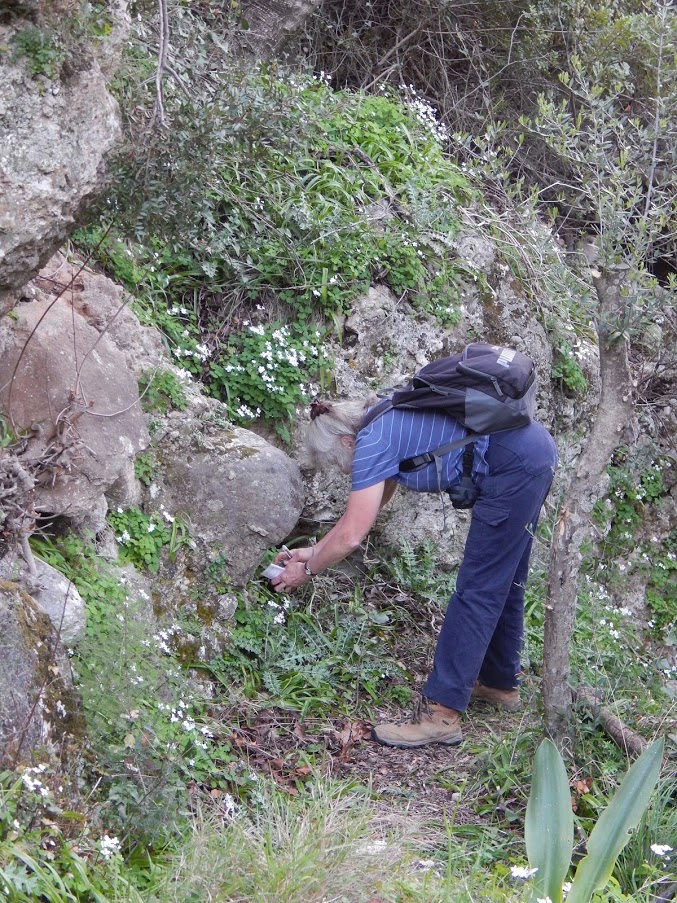
Caroline inspecting a specimen
Arriving in Kardamyli around 5 pm, most members settled into their rooms and enjoyed the spectacular seaside views.
John decided to lead an extra walk into the Kardamyli gorge, following the dry river bed out of the town. Here we found the beautiful white flowered Thalictrum orientale spilling out of crevices in a shady limestone cliff. John was very pleased to have found the special plant and the rest of us were equally amazed by its beauty. The leaves of the plant resembled those of a maidenhair fern – bright, light green and delicately cut.
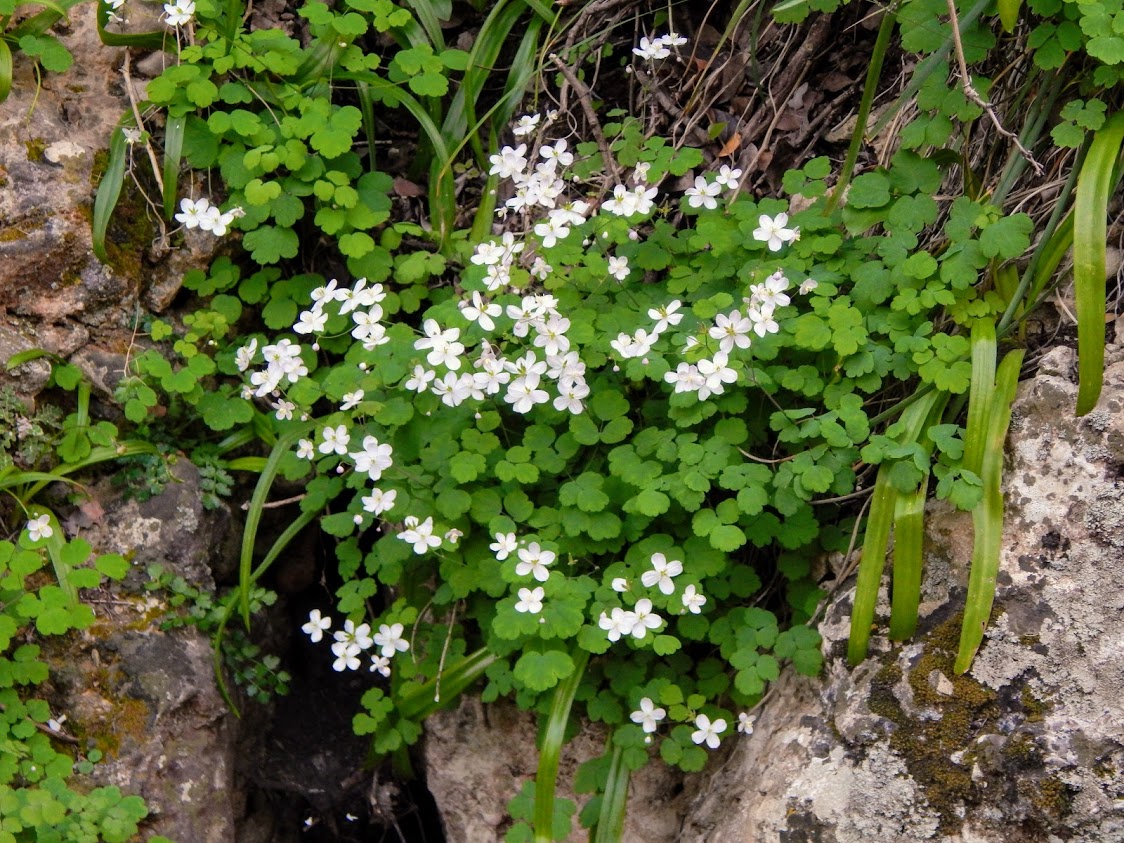
Thalictrum orientale
The day ended with a meal at a local taverna, where most of us enjoyed a white fish. It had been a busy day, and I fell asleep promptly once I’d returned to the hotel.
Monday March 25
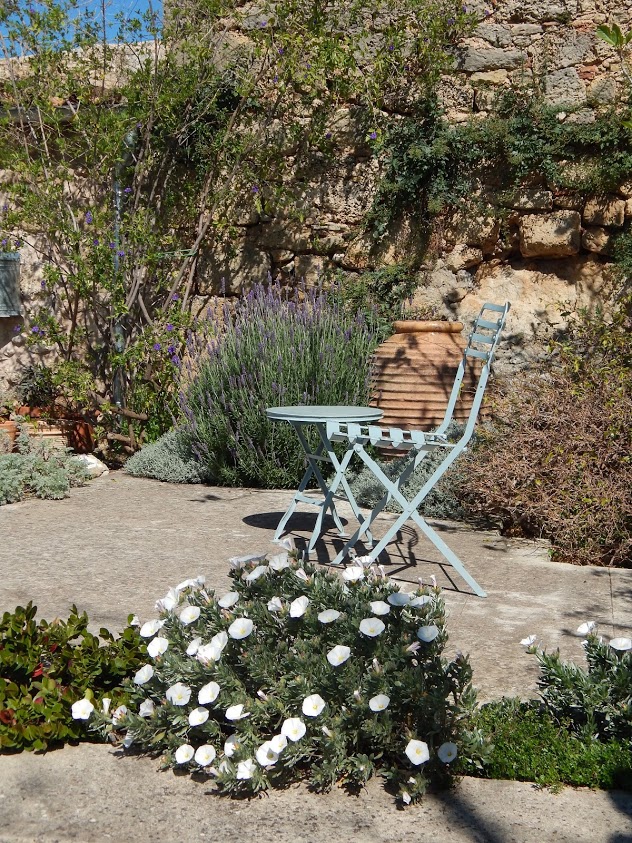
Convolvulus cneorum
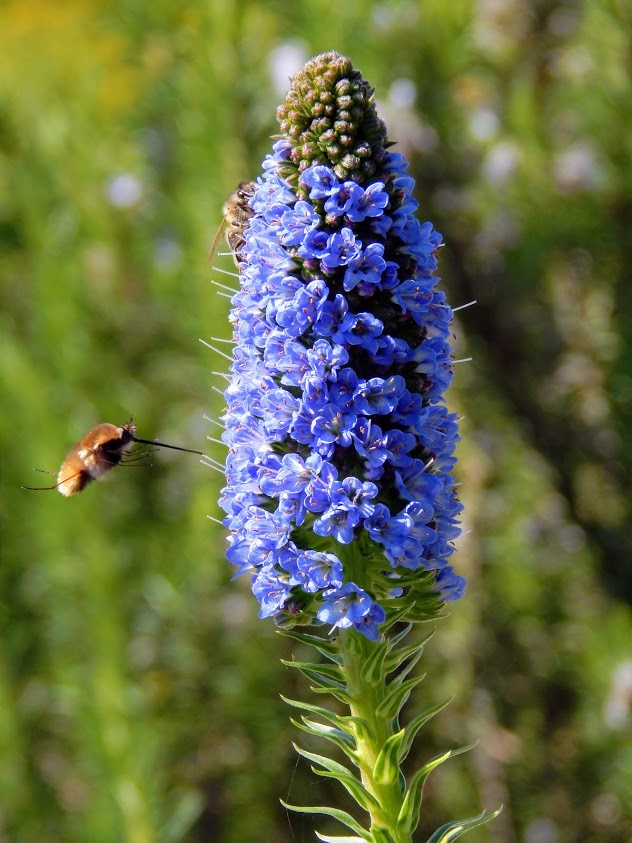
Echium candicans
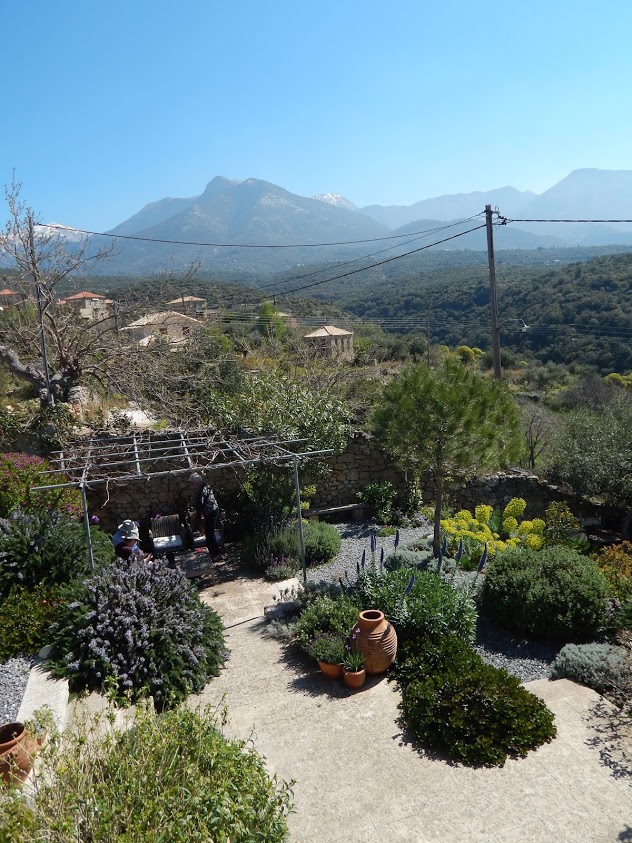
Katerina’s garden view
Now all assembled, we made our way to Katerina’s home where we enjoyed cool drinks and cookies as we listened to her explain the history of her delightful garden. A sense of peace fell over us as we admired the space she had created. Planted with Mediterranean species, the garden blended into the natural landscape while simultaneously creating a sort of lush oasis. You could tell that the plants had been expertly selected to soften the stone terracing and introduce a sense of structure.

Katerina’s garden
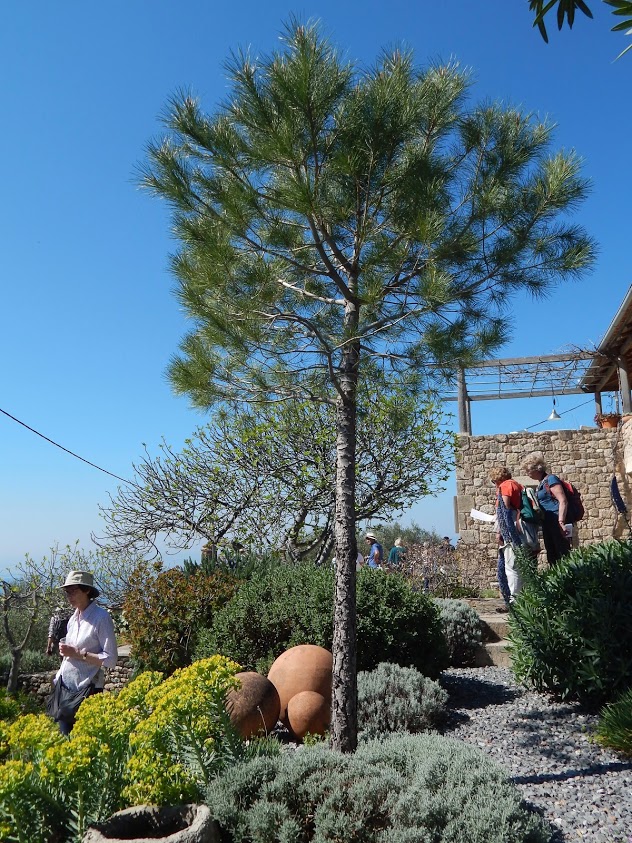
Pinus pinea
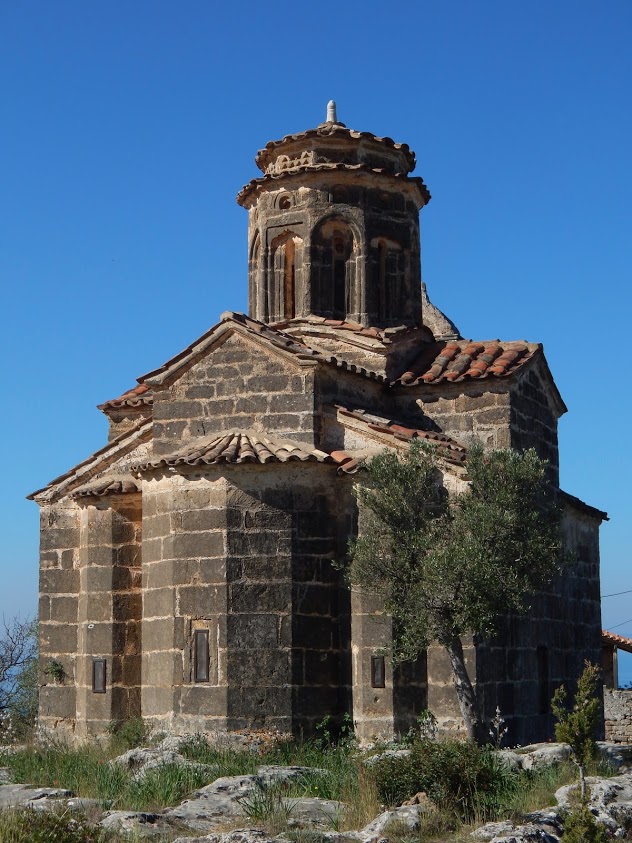
Church of Agios Sofia
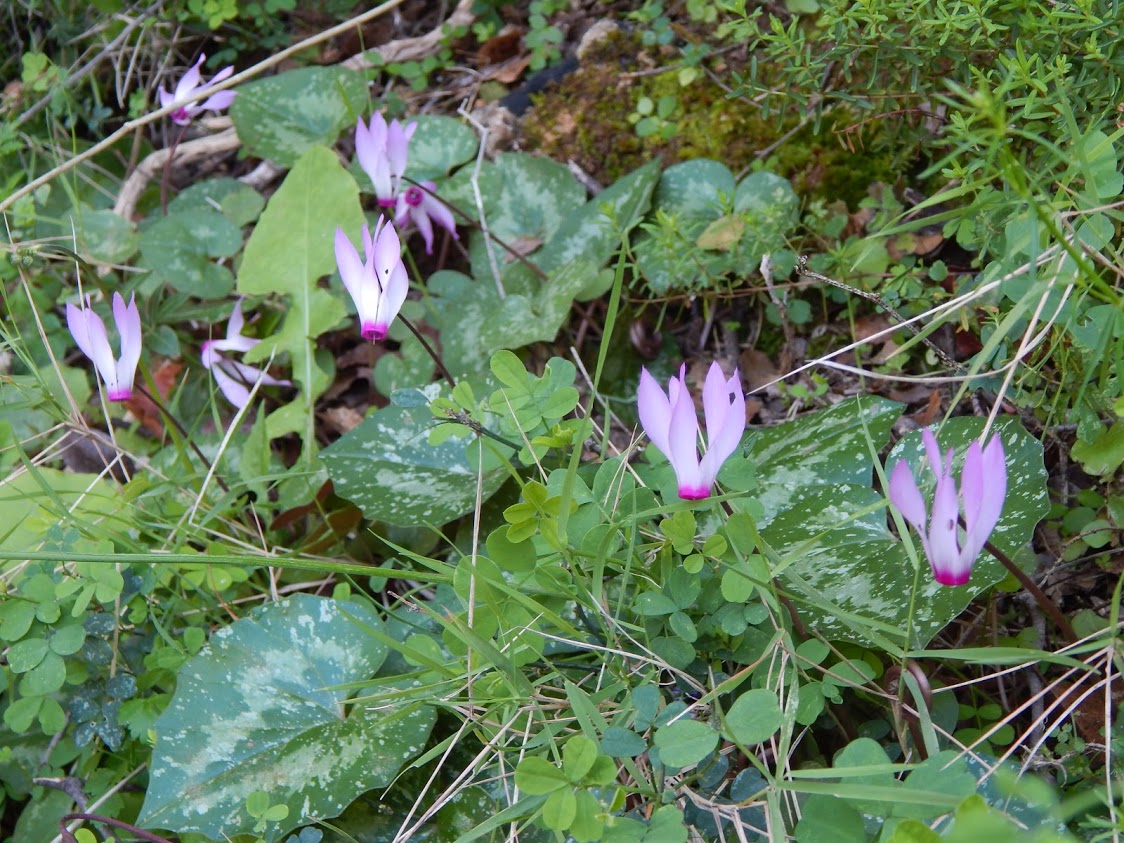
Cyclamen rhodium subsp. peloponnesiacum
We returned to Kardamyli via the same track we had walked up, spending a considerably longer time on the descent due to frequent stops and diversions down side paths to look at plants. The shaded cliff faces were teeming with Cyclamen rhodium subsp. peloponnesiacum and in sunnier positions Lithodora zahnii, both blooming magnificently. Orchis italica was also coming into bloom in semishaded crevices. O. italica could be confidently distinguished from the similar O. simia as the flowers opened from the bottom to the top of the inflorescence. All of the flowers we saw along this track were a paler pink than is typical for the species. We hypothesised this could be due to the shaded habitat, but as with many orchids, could simply be random genetic variation. This was the only blooming Orchis of the trip, as most species bloom a bit later in the season. As we made our way down, rapid alternations between this orchid and cyclamen harbouring shady habitat and sunny scrub were evident.
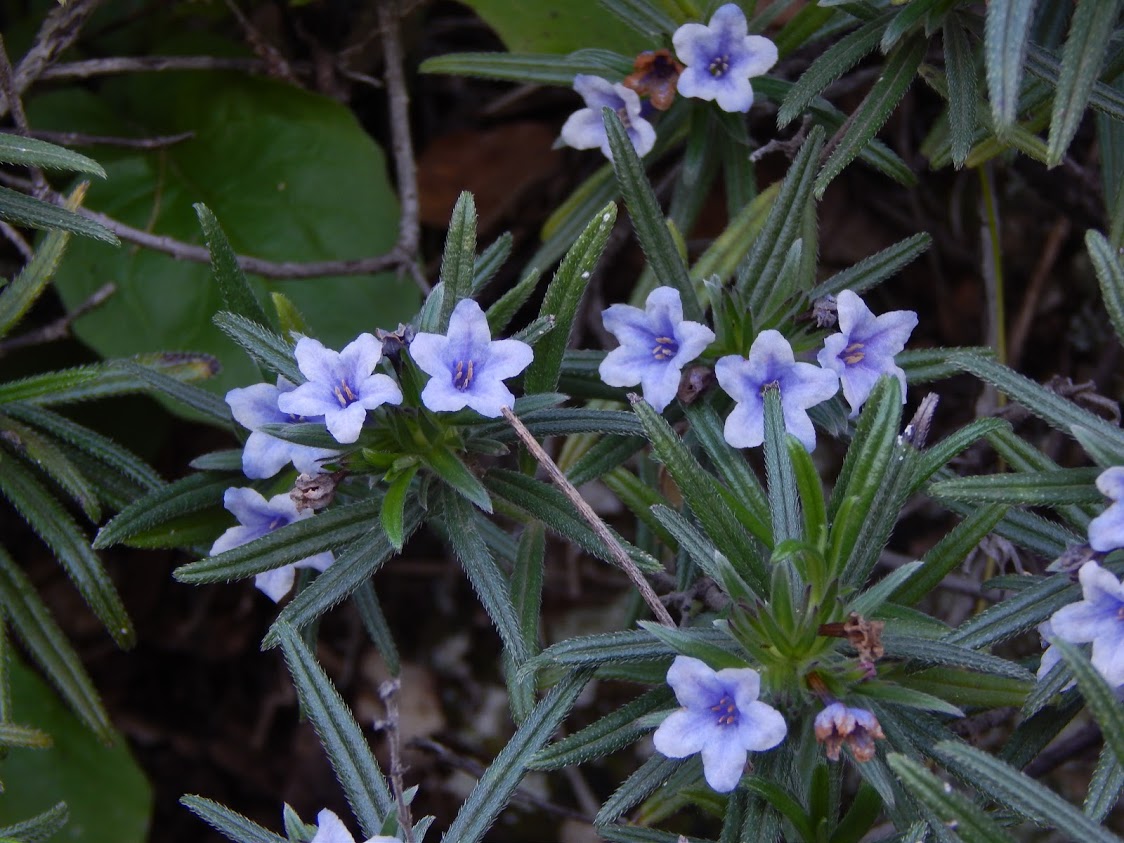
Lithodora zahnii
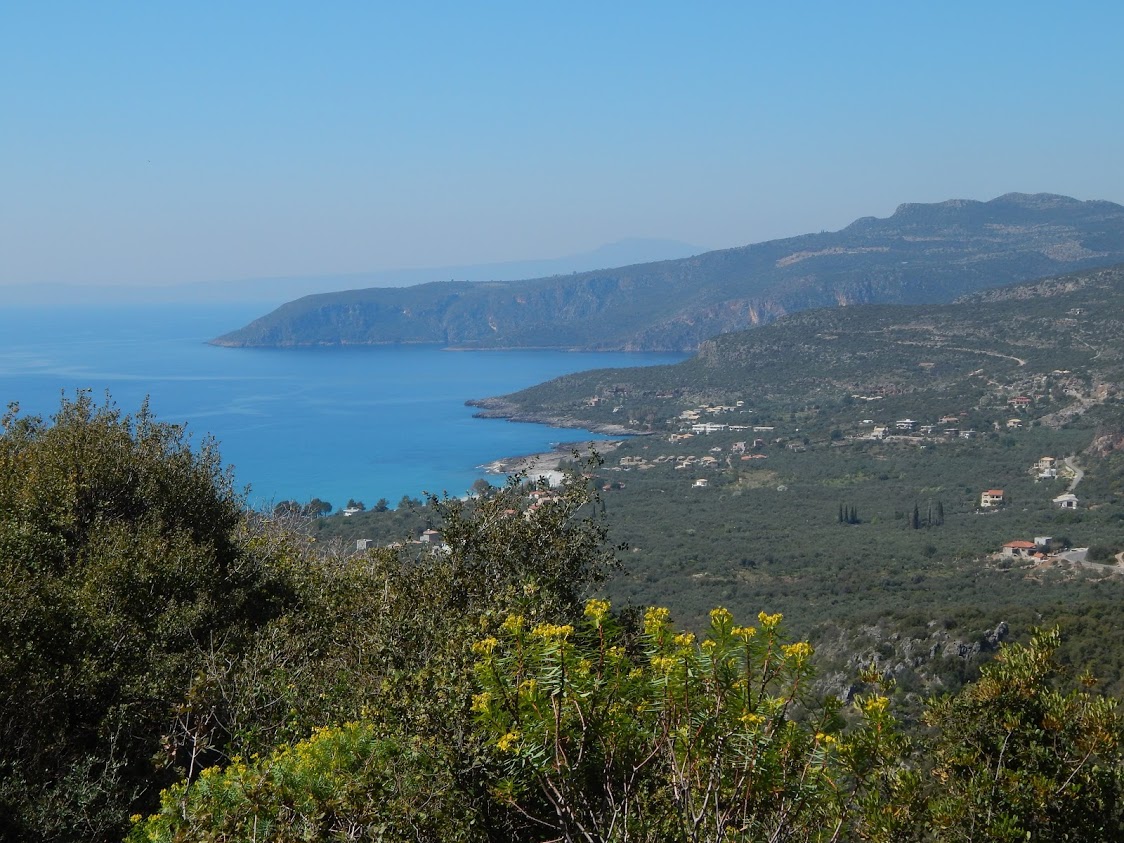
View of donkey track Agios Sofia to Kardamili
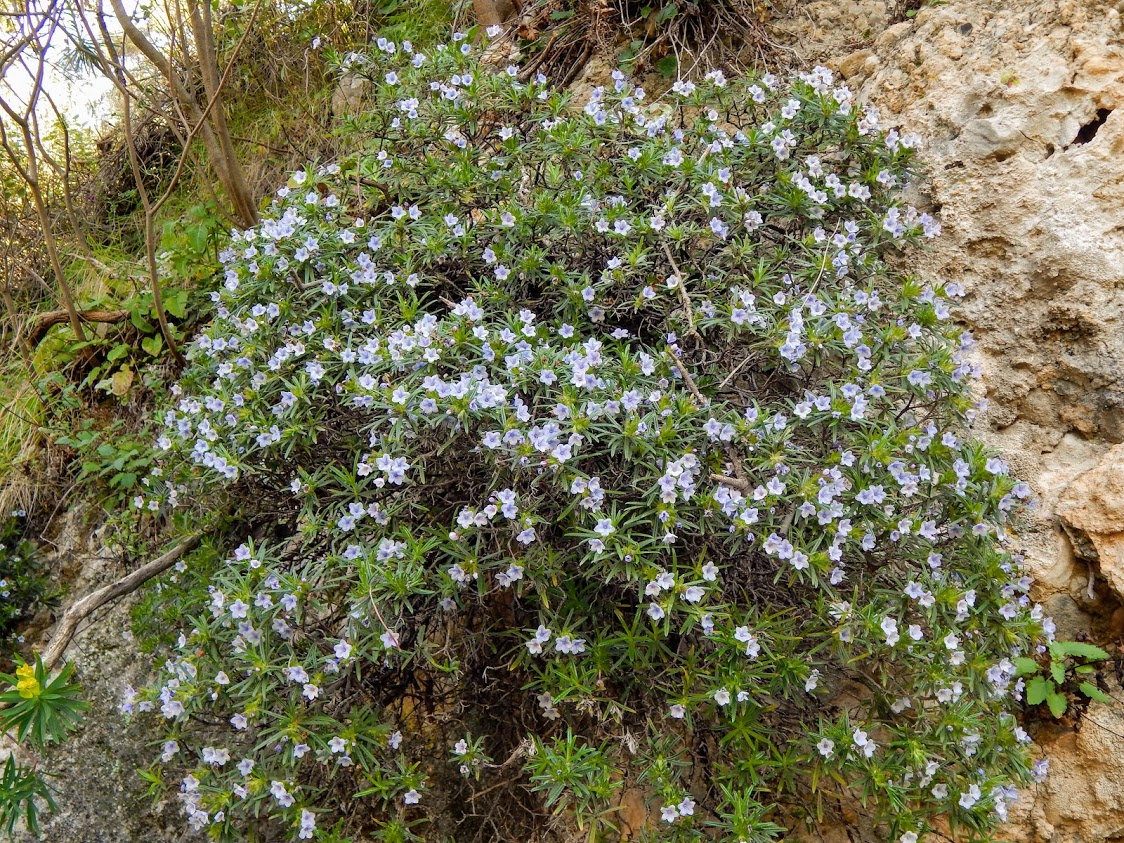
Lithodora zahnii
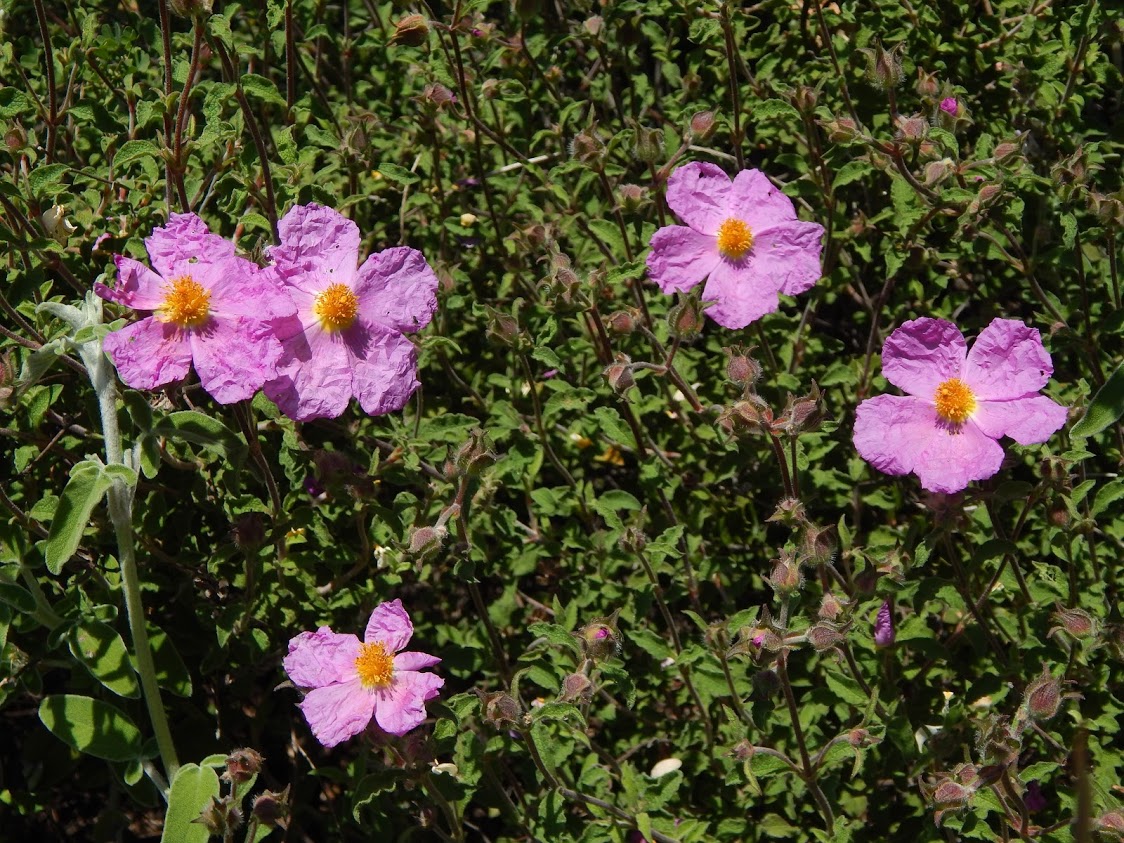
Papery petals of Cistus creticus

Orchis italica
In the sunnier habitat, Cistus salvifolius and Cistus creticus were both present and blooming. Some other sun loving species noted included Gladiolus italica, Ophrys speculum, and Fumana thymifolia, the latter of which bore yellow flowers quite similar to Cistus sp.; unsurprising as they are in the same family Cistaceae.
We were reminded at lunch that today, March 25th, is a major public holiday (Greece’s independence day) due to the sheer volume of people at the restaurant. After a light lunch of Greek salad and pies, we took a very short coach ride to the nearby house and garden of the late Sir Patrick Leigh Fermor.
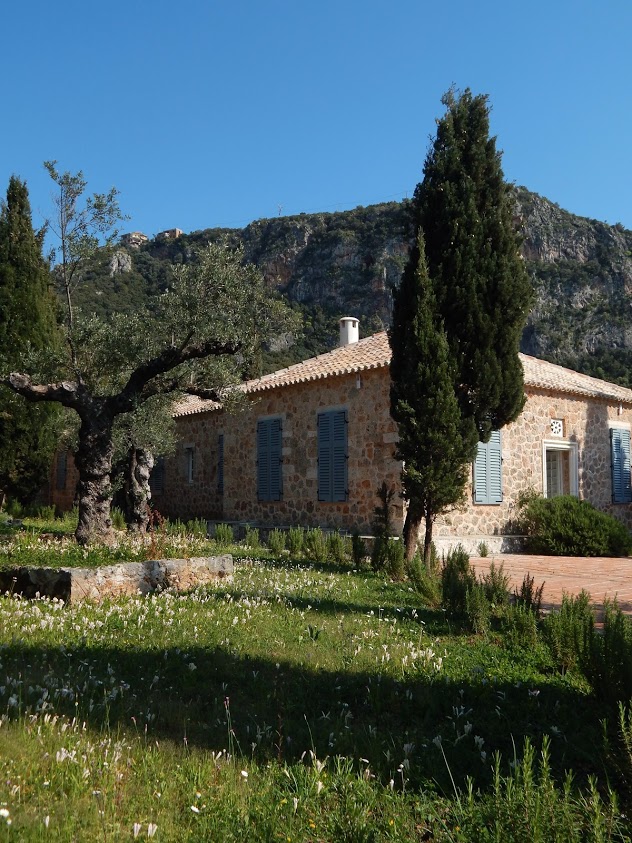
Katerina is involved in the restoration of the garden and so we were allowed to explore it despite it not normally being open to the public.
Members who had been on the fall Peloponnese trip 18 months ago were stunned at the progress which had been made since their previous visit. One of the most striking changes was apparently the removal of a sizeable shrub which had revealed a spectacular view of the seaside.
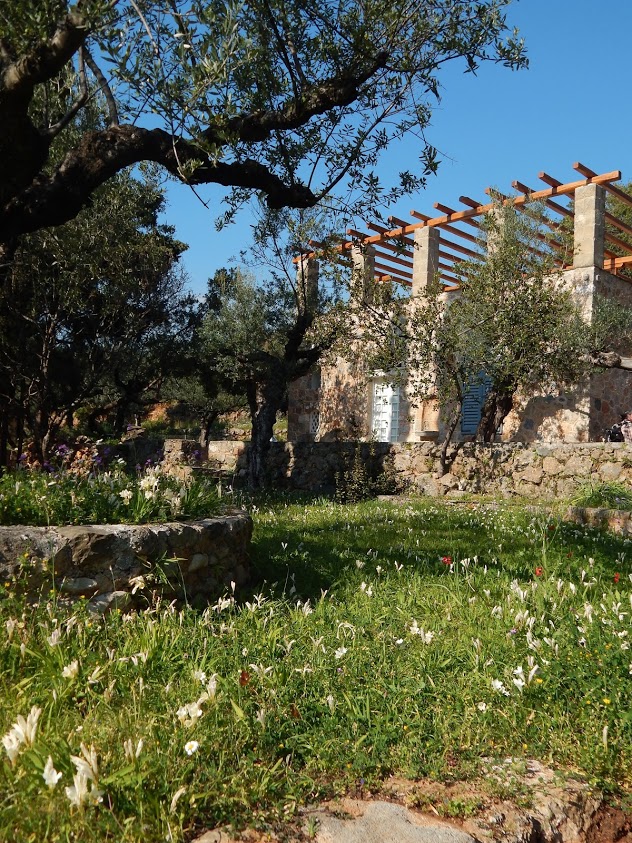
The lawn had been thoroughly taken over by a mix of native and naturalised flowers – Freesia alba, Tulipa clusiana, Serapias orientalis, and Arisarum vulgare were some of the plants dotted around currently in bloom. After admiring the flora, many of us took time to admire the wonderful architecture of the garden which included pebble mosaics, impressive archways, and varied stone structures.
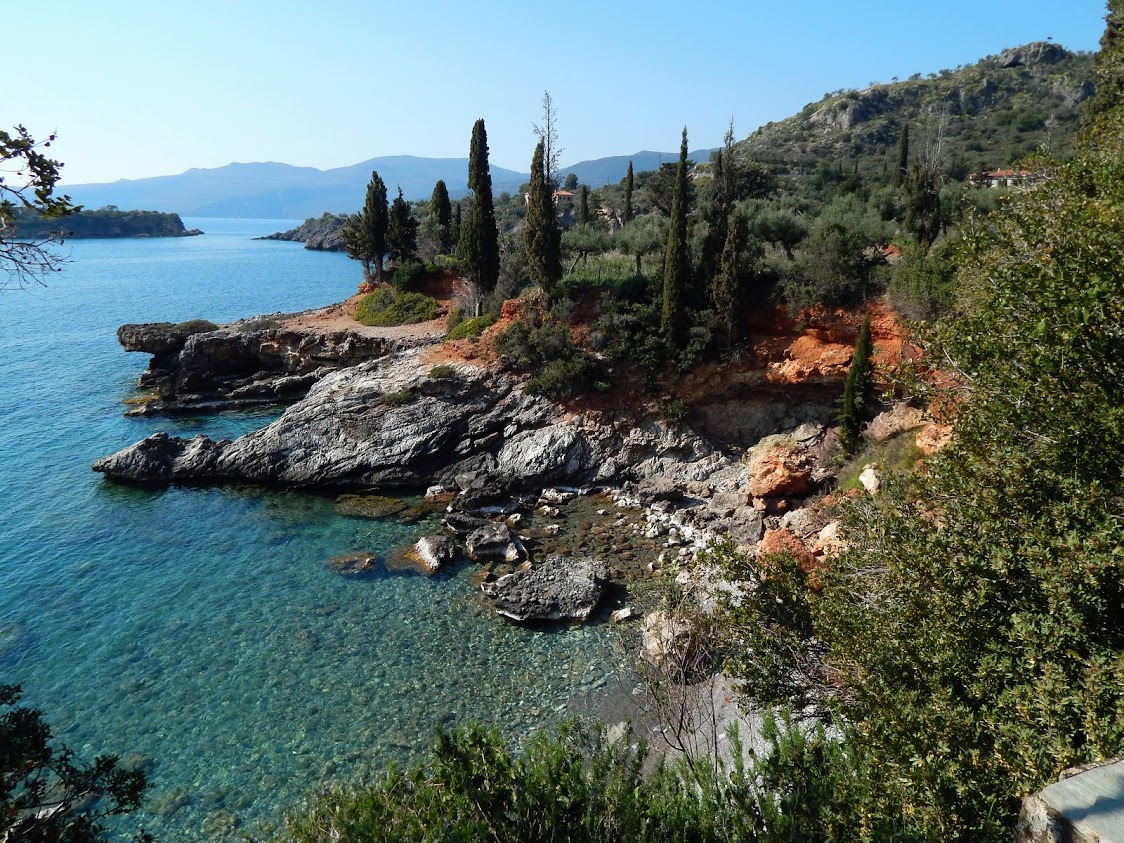
View to the sea and beach
Several of us decided to walk back to Kardamyli along a coastal path. We were entertained by a flock of turkeys which communicated enthusiastically with Jo. François and I spotted a blooming Allium along the way. During the 20 minute or so walk we were periodically rewarded with stunning views of the cliffs, inlets, and other coastal features just south of Kardamyli.
With a few hours to spare before dinner, I decided to make the most of the warm, sunny weather and with Katerina’s advice found a small pebbly beach just beyond the hotel. I went for a quick swim in the surprisingly not-too-cold Mediterranean sea.
Tuesday 26 March
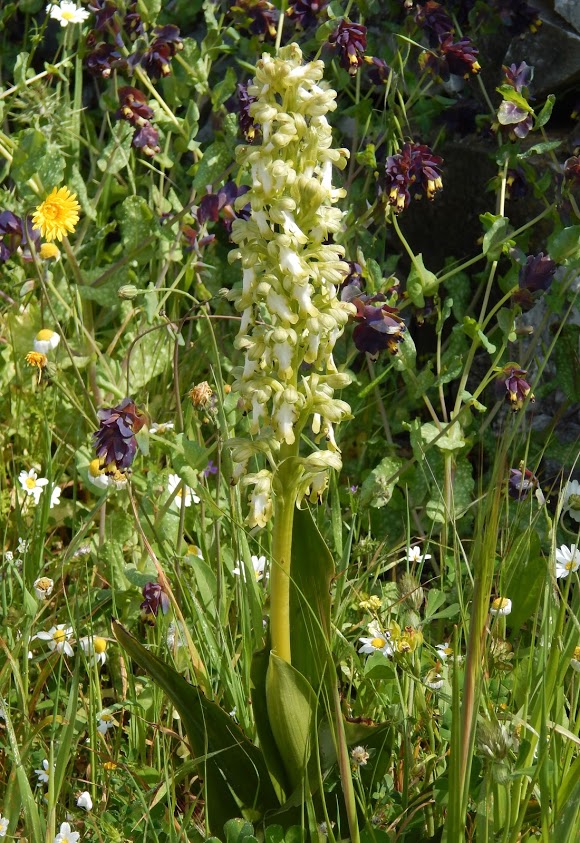
Today we were to make the trip down into the inner Mani peninsula, something I had been looking forward to the entire trip. The first stop of the day was to pick up pies for lunch, and of course John led a quick wildflower walk from the bakery. Jo told us she had spotted a large, white orchid just a couple hundred meters before the bakery from the bus. John was skeptical, but when she came back with a picture we were pleasantly surprised that it had in fact been a large, white orchid – an albino Himantoglossum robertianum. The tall, regal plant was in perfect condition. Several other giant orchids of the normal colour form stood nearby, looking rather shabby in comparison. White flowered forms like this are quite unusual but incredibly beautiful. The lip which is usually shades of purple or brown was crisp white, lined with the same lime green as the outer petals and sepals.
Once we had taken turns photographing the albino, we made our way back towards the bus. Unfortunately large swathes of the roadside olive grove had clearly been sprayed, resulting in a carpet of dead plants. We kept to the side of the road which had not suffered such a fate and was still full of flowers and foliage. There was an especially rich flora of annuals – including the interesting Vicia melanops. The green and black flowers of this sprawling herb are quite unusual for a member of Fabaceae.
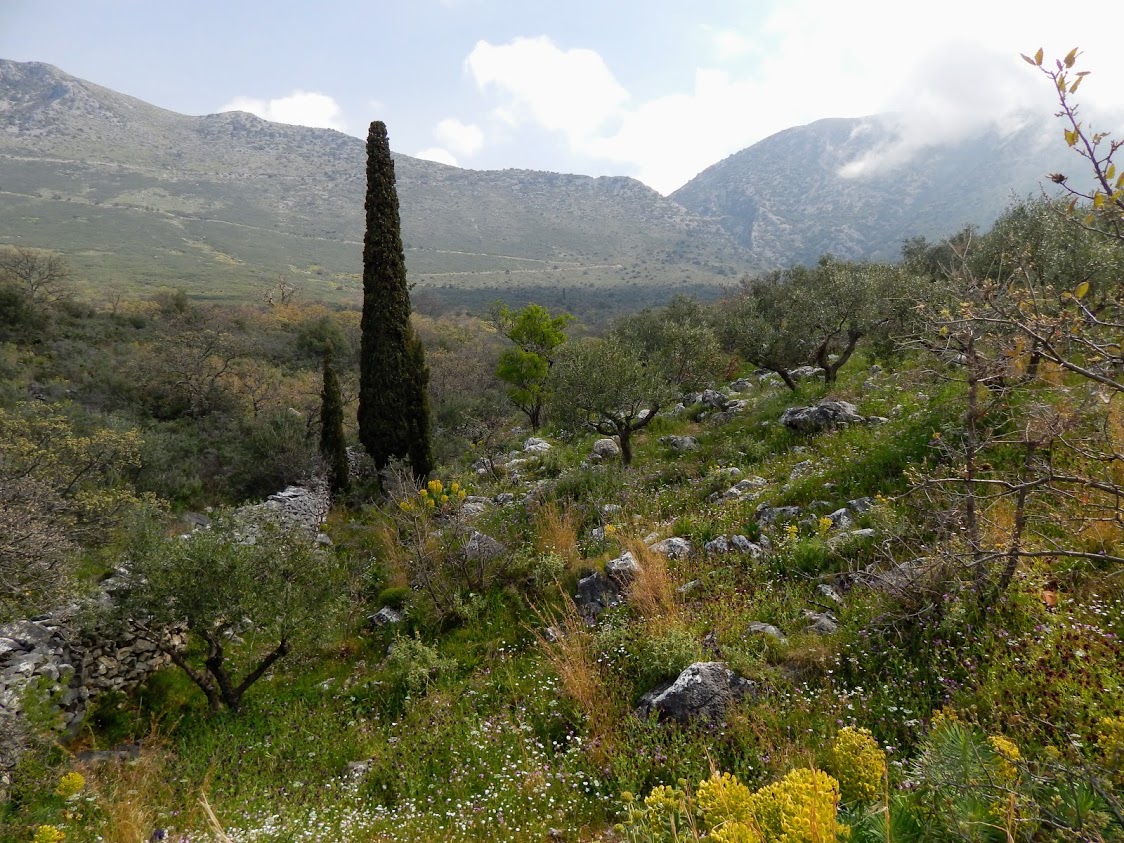
View across hillside olive groves
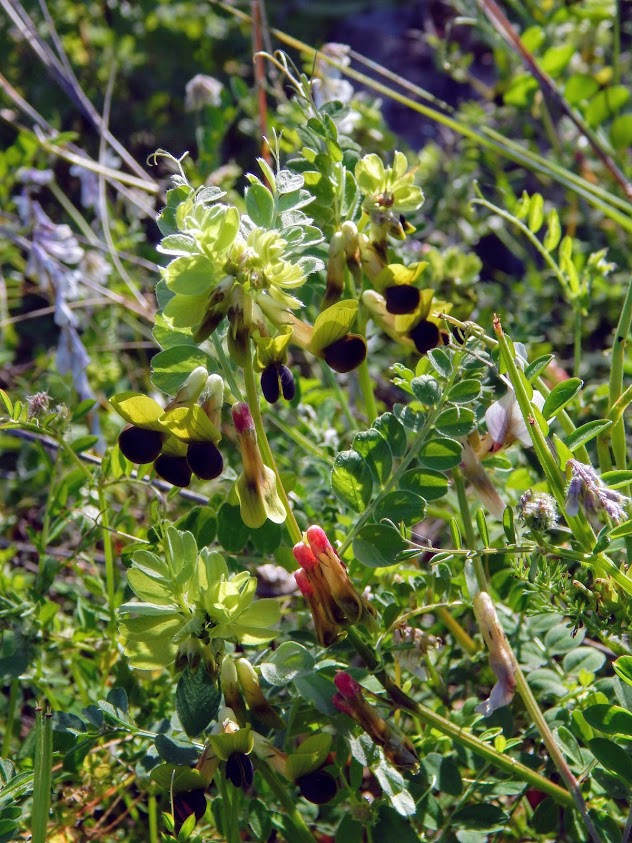
Vicia melanops
As we continued the drive down the Mani ‘finger’, the landscape gradually changed. The tower houses which are so distinctive of the region became more and more common. Large sections of shale and schists began to appear among the otherwise limestone dominated bedrock.
Our next stop was on an exposed, windy hillside overlooking the sea. We all tried to remain cautiously optimistic, as we had been told that this was a known site of Tulipa goulimyi, but that a visit earlier that week had not yielded any finds. After barely a minute the first tulip was spotted, and now that I knew what I was looking for I realised there were a number of the blindingly red flowers scattered about. They were in perfect shape and were undoubtedly the prettiest tulips I’ve ever seen. They were certainly T. goulimyi (and not the similar T. doerfleri) because of the distinctive curling leaves.
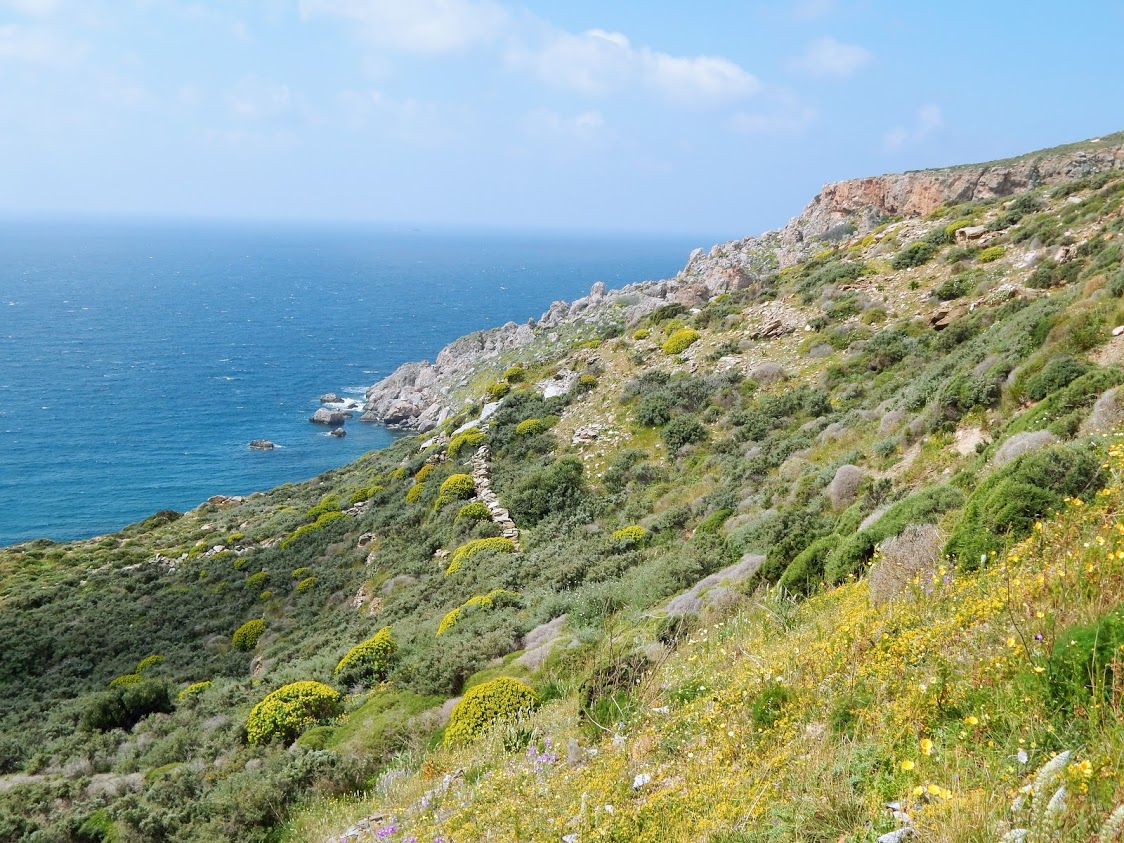
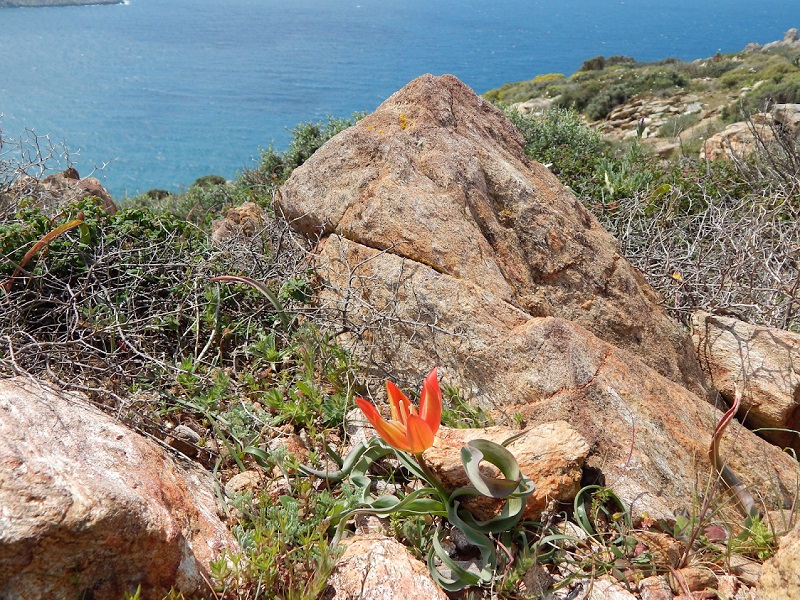
Tulipa goulimyi in phrygana habitat
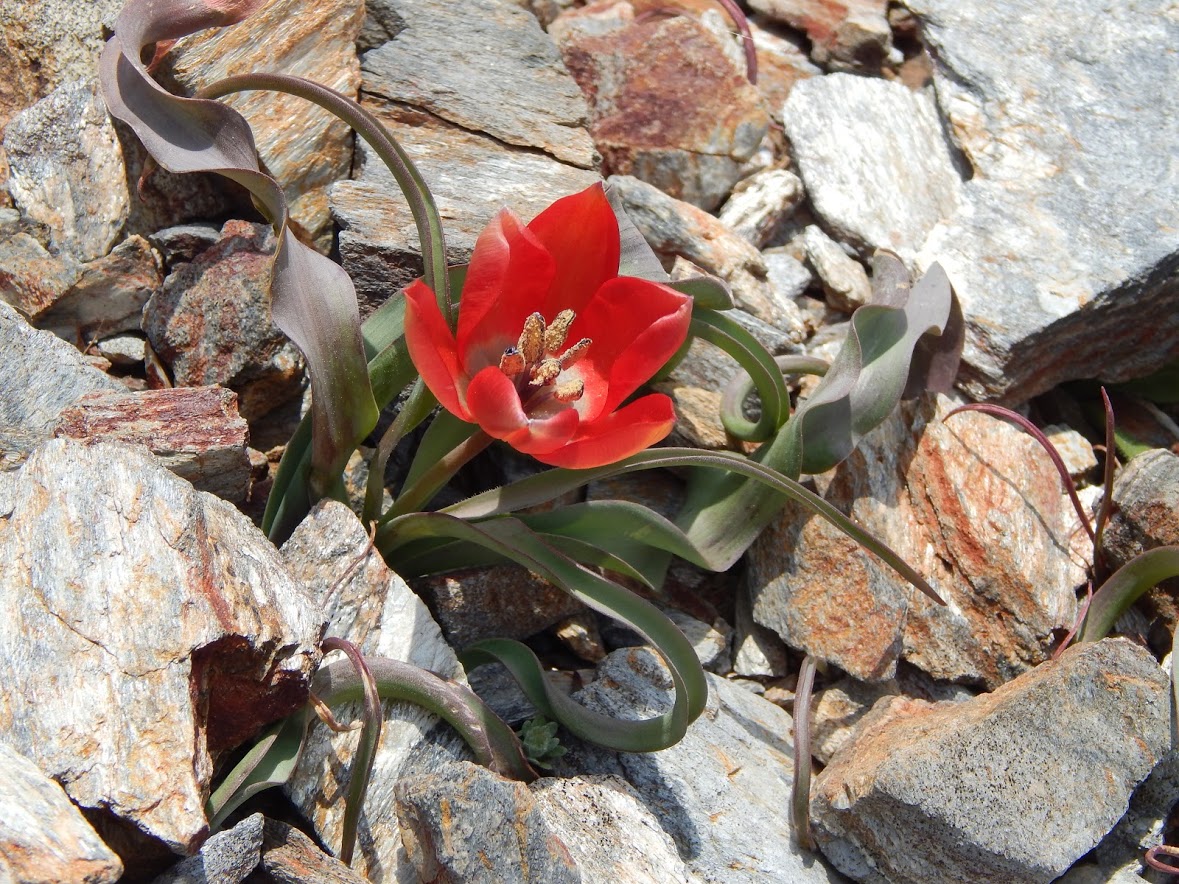
Tulipa goulimyi
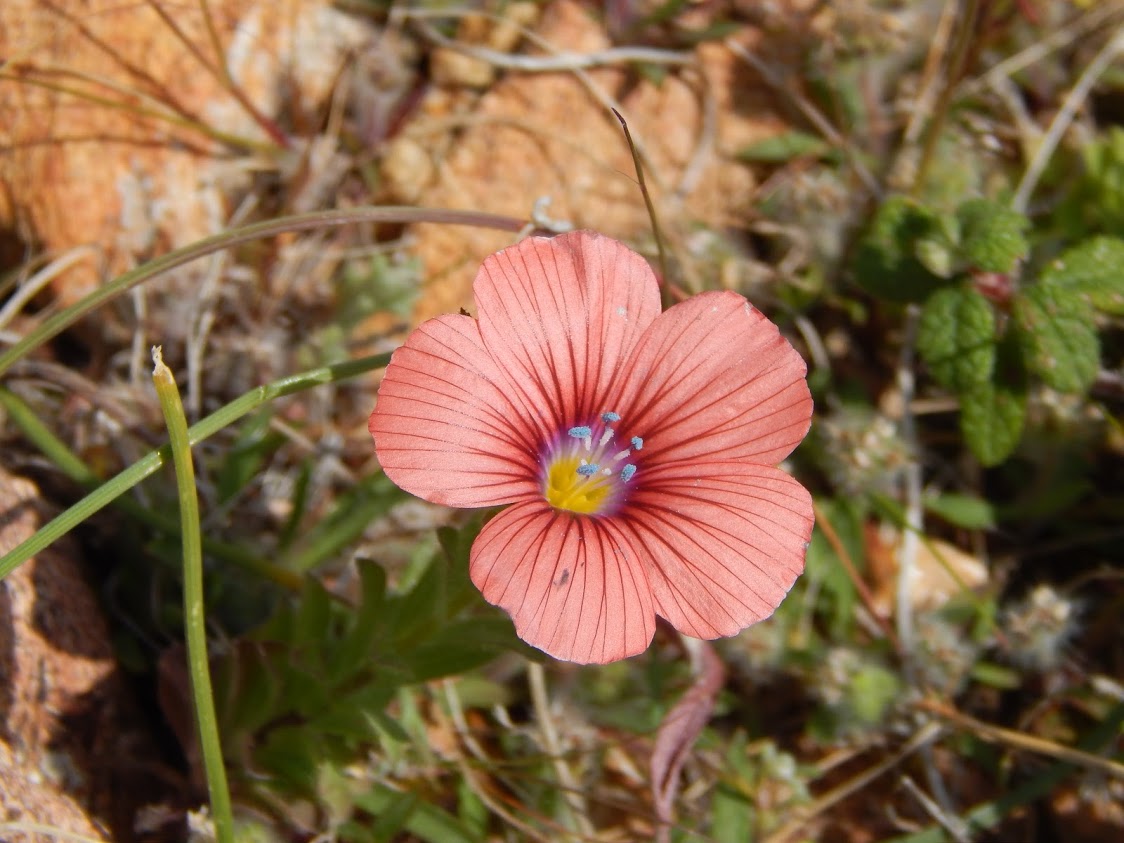
Linum pubescens
We found a number of other pretty flowers here which we had not seen before. I thought Linum pubescens was particularly beautiful – the petals were proximally purple merging to peach, with dark red radiating lines. The pollen, displayed clearly, was a contrasting light blue. An interesting pink flowered Silene was also found. John said it could be a local endemic and upon further research I believe it was S. integripetala subsp. greuteri which is indeed endemic to the southern Peloponnese. I also spotted my third muscari-like bulb in bloom – Leopoldia comosa. Unlike the previously encountered M. commutatum and B. dubia, the top of the inflorescence was adorned with bright purple flowers in an umbel type arrangement quite different from the lower flowers.
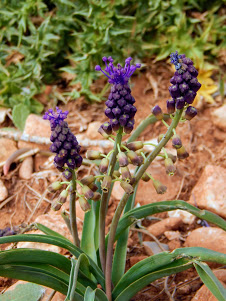
Leopoldia comosa
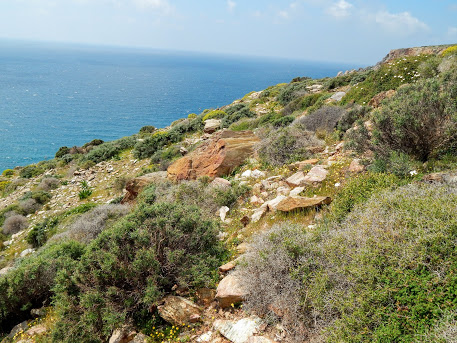
Biodiverse Cape Tenaro
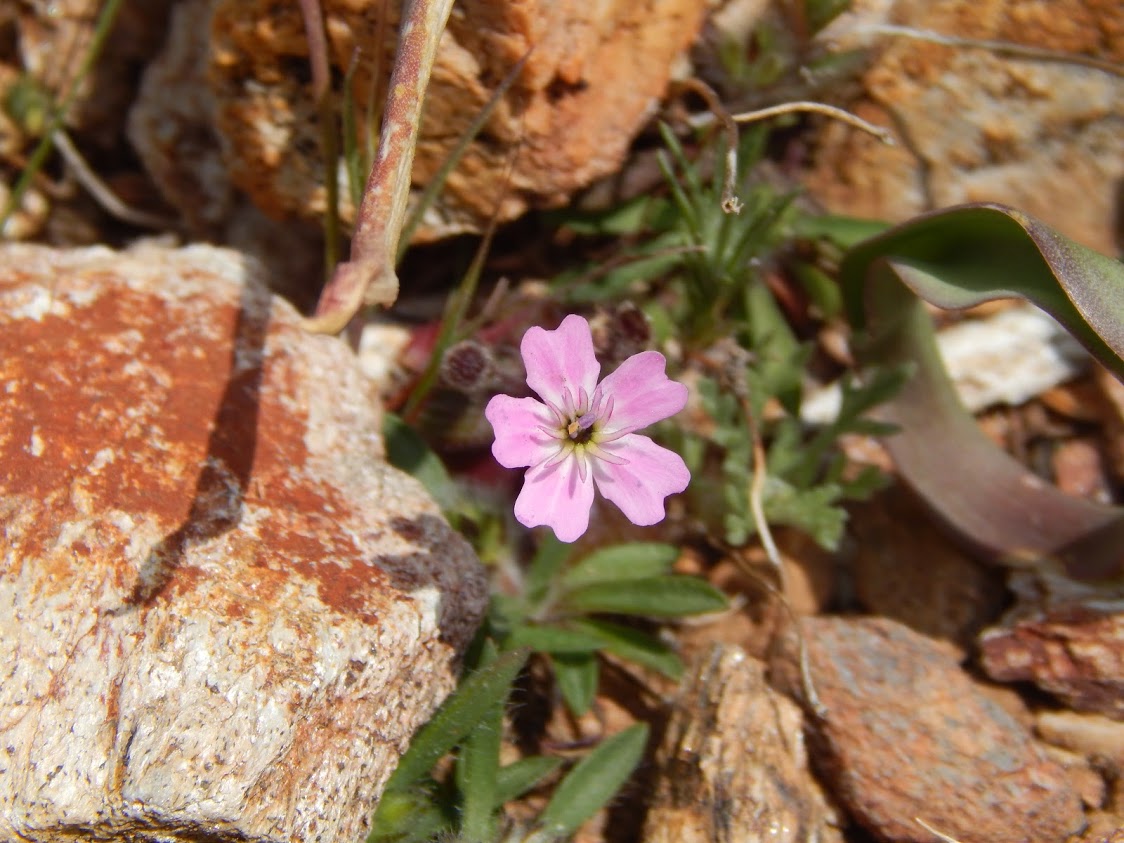
Silene integripetala subsp. greuteri
Finally, we reached Cape Tenaro. We made our way down to a set of ruins which harbored a Hellenistic mosaic. It was here we stopped for lunch, each of us pondering how we were going to spend our few hours at the southernmost tip of Europe. I decided to follow John to search for more tulips. After a few hundred meters we crossed over the top of a hill, and were greeted by dozens more T. goulimyi.
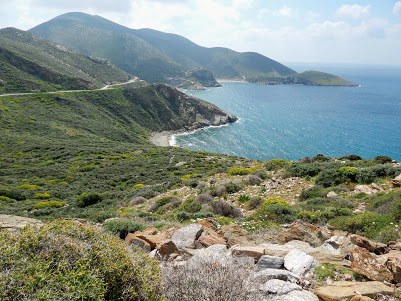
Spectacular Mani coastline
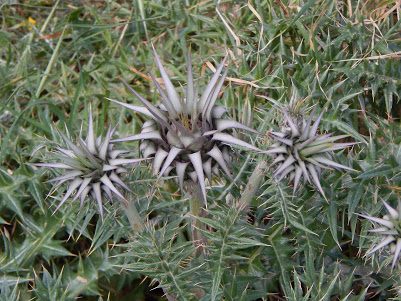
Cynara cornigera
There were also hundreds of Serapias orientalis nestled among the low growing shrubs and herbs, which seemed dominated by Cistus salvifolius. The thistle like Cynara cornigera was also abundant here, and only here among the sites we had visited. John also pointed out tiny wild olive ‘trees’ Olea europaea subsp. oleaster which were as low growing as the other shrubs. It was a very harsh habitat, with intense winds buffeting anything that dared grow tall.
On my way back towards the coach, I was informed that several others had found some orchids. Following their directions, I made my way to a small area near where we had picnicked which was dominated by grasses rather than shrubs. After a few minutes searching I found what I was looking for – a beautiful white flowered Anacamptis pyramidalis. Once the first had been found, the others seemed to reveal themselves to me. They were only just starting to come into bloom, which suited me just fine as it is at this stage the inflorescences take on the characteristic pyramidal shape which they are named for.
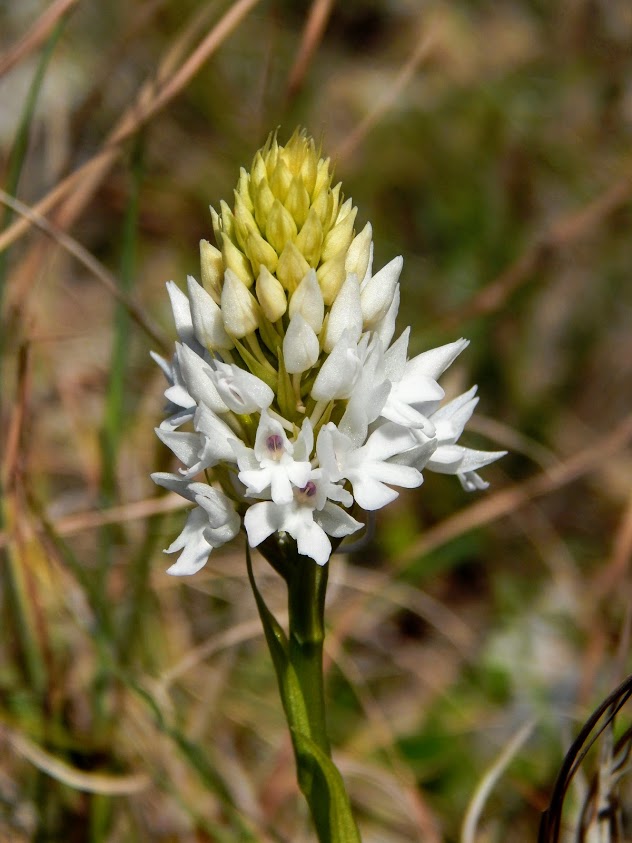
White Anacamptis pyramidalis
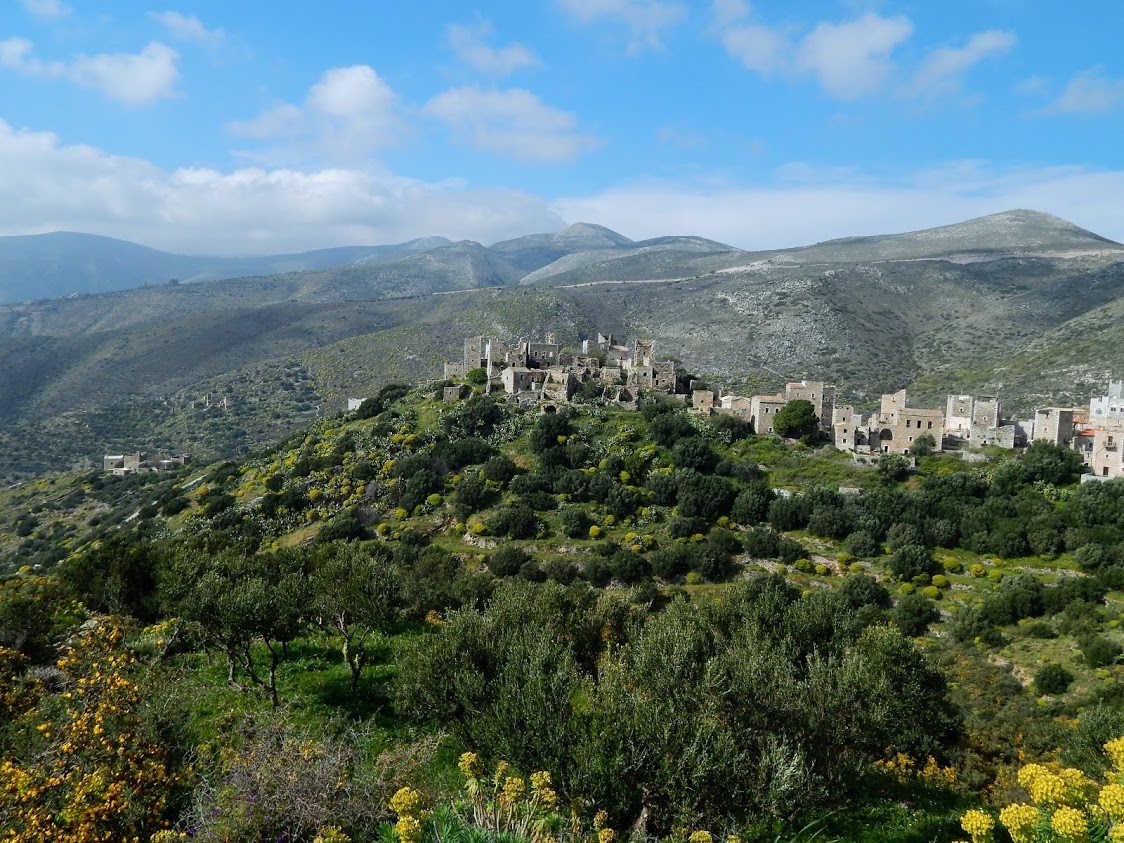
Village of Vatheia
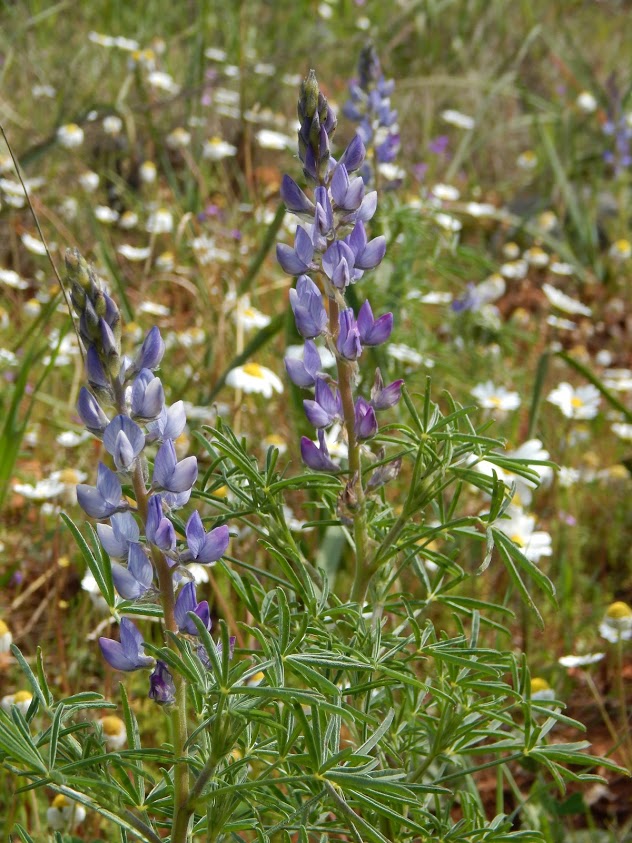
Lupinus angustifolius
After a bit more exploring and a coffee break, I met up with the others back at the coach. We boarded for the journey to our final destination of the day -the village of Vatheia. We were dropped off just beyond the town, where we had a spectacular view of the iconic tower houses and the surrounding landscape. John pointed out a lovely blue lupin in flower. The narrow leaves indicated that it was not the common lupin we are used to but in fact Lupinus angustifolius.
I also spotted O. sicula, O. tenthredinifera, and O. spruneri growing nearby. The special conditions of the inner Mani definitely seemed favourable for orchids.
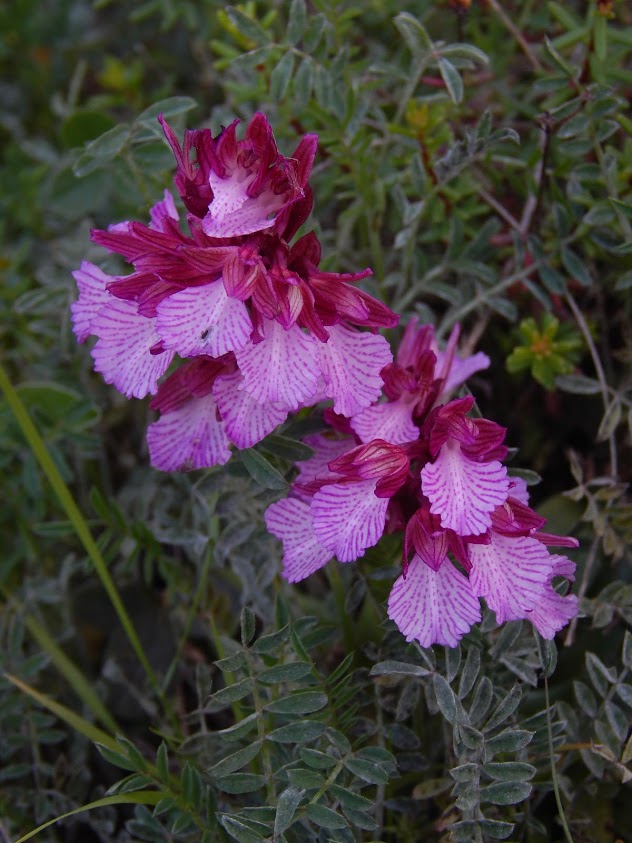
Wednesday 27 March
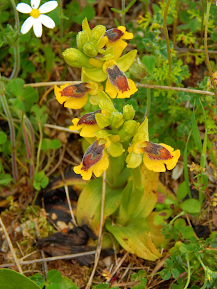
Ophrys lutea
This was our last day of botanising and despite a rather relaxed itinerary, it was a very productive day with excellent sites.
Our first stop was along the road leading to the same bakery as we had visited the day before, but the coach let us off a bit further than previously; about a mile away. We passed a pasture with several cows who didn’t seem to mind nosy plantspeople, then another with sheep and several sheepdogs who certainly did mind our botanising – they let us know quite clearly we should leave the flowers in their field alone.
My favourite find of the stop was (of course) a new orchid species spotted by Imran – Ophrys lutea. This species looks very similar too and is indeed very closely related to the frequently encountered O. sicula. The differences were clear however – the flowers were much larger and more numerous.
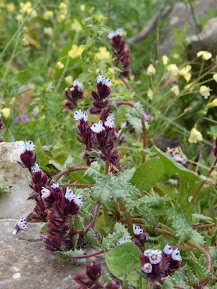
Anchusella variegata
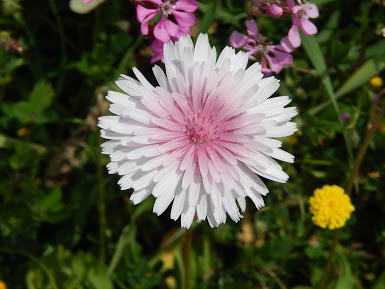
Crepis rubra
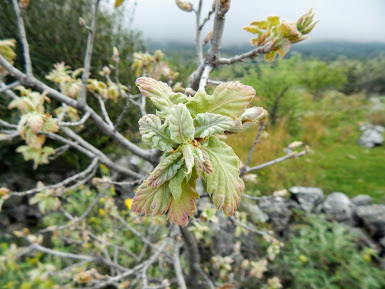
Quercus ithaburensis subsp. macrolepis
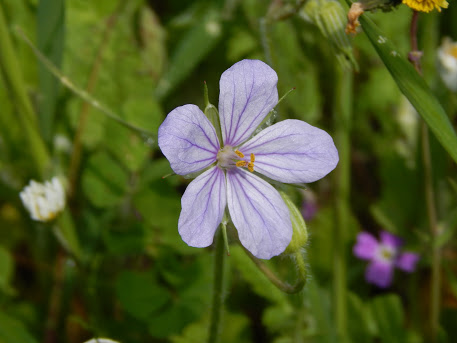
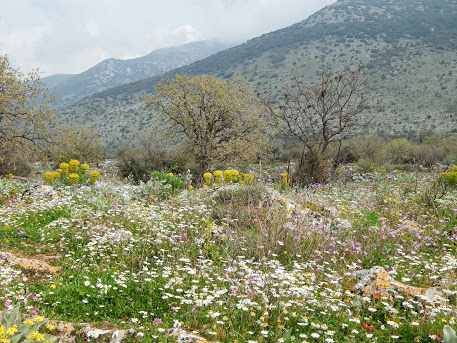
Carpet of wildflowers
I noticed a number of rather small plants which I had missed the first time we were at this site – Anchusella variegata with its white spotted leaves and pink spotted flowers and Erodium gruinum with lovely violet flowers. Crepis rubra were just starting to open their gorgeous pink fading to white flowerheads, each plant only bearing one or two. A number of beautiful Quercus ithaburensis subsp. macrolepis were putting out new leaves here, but we noticed that there were a few leaves remaining from the previous year. The climate must be mild enough here that the trees are nearly evergreen. This site highlighted a theme that had been present throughout the trip – the astonishing diversity of roadside verges. I have encountered the phenomenon in other parts of the world, including the UK, but nothing as incredibly biodiverse as we saw in rural parts of the Peloponnese.
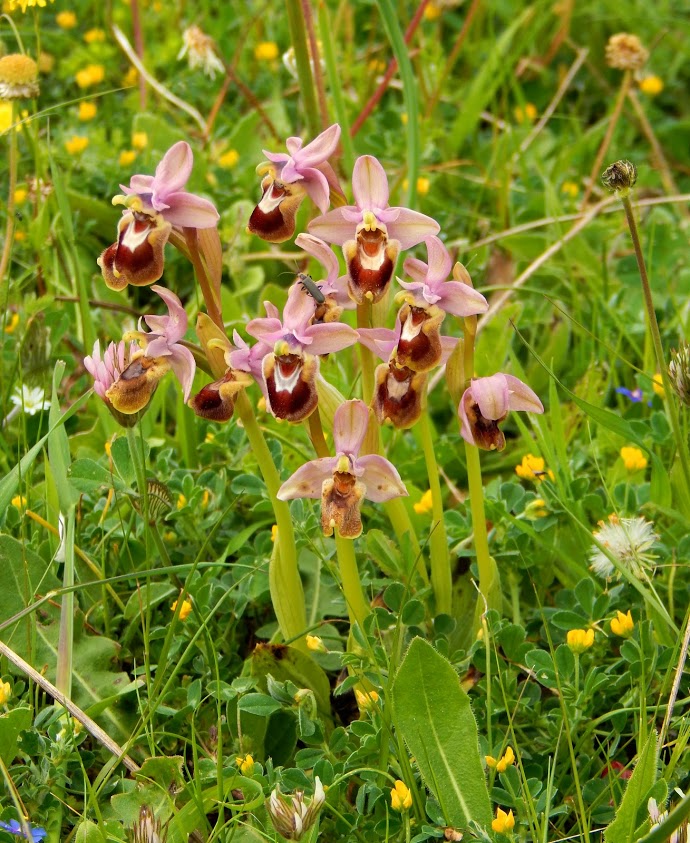
Ophrys tenthredinifera subsp. leochroma
The next stop was also on the side of a main road, just south of Platsa, but with opportunities to explore a number of trails extending into the wild hillsides. I spent a considerable amount of time on the side of the road though, as it featured a dry meadow flora which was clearly very favorable for Ophrys. Although there were no new species for the trip, the density of orchids and orchid species was absolutely amazing. I counted at least four species but there may have been more – the variation in lip patterns was great and made identification a bit of a challenge. After a while I was told that some others had found an even more prolific orchid meadow and I hurried to it. There were so many it was necessary to take very carefully calculated steps to avoid treading on them. Everyone was in awe – the orchids were just as numerous as the annual Silene colorata. Aside from the hundreds of orchids, there were also stunning Anenome coronaria with flowers in an unusual light shade of purple-blue.
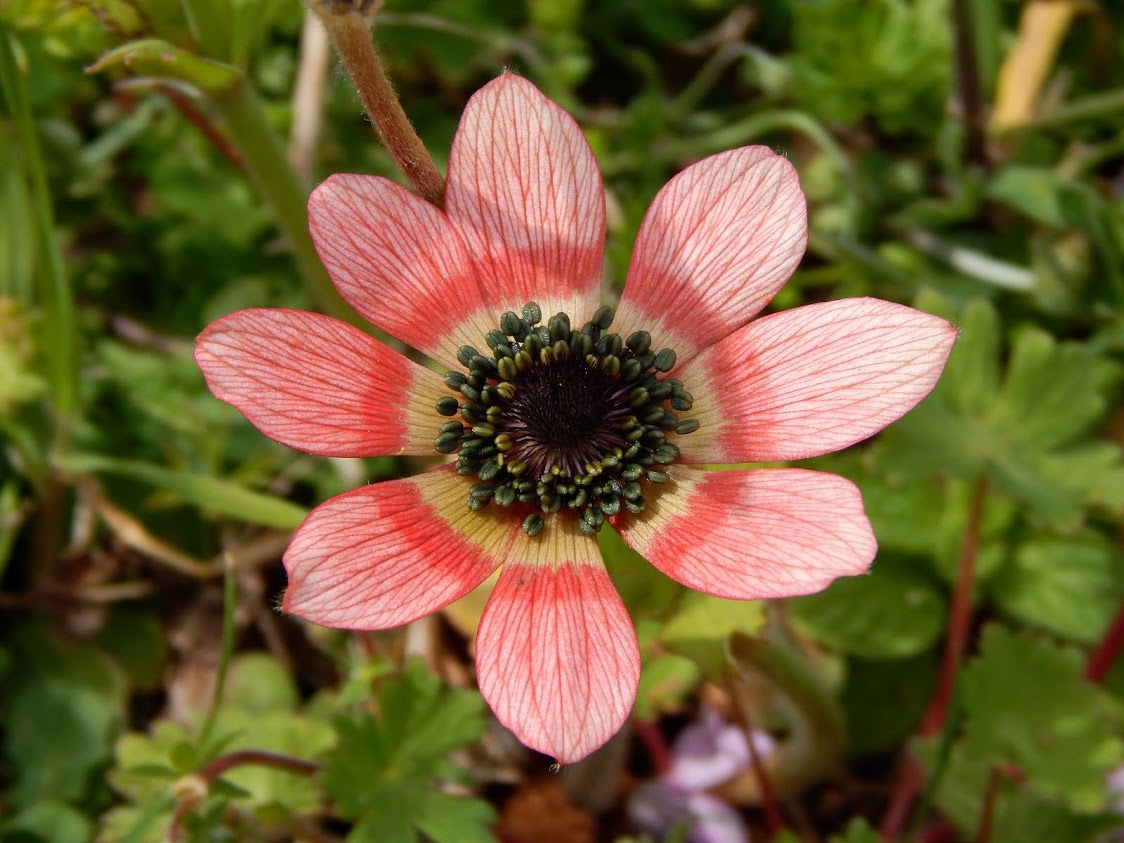
Beautifully patterned Anemone
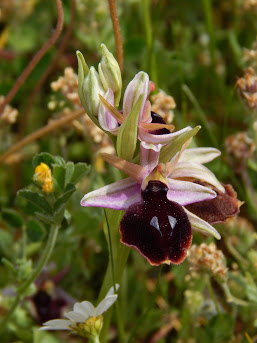
Ophrys spuneri x argolica
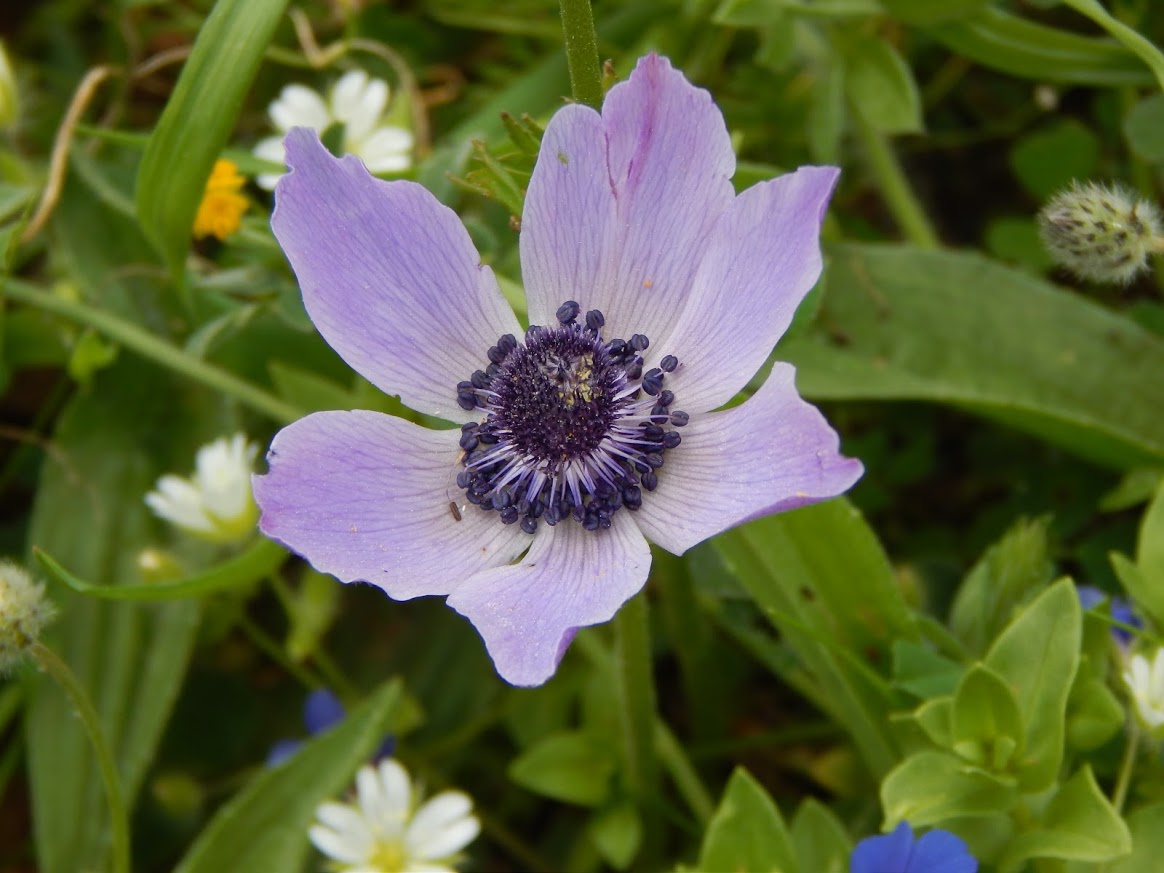
Anemone coronaria
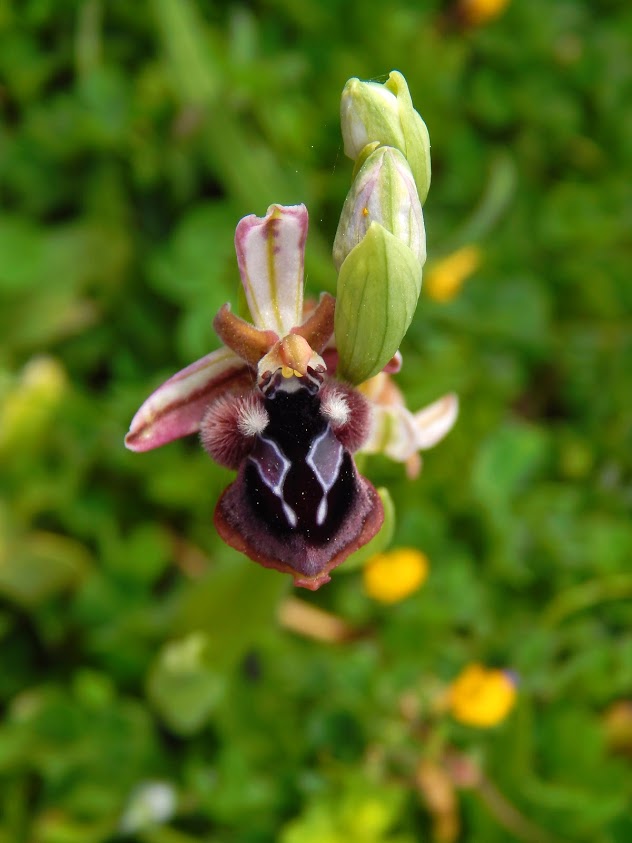
Ophrys (preumably) reinholdii
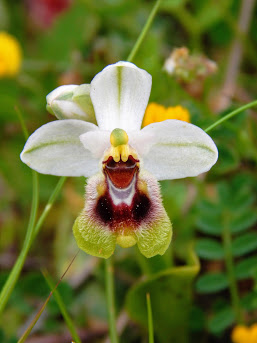
Colouor variant Ophrys tenthredinifera
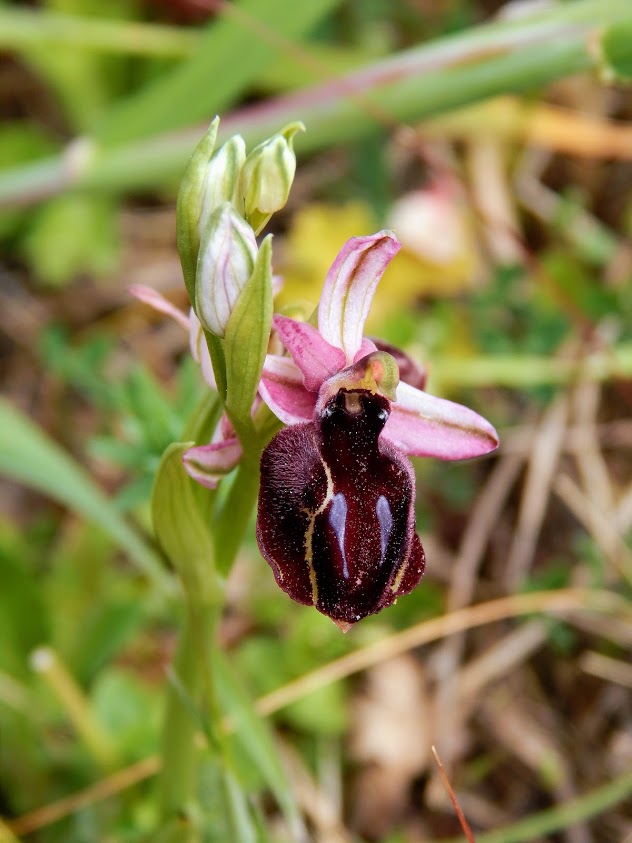
Ophrys spruneri x ferrum-equinum
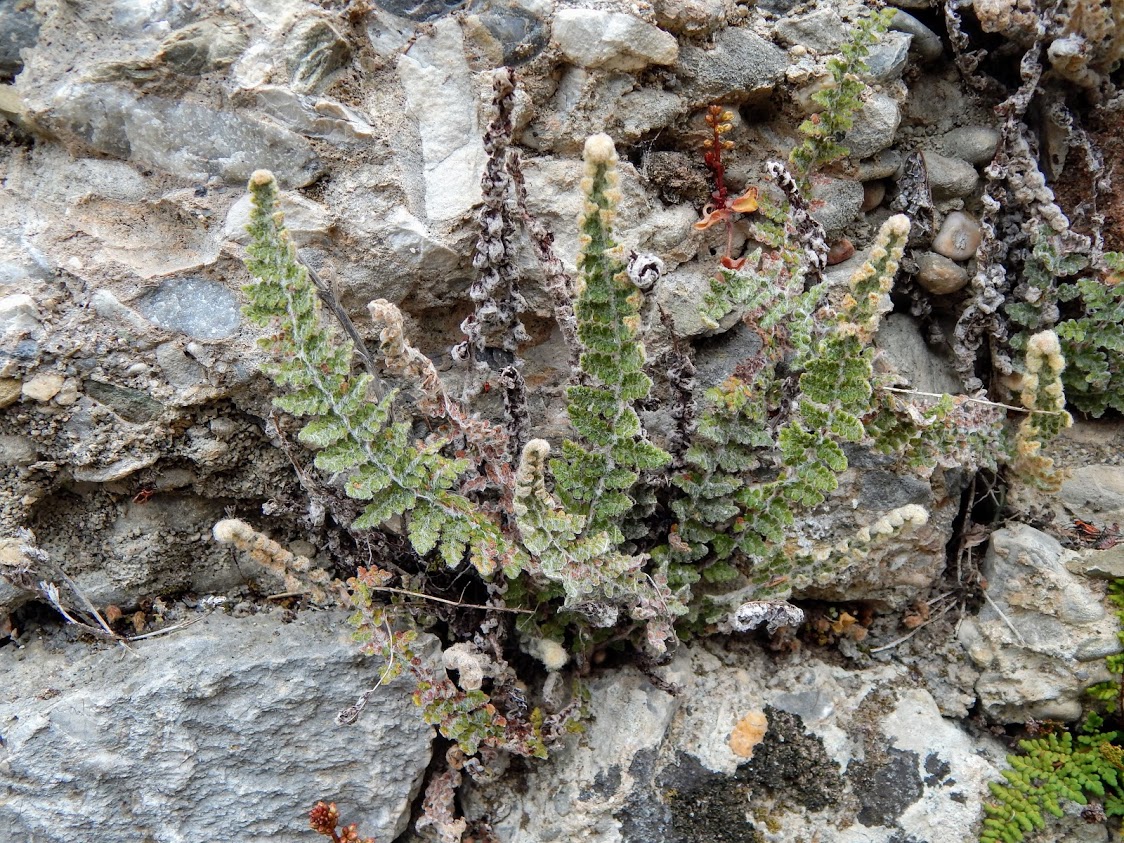
Cosentinia vellea
We returned to Kardamyli rather early in the afternoon to allow participants to pack, buy postcards, and relax before the upcoming day of travel. There was of course an ‘optional’ garden walk, led by Katerina through the streets of Kardamyli. The first half of the walk allowed us to admire local household gardens, which we all envied for their ability to grow things which would require protection in the UK.
My favorites were a stately Grevillia sp. and the tiny, sprawling Persicaria capitata along walls and stone steps.
I was a bit distracted by the local cats as we walked through the streets, stopping to pet those which allowed me to come close.
As we left the bustle of the town centre and made our way towards old Kardamyli, native species began to replace garden varieties. We spotted more of the unusual Thalictrum orientale in the rock faces surrounding the restored towers. I found a beautiful fern which was a first for the trip – Cosentinia vellea. Like other ferns in the related genus Cheilanthes, this species is adapted to warm, rocky, dry habitats. It does so by a combination of growing in the relatively moist microclimate of shady rock crevices, an ability to desiccate in times of low precipitation, and dense trichomes which give the fronds a fuzzy feel while lowering the rate of water loss. It is a beautiful fern and a spectacular last find of the trip.
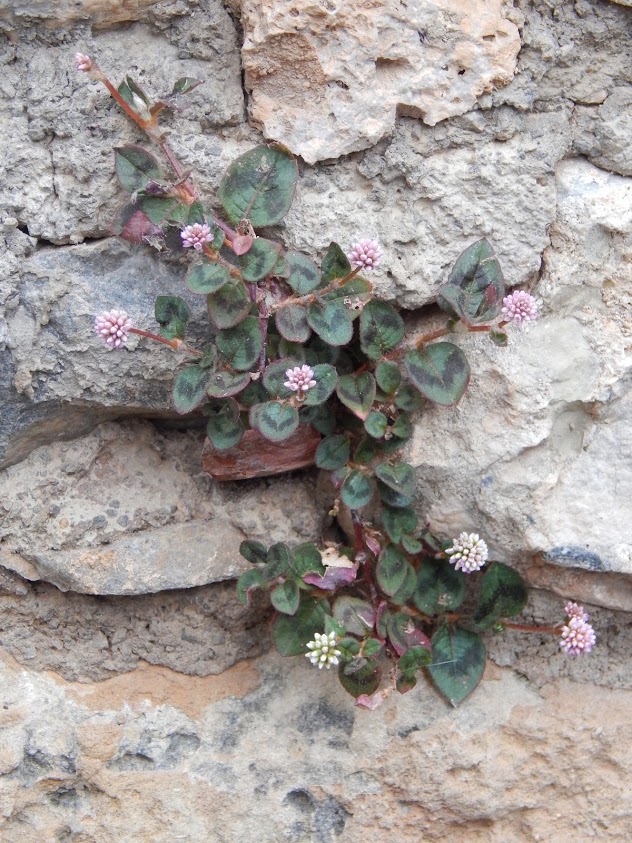
Persicaria capitata
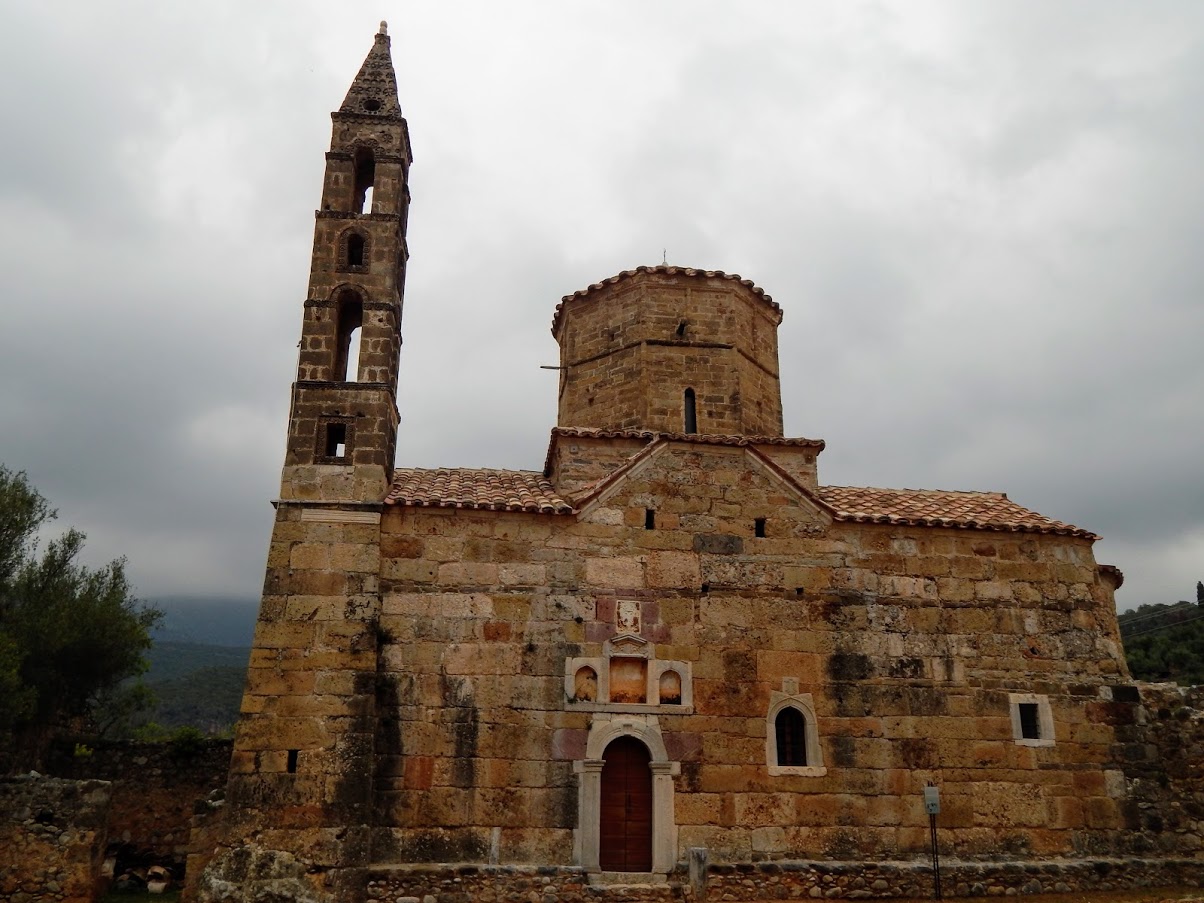
Church in old Kardamili
Acknowledgements
I would like to thank the MPG Bursary Committee for giving me this unique and extraordinary opportunity to explore and learn about the flora of the Peloponnese, which would not have been possible without their help.
Maddy and Geoff Hughes also deserve a huge thank you for planning such a flawless trip and being the best hosts imaginable. I would also like to thank John Fielding for sharing his vast knowledge with such generosity.
Finally, I want to thank the other tour participants. The entire experience was enhanced by being in the company of such kind, knowledgeable, and enthusiastic people.
I have learned so much and my love for Mediterranean plants and ecosystems is stronger than ever.

